Australian
and international
exploratory
performance and
media arts
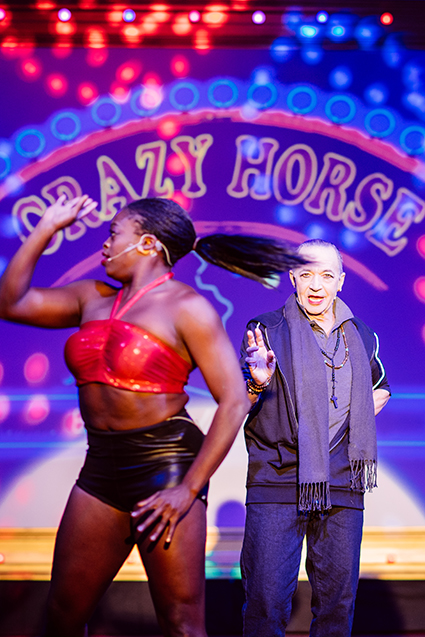
Kialea-Nadine Williams, Trevor Stuart, Madame, Torque Show in association with Vitalstatistix & State Theatre Company of SA
photo Ben McGee
Kialea-Nadine Williams, Trevor Stuart, Madame, Torque Show in association with Vitalstatistix & State Theatre Company of SA
Few visitors to or residents of Adelaide would not profess some passing knowledge of Hindley Street’s Crazy Horse, a fixture of the city’s adult entertainment scene since the venue’s opening in 1979. Its website, perhaps unwittingly, suggests the rapid evolution from chintzy, stage-based variety to the pornified intimacy of tabletop dancing that is one of the strands of a new play, Madame: The Story of Joseph Farrugia, stating “The club combines the lavish cabaret of Parisian strip club ‘The Crazy Horse’ with the full-throttle eroticism of London’s Revue Bar.”
Initially intending to make a show about the strip industry, Torque Show Creative Director Ross Ganf—“fascinated,” according to his program notes, “by the sale of fantasy as a theatrical conceit between a client and a dancer”—became instead drawn to the biography of a single industry figure, Joseph Farrugia, who was installed as Crazy Horse’s choreographer in 1981, and remained its owner until the venue’s sale in March this year. Ganf interviewed Farrugia over a period of four years and the resultant show splices together the conventions of verbatim performance with those of dance-theatre. The work is deepened, not unproblematically, by the incorporation of the shifting vocabularies of strip club performance.
Performers Chris Scherer and Trevor Stuart represent two iterations of Joseph: Scherer the young, somewhat delinquent Nasser regime refugee and schoolboy and Stuart the counter-intuitively sagacious strip club proprietor. Kialea-Nadine Williams embodies Madame Josephine, Farrugia’s commanding and lascivious onstage alter ego. This, however, is rather too simply put—all the identities here are unstable, each subtly framed as emanating from Farrugia’s memory, ego and fluid desires and sense of self. Naturalistic exposition is destabilised by exaggerated gestures and the mouthing of dialogue being spoken by other performers. Scherer and Williams are superb: physically and vocally adept in roles that are demanding in both departments. Stuart’s stage presence is a warm and engaging one, although a certain under-confidence marred his opening night performance.
The show weaves together poignant aspects of Farrugia’s life—his tempestuous relationship with boyfriend Jim, a wounding court case revolving around his relationship with surrogate son Blake—and commendably uneditorialised vignettes that expose the moral grey areas of the strip industry. The most startling of these twins the revelation that a simulated rape scene was performed at Crazy Horse in the 1980s with an unsettling monologue by Williams that draws attention to the aggression and predation faced by, especially, gay and female adult entertainers.
The Burnside Ballroom, with its well-preserved 1950s aesthetic, makes for an appropriately stylish canvas for Geoff Cobham’s showbiz-inflected design, gold foil strips hanging from the ceiling, projections of photographs and sequined curtains, haloed by dressing room lights, shimmering amid cabaret-style seating. The work culminates, perhaps inevitably, in the three performers lip-synching to “My Way,” that ineffably camp, strangely peerless anthem of uncorrupted individualism. “And now,” the song goes, “as tears subside, I find it all so amusing.” As I look back I see the real Joseph Farrugia in the audience. He’s smiling.
Torque Show, Vitalstatistix and State Theatre Company of SA, Madame, creator-directors Ross Ganf, Ingrid Weisfelt, Vincent Crowley, text Joshua Tyler, Ross Ganf, Roslyn Oades, dramaturgy Joshua Tyler, set and lighting Geoff Cobham, sound Luke Smiles/motion laboratories; Burnside Ballroom, Adelaide, 21 April–2 May
RealTime issue #127 June-July 2015 pg. 42
© Ben Brooker; for permission to reproduce apply to realtime@realtimearts.net
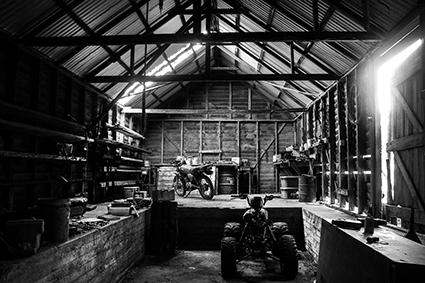
Jack’s Shed, Acoustic Life of Sheds, Tasmanian International Arts Festival
photo Lisa Garland
Jack’s Shed, Acoustic Life of Sheds, Tasmanian International Arts Festival
Circling the milling crowd on a far flung Tasmanian farm is a series of hand built electronic harps amplifying the sound of wind on the strings and creating an intriguing late-afternoon atmosphere. As we are let into the somewhat prosaic tin shed we’re greeted by an unexpected wall of smoke. Three formally dressed players emerge from it on the raised shearing floor and the composition begins with the breathy, loose sounds of Phil Slater on trumpet accompanied by unearthly contrabass recorder played by Genevieve Lacey, its low, fluttering emanation sitting somewhere between whale song and the growl of a beast. Gradually, harpist Marshall McGuire joins the mix. We are participating in Acoustic Life of Sheds.
Part of the Tasmanian International Arts Festival, the production involves established and emerging composers, improvisers, instrumentalists and visual artists working in five sheds across the North West Coast of Tasmania, between Wynyard and Stanley. The project had a long lead-in, with commissioned artists building a visual and harmonic familiarity with selected sites throughout the year prior. In each case, there is a sense that the spirit of the shed, its key protagonists, or the nature of sheds per se, has crept into the work.
We start our journey at a quirky shed on the coast east of Wynyard. Comprising a built collage of ex-prison block and a series of workers huts, this is Bruce’s Shed. The amateur museologist brought these buildings together in order to display his curious collection of items reflecting local history, zoology and his own life. For his live, sonic installation composer Damien Barbeler’s inspiration has sprung from Bruce’s childlike sense of adventure and curiosity, placing players and digital mixing equipment like exhibits within side rooms, while we stand clustered within the central, stone-flagged corridor. Initially in darkness, we are sporadically lit via a ceiling of white balloons that conceal a lighting system linked to the work’s ebbs and flows. The composition uses the instruments to make sampled textural sounds, originating from plucking or scraping on strings, layered against longer bowed notes. “It doesn’t sound like music,” says a young audience member.
The third shed is part of a tiny village of buildings spanning the Table Cape road. Here we meet Jack Archer via his recorded voice, his sheepdog whistles, his sheds, his objects. He is also present as a portrait, taken by local artist Lisa Garland; printed onto thin fabric it ripples in the breeze as Jack ‘overlooks’ performers Madeleine Flynn and Tim Humphrey. The pair, using sampled and live sounds from a ruined piano and a flugelhorn are literally playing in this mechanics shed. They work their way through a series of short pieces that take their lead from Jack’s reputation as a sheep dog trainer. They tinker with sound, mess with the piano’s tuning and speak casually to the audience of their process.
The day-long experience concludes with a three-piece ensemble led by renowned recorder player Genevieve Lacey. She asked the family of Blackridge Farm to keep handheld sound recorders with them over a number of weeks so she could use the recordings to imbibe the life of the farm from a distance: “we eavesdropped on feed runs, overheard quiet, meandering chats and shared jokes, gates and tractors, shearing sessions, pigs being born, birds by the creek”.
The work is in two parts, the first, outside, is provided by an Aeolian harp-fence. The second, by Lacey, for trumpet and harp, brings the shed into the work by wiring it with surface exciters such that every vibration becomes a sound layer. The composition is a contemplative, atmospheric improvisation on the sound diary, full of long, wavering notes that feel in equal part of this place and out of place. Tiny local noises find their way into the work, such as a bird that Lacey memorably mimics with her tiny sopranino recorder.
Acoustic Life of Sheds was a compelling and enjoyable journey of discovery within spaces that usually remain the domain of their owners. The calibre of performers cast for each site made for unique experiences that ranged from the congruent, such as Lucky Oceans improvising country riffs on pedal steel in the filtered light of a shearing shed, to the incongruent—Lacey losing herself in a contrabass recorder. The most successful moments were those where the performers really engaged with the ad hoc spirit of tinkering and ingenuity that is inextricably linked to the Australian shed.
Weeks after the performances and country driving, I still find myself wondering about sheds I pass—what artefacts sit exposed, what they sound like, what the quality of light is from inside the smeary glass?
Tasmanian International Festival of Arts, Big hART Inc; Big hART, Creative Director Scott Rankin, Creative Producer Andrew Viney; Tasmania, 21, 22, 28, 29 March
RealTime issue #127 June-July 2015 pg. 28
© Judith Abell; for permission to reproduce apply to realtime@realtimearts.net
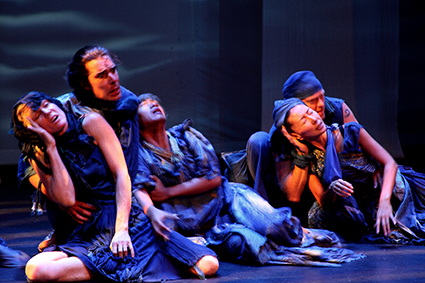
This Fleeting World, Centre for Australasian Theatre
photo Rosie Browning
This Fleeting World, Centre for Australasian Theatre
Living in the deep north of Queensland there’s a heightened feeling of transience, of nature, weather and people constantly on the move. It’s a microcosm of the larger urban demographic but with a sense of community amplified by cultural tourism, which accounts for 80% of the economic equation and the influx of millions of travellers into the region. The uninitiated pursue experience and adventure, while the boomerang of return visitors and peoples to home and country interchanges with life-stylers seeking sea/tree change and migrants hoping for a better way.
Like an estuary tide, this human motion underpins the core of the Centre for Australasian Theatre’s This Fleeting World. The work questions what it means to sense, to feel, to grapple, to be flesh of this earth, if only for a moment. Intertwining an episodic journey with intercultural physical theatre and existential vignettes, the work harnesses a raft of creatives to undertake immersive meditations on the pilgrimage of shared human existence in a transient world.
On entering the work I receive a glossy A4 program revealing a delightful map of “this fleeting world showing the journey” accompanied by a legend of 15 scenes depicting a melting pot of pilgrims undertaking “a journey for their soul rather than their identity.” Piano and percussion are oriented to the right side of the audience who are seated facing the seven performers. The work unfolds over 80 minutes as the performers traverse three basic human behaviours—attraction, repulsion and indifference via the legend’s “home…fields…summit”—on a visceral quest to reach a plateau of mutual acceptance.
This Fleeting World is inspired by the discovery by director Willem Brugman of a prayer hidden in a small, rice paper Buddhist Heart Sutra booklet. With dramaturg Catherine Hassall, the director and performers have composed a poetic treatment for the work using Asian-inclined somatic performance training techniques. The resulting “transmogrifications of being” channel an expressionistic stream of consciousness that would rival Linda Blair’s performance in the 70s film The Exorcist.
The work doesn’t suffer the blank faces of some contemporary dance, nor is it a work of sparse minimalism. The large-scale projected paintings of country by Mavis Ngallametta from Aurukun and potted cultural interjections from the players interact with Linda Jackson’s fluid indigo costumes, to provide an undulating hippie gothic vibe, that won some converts. As one of the audience commented, “not your average primate.”
Built through a two-year development, This Fleeting World had a work-in-progress showing last year, and while the ensemble is relatively new, it’s encouraging to see members maturing and increasingly coming to terms with the movement/text relationship and poetics that populate the work. Much of each performer’s background is invested in the work, the diversity lending itself to the cause and highlighting cultural complexities—those moments where people fumble to communicate, where things are lost in translation, teetering on the edge of misinterpretation, misrecognition and quasi comprehension. The clarity of movement of Eko Supriyanto from Java and Aboriginal Australian Warren Clements contrasted with the rambling utterances and gesticulating of a crouching cluster of performers questing to understand, acknowledge and empathise.
While strengths and weaknesses were evident, This Fleeting World pinpoints the skill, interpretive ability and cultural contribution of each collaborator. The mix of artists—indigenous, non-indigenous and culturally diverse—is reminiscent of the ethos that our community is our theatre company.
Centre for Australasian Theatre, This Fleeting World, director Willem Brugman, dramaturg Catherine Hassall, costumes Linda Jackson, set design Guy & Gina Allain, painting Mavis Ngallametta, ensemble Warren Clements, James Daley, Piers Freeman, Zelda Grimshaw, Catherine Hassall, Dobi Kidu, Miyako Masaki, Lou van Rikxoort, Nasser Selimi, Eko Supriyanto; Centre of Contemporary Arts Cairns, 16-25 April
RealTime issue #127 June-July 2015 pg. 33
© Rebecca Youdell; for permission to reproduce apply to realtime@realtimearts.net
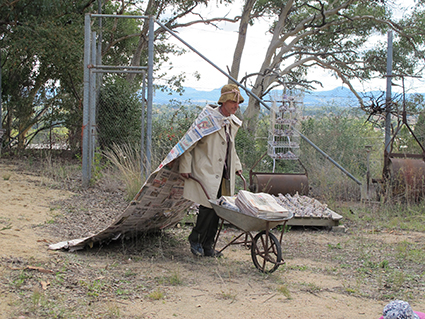
Alan Schacher, Behemoth*, Cementa 15
photo Wei Zen Ho
Alan Schacher, Behemoth*, Cementa 15
Cementa is part of an expanding ecology of Australian arts festivals situated in and responding to regional living. Based in Kandos in the picturesque landscape of mid-western NSW, the program of the biennale festival’s sophomore year was largely driven by situating artists in the post-industrial town for short residencies and presenting their finished works over a four-day public event.
The Support
Alex Wisser’s The Support was a daily performance in which, acting as a human plinth, the festival co-director stood holding works made by Cementa artists. In one performance he held a styrofoam box, one of a number that constituted Fiona Davies’ installation Blood on silk, price taker price maker. Before him was a wall of identical boxes which, it was suggested, contained human blood and plasma and emitted a frantic audio recording of an auction. For an hour, eyes fixed directly before him and stoic as possible, arms outstretched, box in the palms of his hands, Wisser appeared to embody the struggle that the individual faces to effect change in a capitalist economy. He was not performing a perfunctory or ornamental task subordinate to the work, but actively sharing in it. The daily performances also gently reminded us of Wisser’s provision of curatorial and directorial support.
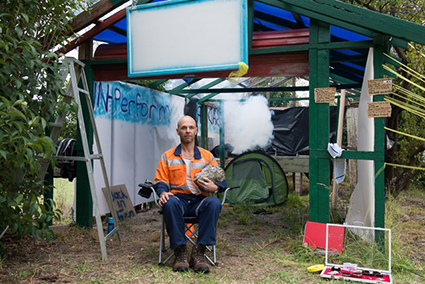
Alex Wisser, The Support
photo courtesy Cementa 2015
Alex Wisser, The Support
The Ministry for the Future of Art
Artist Nola Farman took similar interest in repositioning what is typically supplementary to the visual art experience, the wall caption or plaque that identifies a work of art in a gallery. Farman’s The Ministry for the Future of Art exhibited a new art movement, “neo-sisyphisianism (neo-potentialism),” curated by Chief Minister Dr Permangelo E. Regularis. We are told the curator cannot be present in person because he is on an overseas sojourn with colleague Fernando Pessoa (Portugal, 1888-1935), inventor of the literary concept of the ‘heteronym,’ an imaginary character created for different stylistic outputs. Indeed all the artists featured are Farman heteronyms through whom she operates individual identities, histories and practices. Her plaques, with their biographies and project descriptions, are displayed in a Kandos garage as art objects in their own right. They lack the subtlety of a convincing ruse, but nevertheless create enticing narrative speculations in which rather ridiculous works are realised in the readers’ imagination. Farman is looking to sell these pieces on the art market (through Dr Regularis), hoping to repudiate the commodification of artists and artworks. Perhaps more interesting is the overt attempt to sell works that only take shape in subjective speculation.
The configuration of yesterday
Filming a volunteer she met at the Kandos Museum and dividing the 40-second film, at twenty-five frames per second, into 1,000 images on numbered postcards, Leahlani Johnson disrupted the people of Kandos’ sense of a linear history. Functional objects, postcards of a moment of movement, suggest much as they are isolated in further moments, dispersed and picked up at numerous points around Kandos and poignantly journeying beyond their place of origin. The postcards’ travelling reflects the individuals who carry them, in the way that history is always carried with us, despite how fragmented and removed it might feel.
The sense of the filmed movement of ‘Helen,’ the volunteer coming into shot and sitting at the entrance of Kandos Museum to knit while waiting for visitors to arrive, is no longer detectable now that the postcards have been dispersed. But this example of everyday history will linger in the distance, fragmented and swirling around town as it continues to travel with visitors and locals.
Childsplay
A bolder confrontation with Kandos’ history took the form of a hopscotch game on squares spray-painted by artist Blak Douglas on strips of pavement in public spaces throughout the town, including the Aboriginal Community Centre. Each colourful arrangement alluded to the Indigenous history of Kandos, including place names and references to massacres. Colours and a readymade play-form enticed an engagement with the hidden history of place, in Kandos and in Australia more generally. Playing became a negotiation with history by inspiring children and adults alike to question their knowledge or ignorance of the information evident in each hopscotch square—both on and about the land it was on.
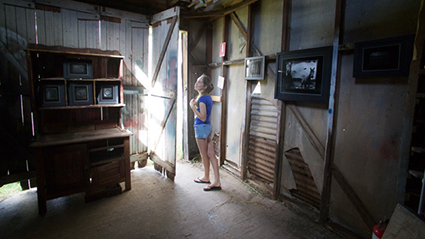
Cementa 2015
photo courtesy Cementa
Cementa 2015
The District
The District by Karen Therese and Province took the form of a public conversation over tea and biscuits in the Kandos Community Centre. Rather than attempting to represent the community, The District simply created an ever-so-lightly formalised space for locals to enter into public dialogue on their own terms about what interested and mattered to them. This was done through an ever-so-subtle artistic framework implemented but not imposed by Therese. Over the course of an hour people came and went as they wished, narratives and issues unfolding with an organic charm around all facets of regional living, with a candid openness that oscillated between being gently confronting and lightly humorous. Therese’s role as artist dissolved as she simply drank tea with the locals (although at times necessarily promoting herself to leader of this democracy to keep it engaging), while a second-tier of audience sat listening. With simply articulated rules (closely resembling UK-based artist-academic Lois Weaver’s Long Table project), circulated on pieces of paper, the machinery of The District was evident. Anyone could join the table at any time and ask a question of those present. It gave the work a sense of autonomy that had levels of interest for both the local community and the large number of Cementa visitors. As per the rules, there was no conclusion; the conversation dissolved into Cementa and Kandos, prompting continued reflection on life in towns throughout regional Australia where, as one person at The District expressed it, you could enjoy living for 50 years and still not feel like a local.
While I felt that this year’s festival might have benefited from a more concentrated program, Cementa clearly has a bright and exciting future. The most successful of this year’s contributions from more than 50 artists demonstrated an emergent theme, a conceptualising of histories—of artistic conventions as well as Kandos and its people.
*Image caption: Behemoth. performer Alan Schacher as “an Eliotesque figure wandering Kandos. Chipwrapped, coat-stuffed, shredded, balled and plastered. Newsprint in objects, clothing, walls and floors. A relic itinerant inhabitant with many hiding places in the fabric of this town. An Emperor of reveries, a forgotten archive, trailing an elegant debris of irrelevant articles” (Cementa15 catalogue)
Cementa15, April 9-12, Kandos, NSW
RealTime issue #127 June-July 2015 pg. 29
© Malcolm Whittaker; for permission to reproduce apply to realtime@realtimearts.net
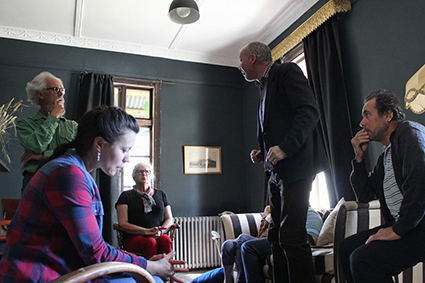
Uncle Vanya, actors and audience, Watford House
photo Tess Hutson
Uncle Vanya, actors and audience, Watford House
I always respond to a house that has a lot to say—and a house that speaks three languages is particularly alluring. On the weekend of March 21-22, Watford House in Avoca in rural Victoria spoke to a small La Mama audience for a groundbreaking version of Anton Chekhov’s Uncle Vanya. The play’s four acts spanned two days, with various group and private events in between—eating, walking, visiting the Chinese Gardens and processing the intense and unexpected emotions the play evoked in this setting.
This extraordinary production culminated a two-year process, working with the location of Watford House—a wooden house, pre-fabricated in Sweden in 1850 and imported to gold-rush Victoria—that has over the past 10 years been the site of artist Lyndal Jones’ remarkable environmental art site, The Avoca Project (TAP) which hosted the production. During the weekend, the 40-member audience (that’s all that could fit in the house) listened and rejoined as Watford House’s Swedish speaking walls entered a conversation with an English version of Chekhov’s Russian, improvised into vernacular Australian by director Bagryana Popov, the artistic team, and of course the actors on the day.
That weekend in Avoca the fourth wall of traditional theatre resoundingly broke down as the audience perched amid the action, inside and out. Yes, action—I know, Chekhov fans don’t expect action, anticipating instead much talk and a great deal of ennui. But that weekend we were actively on the move: shepherded by the director between rooms, and around outside spaces, then, between acts, making our own way through the Pyrenees. And, yes, there are Pyrenees in Victoria, beautiful, if very dry these days, speaking of the climate change that the characters discuss in the play. Because not only was the text Australian but so too was the context as Uncle Vanya and Sonia became regional Australian farmers, struggling as they do, and the Doctor emerged as an environmentalist, mapping the bush and forests, trying to save what he could.
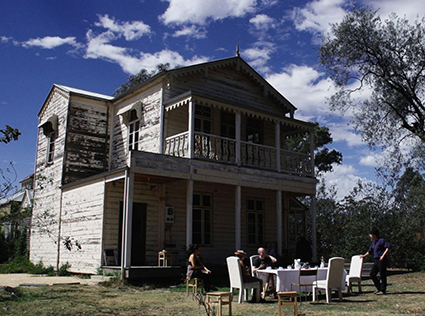
Uncle Vanya, Watford House, Avoca
photo Stuart Liddell
Uncle Vanya, Watford House, Avoca
The Australian context also informed the production’s intriguing play with authenticity conjured by the timing of each act following Chekhov’s actual timetable. But this was not some straightforward authenticity, as we came to sense with every syllable that emerged from the actors’ mouths and every reference to Australian forests. Uncle Vanya was in Avoca and Avoca was in Uncle Vanya, disturbing any sense that we were experiencing an ‘historical’ play. Also thrown into confusion were audience and actor roles. Not only did we move and sit among them, but for 15 minutes after each act we were invited to stay in our character, as audience, and they as characters in the play. This was charming, if disconcerting at first, but during and after Act 3, all hell broke loose. That Act, the dramatic climax, had the usual fighting, betrayals and recriminations ‘on stage’ and shooting and shouting ‘off stage.’ There were gasps from some of the audience, tears from others—and I admit both from me. So when I encountered the culprit, the Professor (Uncle Vanya fans will remember it was his presence that set everything off and falling apart) in the hallway on my way out, I had a lot to say. What surprised me was how I engaged with him. How could he, I demanded angrily, have acted so abominably, upsetting everyone, concerned only with his own selfish desires? Yes, I actually said this to the Professor, who, true to his character, spat back coldly that he was only thinking of his daughter, then turning away, slammed a door in my face—putting an end to our own play-within-a-play. I was shattered and exhilarated—this was definitely a first for me in play-going experiences.
At every turn, Uncle Vanya in Avoca offered another surprise. As in a Jean Luc Godard film, the unfolding process was made visible and audible and palpable. Particularly striking was the way that, with deft hand and voice the presence of director Bagryana Popov wove through every scene, as she responded to the actors with smiles, nods, furrowed brow and at times even some gentle prodding. Her energy and commitment inflected and infected the event. In the first few minutes of Act 1 when Popov went up to an actor and whispered in her ear, a frisson went through the audience—what was happening here? We knew suddenly that audience, actor, director—not to mention Anton Chekhov—were up for a phenomenal rethink, remix and re-experience and so they were, as this unique and innovative two-day theatre experience unfolded.
–
La Mama, Uncle Vanya in Avoca, director Bagryana Popov, performers James Wardlaw, Natascha Flowers, Todd MacDonald, Liz Jones, Olena Fedorova, John Bolton, Majid Shoko, Meredith Rogers, dramaturg Maryanne Lynch, music Elissa Goodrich; The Avoca Project, Watford House, Avoca, 21-22 March
RealTime issue #127 June-July 2015 pg. 30
© Norie Neumark; for permission to reproduce apply to realtime@realtimearts.net
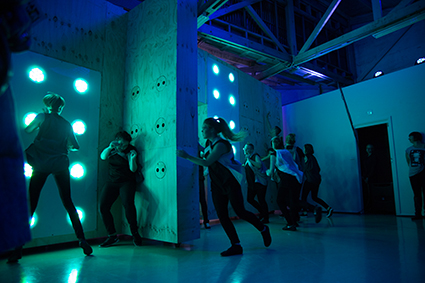
Stompin’, 6000 to 1
photo Jasper De Seymour
Stompin’, 6000 to 1
A dancer lies on the floor surrounded by a mandala of ordinary, yet luminously coloured objects from the life of a young person—tennis rackets, DVD sleeves. A female voiceover describes the aftermath of a suicide attempt, a moment when, against all odds, the body rejected a fatal cocktail of drugs. Her voice is followed by another, describing the accidental death of her brother, his organs donated. The prone dancer weeps openly as the remaining performers gently withdraw each mandala piece, stacking the bright fragments in small piles. This is 6000 to 1, a poignant and potent work by Stompin about choice and chance for young people. Drawn from local suicide statistics, the title, and the content, is close to the hearts of its dancers who are aged between 14 and 29.
Chance also plays the audience. Gathering in a carpark adjacent to the venue, our tickets are playing cards. Those with red suits go in one direction, we, with the black, go another. We are told we will need to keep our card with us, that we will be asked to make choices. Throughout the work, staged within an appropriated gallery, the two audiences separate and merge, all of us standing in close proximity to the dancers for each scene.
Each audience is introduced to two stories and a series of narrative fragments, illustrated through movement and voice: “this is not my personal story, but it comes from us.” In one, a girl steps into a pact with death, taking a mix of drugs and drink to end her life. In the other, a sister tells of a brother, horribly injured in a car accident. At the culmination of this first chapter, the two audiences merge and the dance builds in intensity. Initial movements based on joining, separating and re-forming between dancing pairs give way to faster bodily expressions of indecision, fear, tentative reaching, pushing and pulling, forward and back. Again, the dancers’ voices expose us to story fragments: “I was launching myself into the unknown and it was one of the best decisions I’ve ever made.” At the narrative peak, movement is frantic, through and around a large, mobile prop wall, its illuminated patterning mimicking our playing cards.
At this point we are asked, as an audience to choose. While we have been asked to show our cards prior within preceding chapters in order to interact (passively) with the dancers, strangely the playing cards do not figure in this last, more consequential choice. I go forward, rather than back. After a penultimate chapter within a darkened, enclosed room, where dancers voice views on fate and faith against repeated gestures and circular movement, we enter the last space and the emotional mandala scene plays out. A live video link connects the split audiences to aspects of the scene they are missing. I find that i have chosen to go forwards in time, toward the culmination of the story.
A Q&A session with the company is the work’s postscript. While this is a debatable move that definitely diffuses the drama of final scenes, it is here that we learn that the narratives we’ve witnessed are true. We understand the way particular gestures formed around stories and why it is that a dancer would weep. While some of the nuances of this difficult subject area have been lost in the translation to performance, the work is undeniably affecting. The minimal yet intimate setting places the audience within the work, the split viewing format underscores the concept of chance and each scene is infused with the personal investment of the performers.
Tasmanian International Arts Festival: Stompin, director, choreographer Emma Porteus, dramaturg, multimedia artist Martyn Coutts, lighting Ben Cisterne, guest choreographer Adam Wheeler, space design Matt Delbridge, costumes Sonja Hindrum, sound arrangement Randall Foxx; Sawtooth ARI, Launceston, 25-29 March
RealTime issue #127 June-July 2015 pg. 32
© Judith Abell; for permission to reproduce apply to realtime@realtimearts.net
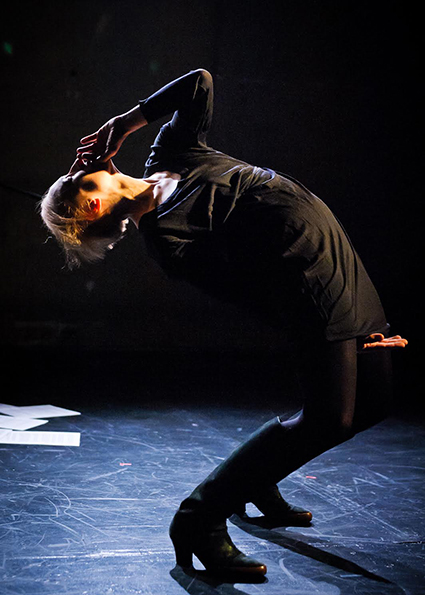
Jennifer Lacey, Gattica
photo Ian Douglas
Jennifer Lacey, Gattica
With only passing reference to the 1997 sci-fi movie Gattaca (director Andrew Nicol), Paris-based US choreographer-performer Jennifer Lacey puts the future, the present and the notion of ‘performance’ up for (literal) discussion in her work Gattica (a different spelling). In a piece both funny and philosophical, Lacey playfully jumps from text to dance to dialogue to group invocation, marking the minutes with the friendly rrring of a kitchen timer.
In the beginning: cross-legged on a raised stage, Lacey lights candles, then expounds on ‘the future’ in a tone equally evocative of pop gurus, sing-song TED-talkers and comforting automatons. “In the future we will all wear Prada.” “Dance will remain a minor form.” “Smokers will be replaced on the streets with sugar eaters.” “Art institutions will hibernate and cultural changes will slip in unobserved.” The pronouncements go on for some time as she waves a fan at a pace that matches the shifting urgency or ease of her tone. An ever-lengthening string of scenarios, depressing, silly or hopeful, are spelled out. The timer goes off.
What’s unfolding, though we don’t know it yet, concerns “The Future of Performance.” Lacey’s program note explains that Gattica was made in response to an invitation to address this topic in a forum, and propelled by her feeling that “the future is something I know nothing about and performance is a really broad topic.” In the present, though, things are slightly confusing, as she slips off the stage to the open floor and begins to dance, spike-heeled boots clacking on the timbers. Her body begins a slow improvisation, first marionette-like, knees knocking slackly together. Then, eyes closed, animal, prancing, undulating. Movements that look ‘like’ but are not, familiar gestures. After a while she finds a strong hook in the wall. She tries to climb it using the skirting board, whatever she can, to grip. The timer goes off.
We’ve begun with the future. We’ve seen a performance. Now for the future of performance. Lacey introduces academic and dance writer Philipa Rothfield. A large, low table is brought in on which Rothfield and Lacey both perch. Lacey sets the timer. Bottles of wine are pulled from a drawer. They drink, they talk—about the future of performance. It’s speculative, it’s intellectual, a staged conversation. Genuine, but perhaps not genuine, complicated by the performance space, by self-referential humour, by the containment of time, place and audience. This, for me, is the core of Gattica, interrogating what ‘performance’ is, what ‘the future’ means, unpacking itself, toying with us, submitting to its own unknowns, unfolding in multiple layers. A discussion disrupted by humour; a performance disrupted by discussion; both spontaneous and considered. It keeps morphing between sincerity and staginess. Ideas fly around: anxiety…solicited states of being…crystallisation…anthropology…The borders are erased between the artificial and the natural, between life and representation, between the serious and the frivolous. The timer trills, but they decide to ignore it.
Sometimes performance is defined by the pleasure of the artform itself: my companion, for example, felt she wanted more dance. For me, ‘performance’ is what happens when you give it the name ‘performance’—and then manage to pull it off. A self-fulfilling prophesy, if you’re lucky. Gattica left me thinking: all performance performs the future, bringing the future into being with every gesture. If everything were stationary, what would time be—or past, or present, or future? Without movement, would time even exist?
Final scene: procrastination. Lacey, alone again, wonders whether procrastination means you know intuitively that the thing you’re not doing would be better in the future. She asks us to join her in a kind of ‘spell,’ to bring something from the future to the present. She teaches us a sung refrain of a few words, and conducts us. The words run round in a gentle circle, “I have three horses, I have…three horses, I have…three horses…” We are placed in relationship both to each other and to what hasn’t happened yet, through a ritual with no accessible logic—but a ritual nonetheless.
Jennifer Lacey has described her work as process-based—relying on aesthetic rules, particular body vocabularies and behaviours—but giving priority, ultimately, to the poetic over the conceptual. Her work’s most consistent quality, she’s said, is a “coaxing strangeness.” Indeed, Gattica is strange but lends itself to reflection after the fact. It is amusing, bemusing, bright, funny and at times seemingly random, yet coherent. Performance happens when something is presented, yes? Made present. Hence, ‘presentation.’ The future, brought to the present. Thinking, thinking—and, at the same time, feeling the questions in their lightness, above all.
Jennifer Lacey, Gattica, Dancehouse, Melbourne, 11-12 April
RealTime issue #127 June-July 2015 pg. 34
© Urszula Dawkins; for permission to reproduce apply to realtime@realtimearts.net
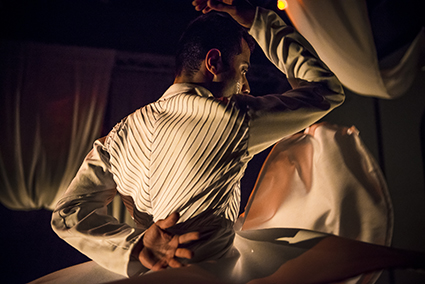
Raghav Handa, Tukre, FORM Dance Projects
photo Gregory Lorenzutti
Raghav Handa, Tukre, FORM Dance Projects
A softened hum, chant-like, without the intensity or expectation of a chorus to come. Investment in an activity, a small ritual taking place. Low light, ember glow. Small metal objects. Is it a lamp? Somewhat tarnished, I taste rust in my mouth, a quasi-synaesthetic response I have when seeing gold plate in old cathedrals. Rituals confuse the senses.
Rubbed together, these metals make a bearable sound such as industry should make. The rhythm picks up as Australian choreographer and performer of Indian heritage Raghav Handa, with sharpened, precise actions, appears to handle ‘some’ past, while promoting the whiff of a future foretelling: what to expect?
Taking this initial motif, he makes it larger to establish a pattern with slides, criss-crossing forearms, slicing forward and backward—and again. It is a slide between movements’ own Archimedean points: deliberate, aware, no hesitation. The fixed geometry widens after each stroke, opening history and space, waking us from a pinhole presence.
In a big black box, Clytie Smith lights the way with perimeters and planes. There is a sense of growing the movement from the elemental to a larger more complex form. It is extracted from these illuminated hollows and bands, eventually rounding out to explicitly show Handa’s “movement language (of) circular and linear movement patterns.” The relationship could not be clearer.
The sound by Lachlan Bostock is a constant friend to Handa whether sparse or complex in its poly-rhythms and speeds. The tabla sound and rhythm explored through voice and drum, buoyant and crisp upon the flow of strings and electronic instrumentation: movement and music, inextricable.
We are introduced to Handa’s mother Sashi who, seated in a blue dress, looms large over the stage, a spectral figure, sharply projected onto suspended white fabric (filmed by Martin Fox). With a gentle voice, she calls to her son across the seas, the borders and centuries. We come to understand the Indian family tradition and economy of jewellery making, the craft of stone and gem cutting and the melting of metals. The autobiographical places itself on stage as softly as Handa’s floating mother. She tells us of her wedding—heavy with the weight of all that gold.
Handa reminds us (not so gently) that in Australia he is unable to marry his partner (the great shame of this country’s deepened homophobia: a duplicitous celebration of certain stereotypical queer identities while not wholly supporting basic civil rights). We also feel his dislocation from the familial traditions of India, a country that legislates in like manner. Handa, stuck, shuttling between two deprivations in his cultural mobility, without the weight of gold, pairs his hands like two small creatures and plunges them into a ribbon of light bracing the sides of the stage. Fingers rapidly traverse without iconic gesture, from left to right, a ball of symmetrical energy in a fight or frantic mating scene. Handa supports these fingers of fury and fright with a puppeteer’s grace. Graceful he is. Pure even. Spinning and whirling between the tumbling white fabric and, at one time, beneath white robes that whip the air and spin the body like a rip cord, knee traced high into attitude: a balanced display of his signature movement qualities.
The dance is a metallurgical progression: movements extracted and extruded from the elemental, melting and melded, rounded out and sculpted into a family heirloom, subsistence, a way of life, an identity. A work of integrity and pleasure in the moving body that makes one want to move too. We have seen the light, and now I look forward to seeing Handa negotiate less gentle forces with this vocabulary.
FORM Dance Projects, Tukre, concept, choreography, performance Raghav Handa, cultural consultant, performer Sashi Handa, sound design Lachlan Bostock, lighting Clytie Smith, dramaturg Martin Del Amo, film, projections Martin Fox, costume Marissa Yeo, Pheonuh Callan; Riverside Theatres, Parramatta, 29 April-2 May
RealTime issue #127 June-July 2015 pg. 35
© Jodie McNeilly; for permission to reproduce apply to realtime@realtimearts.net
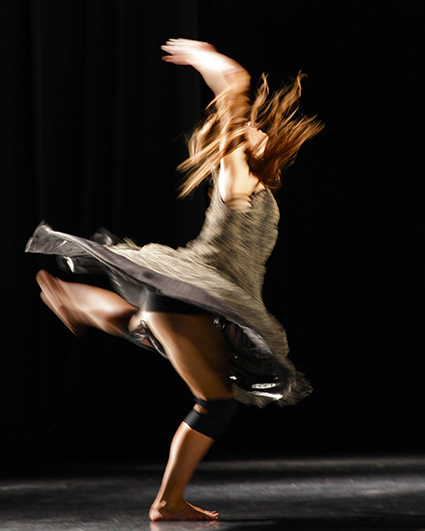
Sarah Jayne Howard, The Kiss Inside
photo courtesy of Douglas Wright
Sarah Jayne Howard, The Kiss Inside
There is a passage towards the close of Douglas Wright’s The Kiss Inside where Sarah-Jayne Howard, dressed in a mildly antique-cut red dress, executes a measured sequence of movements taken from the work and strung together as a comprehensive digest and delicate meditation on previous material. Arms bared and her muscularity unambiguously on show even as she executes liquid sweeps of the spine before taking her whole frame down to the ground in a more forceful gesture, the section stands out as a rare moment when the diverse components of this work coalesce into something like order.
Wright is one of New Zealand’s most prominent dance makers. After being recruited for his athletic abilities, he moved to performing expressive, narrative solo works whose balletic vocabulary might be compared to that of Ji?í Kylián. Later, Wright moved into various iterations of contemporary dance theatre, drawing on his experience with Australian Dance Theatre and DV8. His work now has more of the disjointed aesthetic of Flemish and German postmodern or postdramatic companies such as Les ballets C de la B. Even so there are moments that echo Meryl Tankard and Pina Bausch in flashes of unadorned, folkloric modernism, as when Wright’s five dancers join hands and execute a simple, dipping line dance as if at a traditional Greek wedding or Purim festival.
The Kiss Inside is Wright’s first full-length work in four years and is mooted to be his last (although this has been suggested before). Promoted as a “kinetic meditation on the search for ecstasy,” the piece also marks more than 10 years of collaboration between Wright and fellow New Zealander Sarah-Jayne Howard (ADT, Force Majeure, Chunky Move, dancenorth).
Like much of Wright’s work of the last decade, Kiss is not a smooth ride. Indeed, it is striking in its choreographic, musical and dramaturgical variety. Scenes cut abruptly into unprecedented new scenarios varying from one in which Craig Bary mimes the act of licking a sharpened knife blade (a rather hackneyed attempt at provocation, apparently drawing on Hindu practice) to the deliberately gratuitous arrival of a figure in a blue gorilla suit, who holds a microphone to prone dancers as they call out “Mummy!”
Several of these images have a rare, Surrealist beauty which arrests attention. In the beginning, Luke Hanna hanging upside-down beside an inverted tree suspended from the gallery, lifts himself up on wide open arms in a V (a gesture Howard invokes in the passage described above) and sings a Waiata, or Maori greeting. Hanna returns at the conclusion, naked, a stack of books bound to his head and a pair of sloping tomes with hard covers tied to his feet, his slow, rhythmic pacing echoing into the darkness as he laboriously crosses the stage.
The movement is equally varied. Accompanied by Klezmer music, Tara Jade Samaya—known to Australian audiences through her work with Chunky Move—performs a complex, fluid set of hand movements which seem inspired in part by classical Indian dance. By contrast, the rough, often ground-based movement of the second scene, paired here with the music of punk goddess Patti Smith, evokes the flinging athleticism of Garry Stewart and DV8. This combination of ambiences makes for a style which never settles into any clear physical or choreographic logic, but rather seems as much of a montage as the radically inconsistent music. For this reason the passage performed by Howard stands out, taking multitudinous, often grating elements and effortlessly blending them.
The Kiss Inside therefore places before the audience in an especially striking manner what one might call the unending crisis of contemporary dance, or alternatively the joyous resolution of this ‘problem.’ Wright does not discard structure, and nor are we fully in the world of the postdramatic, where dance-makers repeatedly stage the collapse of their own dramaturgical conceits. The city I live in, Dunedin, has recently seen a number of such postdramatic works—notably Tassel Me This (Shani Dickins & Jessie McCall) and Footnote’s Bbeals (seewww.theatreview.org.nz).
Even so, Bacchic ecstasy is almost the founding thematic of modern dance via its Ur-text of The Rite of Spring and its countless iterations—including those by Tankard and Bausch. Wright however neither engages with this tradition, nor rejects it by crafting an alternate paradigm. Rather he metaphorically flips the channel, surfs the net and otherwise allows his disparate pseudo-ecstatic vignettes of intravenous drug use, or belief in spiritual rebirth, to fall where they may, producing an effect like scattered leaves. For me at least, this makes for an unsatisfying experience, since the piece neither tells a discernible story (Expressionism) nor causes a new, secret formal logic to emerge out of its materials and interdisciplinary explorations (postmodernism). Between styles and places, The Kiss Inside is definitely Wright’s own work.
Douglas Wright Company, The Kiss Inside, choreography Douglas Wright, performers Douglas Wright, Sarah-Jayne Howard, Craig Bary, Luke Hanna, Simone Lapka, Tara Jade Samaya; Regent Theatre, Dunedin, NZ, 24 April
RealTime issue #127 June-July 2015 pg. 36
© Jonathan Marshall; for permission to reproduce apply to realtime@realtimearts.net
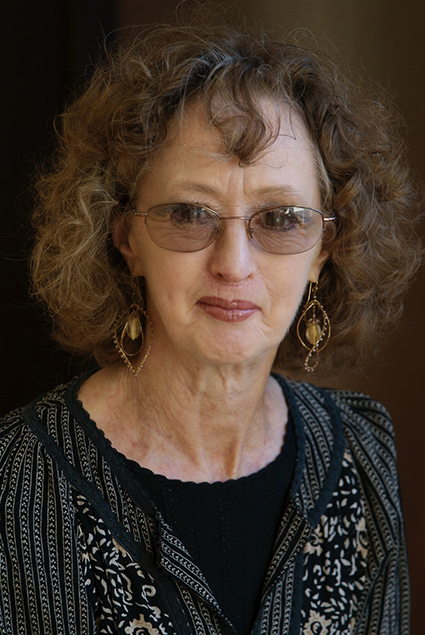
Maggi Phillips, 2009
photo courtesy Anna Phillips
Maggi Phillips, 2009
Maggi Phillips reviewed perceptively, lyrically and idiosyncratically for RealTime for the best part of a decade. She was ever attentive, not easily impressed but fair and never likely to condemn—save in her final review in which she grumpily dismissed Perth Festival works by William Forsythe and Mark Morris while rhapsodising over Aakash Odedra’s Rising. There was a special place in her heart for Indian dance. As editors we’d sometimes return reviews with ‘please explain’ annotations attached to her more poetic responses, which she graciously answered. Occasionally we’d receive a review with a note that said, “This one might be a bit much.” Barely a week before her death we were in touch about reviewing a new show by a young WA choreographer. Maggi and her writing are greatly missed.
Keith and Virginia
We all need a rhinoceros
Famously, somewhere in Perth, there was a photograph of Maggi dancing on top of an elephant. I was never lucky enough to see it myself, but it had taken on the status of legend within West Australia and beyond. It was certainly one of Maggi’s best stories, but it was far from her only one. A significant part of her charm was the way she wove in these tales of her extraordinary career into discussions which, at first glance, might seem to have had little to do with them.
Once when presenting to young honours and postgraduate researchers at the Western Australian Academy for the Performing Arts [WAAPA], Maggi related how she had toured with a company which had a rhinoceros. Whenever she was feeling stressed or wanted a calming break in her routine, she would go to its cage and watch it. She said she found the way it wiggled its ears soothing. We all needed a rhinoceros, she told us her tall, balletic frame curving sympathetically with her deep, throaty laugh.
When I came to WAAPA as a Research Fellow at the close of 2003, Maggi immediately took me under her wing. It was a key moment in my career, being the point at which I flew the world of thesis writing and moved to working at a major tertiary institution. I cannot even begin to count the number of other nervous young scholars and artists she mentored over the course of her life, but all of us felt very loved and protected by Maggi.
Maggi and I often disagreed—but upon the best of all possible terms, of course. Her long, rising exclamation of “owwww!” and the sweep of her arm as she moved her body back away from me in mock anger was a common response. She put on a fine comic show of being shocked at how I referred to Josephine Baker as “Josie,” before she floored me with another of her amazing tales, this time of how a mature Josephine Baker had come across Maggi and her fellow dancers after they had been abandoned by their company manager in South America, when the accounts had gone belly-up. The divine Ms Josephine put on a special benefit show to secure funds to send these poor waifs back home. My own arguments with Maggi—and our many agreements as well—were always based on a shared love of performance in all its forms. I sometimes imagined Maggi as a Josephine figure herself, wrapped in a svelte black knit dress as when she told the story of the rhinoceros. She had both style and charm, and she knew it, but she was always gracious, friendly and loving.
Typically, however, she was modest. She felt she served the arts and students, and did not go out of her way to promote herself, despite the fact that this is what most of us in academia are encouraged to do. She was like her apartment: beautiful but unassuming. I still remember the jars of cuttings growing along the windowsill, a fecund garden sprouting in all directions with the simplest of supports. Back on campus, Maggi agreed with me that the raucous cockatoos which squawked and screeched from the pines outside our offices were, like the rhinoceros, creatures to treasure and revel in—although she did concede she found the way they dropped chewed pine cone fragments on top of her car frustrating. Putting up with a messy vehicle or working on the side-lines was fine with Maggi, so long as there was dance and music in the world.
Maggi’s charisma derived from the manner in which her many life stories and life experiences fed into her day to day life and demeanour. She could move from serious discussion of the latest work by the WA Ballet to relating how as a young dancer, she had stayed at a questionable apartment off a side street in Paris, and how the local prostitutes used to shoo their clients and force them to stand in line, every time Maggi and her colleagues came back from performing in the evening.
Maggi’s degree in world literature and comparative analysis, which she completed after retiring from dancing herself, continued to inform her work throughout her career. She remained sensitive to cultural difference and to the context within which dance and the arts function at all times. She was a tireless advocate of the special forms of knowledge which dance, choreography and the arts offer to society.
One of Maggi’s greatest assets was her openness. Merce Cunningham and Romantic ballet, ballroom dancing and Bharata-Natyam, Maggi loved it all, and while I would often bemoan to her the aesthetics of one piece or another in favour of some purportedly more avant-garde ideal, Maggi was keen to embrace all comers. Although she had a particular fondness for art of the Indian subcontinent, Maggi’s tastes were nothing if not catholic in the truest sense. And we dearly loved her for it. I owe her much, and my thoughts and best wishes go out to all those others who were lucky enough to share time with the woman who taught me that we all need a rhinoceros.
Jonathan Marshall, University of Otago, Dunedin, NZ (WAAPA 2004-08)
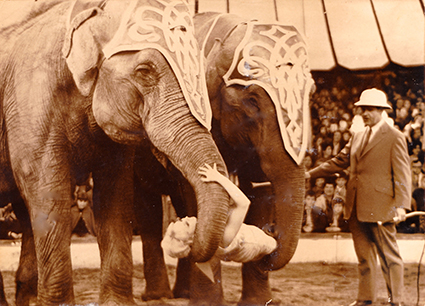
Maggi Phillips, 1969, KNIE Circus Switzerland
photo courtesy Anna Phillips
Maggi Phillips, 1969, KNIE Circus Switzerland
Maggi Phillips
Maggi Phillips was Associate Professor and the Coordinator of Research and Creative Practice at the Western Australian Academy of Performing Arts and led the Australian Learning and Teaching Council project, Dancing between Diversity and Consistency: Refining Assessment in Post Graduate Degrees. In 2010, she received an Australian Dance Award for her Services to Dance Education and in 2013 took on the role of Editor of Brolga—an Australian journal about dance.
Maggi Phillips’ own account of her remarkable pre-WAAPA career can be read on the Tracks’ website www.tracksdance.com.au/maggi-phillips-1944—ballet from the age of six; training at the National Theatre Ballet School; no ballet jobs, so a black and white minstrel show in 1964 (her first professional employment); from 1965 “eight years under Dois Haug (choreographer Moulin Rouge)…with one of her touring troupes [travelling] Europe, Middle East, and South America, in cabaret, theatres, casinos, and circuses;” in Darwin in 1974 as a young mother; 1976 onwards in Darwin variously teaching, choreographing, setting up an amateur dance company, Dance Mob, working with Brown’s Mart on education projects and then as Dance Officer bringing in guest choreographers for major productions, touring extensively to Indigenous communities and establishing the professional dance education company Feats Unlimited, a Brown’s Mart initiative, before relocating to work at WAAPA. Tracks pays tribute to Maggi “as an inspiration and pioneer in bringing modern dance to Darwin,” listing the many people still active in the arts in Darwin who benefitted from her legacy, including current Tracks artistic directors Tim Newth and David McMicken.
RealTime issue #127 June-July 2015 pg. 37
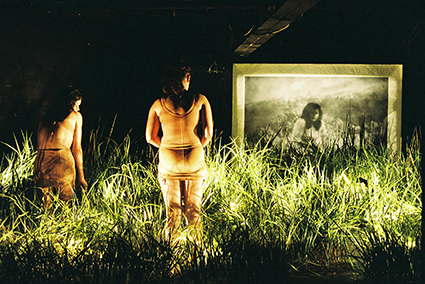
Politely Savage (2005), My Darling Patricia
photo Heidrun Lohr
Politely Savage (2005), My Darling Patricia
It is over 10 years ago now that My Darling Patricia (Clare Britton, Bridget Dolan, Katrina Gill and Halcyon Macleod) boldly dressed the contemporary performance outdoors in what has since become their signature feminist aesthetic. In Dear Pat (2004), three impeccably dressed wartime women plotted out a highly curated sequence of gestural imagining in Bondi’s evening open air, complete with tailored pencil skirt assemblies and tightly crafted pin-curled hair sets. With delicate glances askance and waving from afar, their high-heeled bodies carved out the physical geometries of a nostalgic other-time, long before Mad Men plunged the post-war feminine back into mainstream view.
Dear Pat was the second of the company’s public, site-specific works, building on the character types foregrounded in the domestic spectacle Kissing the Mirror (2003) a year earlier. Positioned in the intimacy of a Petersham caretaker’s apartment, Britton and Macleod physically stuttered as they poured themselves tea, Macleod’s fine porcelain teetering, Britton hunch-backed and drooling. Where Dear Pat built on the ‘chronotope’ of the post-war woman, these aged women instead envisioned her demise, at once imagining into old age and also seeking through her perspective the gendered traces of a former heyday. Both works ascend to the calamity of a salacious reveal: the old women conduct a slow rooftop embrace with alien-foetus-like puppets (their inner selves, their lost ‘twins’?), and the women in Dear Pat are seduced by a large inflatable multi-titted vision of the monstrous feminine herself.
In both works, this distilled staging of a precisely feminine aesthetic is what enables the company’s feminist politics to take shape. Speaking to Macleod and Britton in the aftermath of their company’s 11-year success—My Darling Patricia has recently drawn itself to a close—it becomes clear that these very productive tensions between inner and outer worlds, working across the dynamics of intimacy and spectacle, have grounded their theatrical vision from the beginning. Britton describes how key early influences in physical as well as visual training from PACT, COFA, Performance Space and Erth, as well as mentors such as Chris Ryan, Robert Lepage and Philippe Genty, landed their practice at “a cross-[roads] between performance and sculpture.” It also becomes clear that this desire to articulate what Macleod emphasises as “a visual language [working] through the performance” is inseparable from the thematic terrain the company has continuously evoked.
Their prize-winning work Politely Savage (2005; R67, p32; RT68, p47;), which interestingly seemed to enfold the dynamics of site-specificity into an enclosed theatre space, fleshed out these duplicities by exploring what Britton describes as an ongoing curiosity in “artifice, or that difference between how something looks and what’s going on inside—people who were performing a version of their lives for other people.” Macleod names this the “polite woman as a type…that need to be nice and polite and pretty” and notes how dramaturgically the polite woman can operate as “a gateway to this other thing: the imagined world, the mythic world.” It is the company’s signature ability to summon the mythic that has resulted in their work often being labelled suburban-gothic and I ask them whether their interest in the monstrous feminine might have in addition opened out a more located investment in a particularly Australian form of gendered experience.
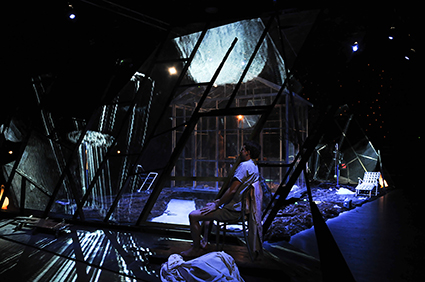
Night Garden (2009) My Darling Patricia
photo Heidrun Lohr
Night Garden (2009) My Darling Patricia
For them, the suburban necessarily resonates with inverse ideas of the internal for how it “brings up those notions of a banal veneer and something subterranean and more interesting and grander underneath.” The suburban gendered experience hinted at in the historical flavour of the post-war trilogy is fleshed out further in Night Garden (2009; RT90, p46) which works with a transverse stage to envision the waking dreamscape of a mother caught in what the audience experiences as both a social and spatial frame. The socio-economic landscape in this work is further drawn into stark relief in Africa (2009; RT 94, p40) where we witness the inverse of the mythic feminine to instead see her brutal domestic reality. Puppet children here focus the child’s perspective of an adult world: adults are only ever seen from the waist down. The monstrous feminine, who in earlier works has been visualised as a vagrant puppet-child-creature—the mythic imagining of female repression itself—is here decidedly not metaphorical. There is no poetic relief cast by the otherness of these puppets, but rather a crushing finality to the fact that their very otherness materialises what is culturally cast aside. The puppets here speak to the monstrous landscape of social disadvantage.
While gendered experience is the subtext of much of My Darling Patricia’s work, their operating context is also explicitly feminist in that it “is trying to actively create more female perspectives and work with female collaborators. Not exclusively. We’ve worked with a lot of lovely men as well. But we’ve definitely tried to have an impact that’s empowering of women,” Britton explains. Macleod adds, “Women in the room have always been in control of the process and of the room and of the artistic vision and of the collaborations,” acknowledging as well that the concepts behind Africa and The Piper were from Sam Routledge. In navigating the evolution of their company aesthetics it is interesting that the seeds planted by their early works evolved to craft two very different theatrical worlds in the latter stages of the company’s life. Posts in the Paddock (2011; RT107, p38) and The Piper (2014); both abandon this early interest in the mythic female to respectively contemplate historical and children’s perspectives.
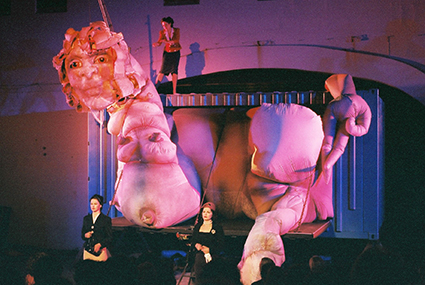
Dear Pat, My Darling Patricia (2004)
photo courtesy the artists
Dear Pat, My Darling Patricia (2004)
As children enter the frame (Macleod is currently nursing her second child and Britton had her son just after Politely Savage closed), I ask whether they’ve experienced gender disadvantage in accessing funding for their works; they mention their proposals to funding bodies about establishing a childcare fund to support interstate collaborations and touring works. As artists, they need childcare that covers intensive periods of work when living away from home. Britton explains the brutal pragmatics of the situation as a compromise between earning less than enough versus nothing at all: “You can either compromise on childcare [budget] or put in an application that’s less competitive because it’s more expensive.” In this context, two of the company’s founding members, (Katrina Gill and Bridget Dolan) were challenged by the demands of interstate collaboration with young children. Dolan is now a practicing painter and Gill is on a similar trajectory. At the same time, Macleod and Britton also acknowledge that these concerns might now be dwarfed by larger threats to any form of experimental practice given the recently proposed cuts to arts funding in Australia. Macleod hence notes the benefits of paving the autonomous path that they’ve set for themselves, where “wanting to create experimental projects and realise your own ideas and not wanting to answer to someone else” is a privilege.
All of this might lead you to think that Britton and Macleod could be in need of a rest, but speaking to them on the cusp of new horizons, these women are already fleshing out their next trajectories. For Macleod an interest in textuality is taking her to a collaborative development in Barbados, and for Britton, an interest in Australia’s broken relationship to its past is currently taking her rowing down the Cooks River. In addition, The Piper will be touring to Edinburgh Fringe Festival in August and they are also looking to remount their most recent work Mantle, which premiered at Campbelltown Arts Centre late last year. Perhaps rather than monstrous, these women have found a ‘feminine’ of a different order: both tenacious and steady, to say the least.
RealTime issue #127 June-July 2015 pg. 38-39
© Bryoni Trezise; for permission to reproduce apply to realtime@realtimearts.net
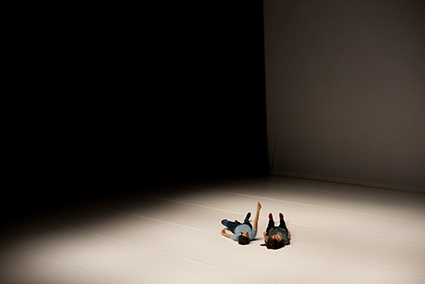
Into the World, David Weber-Krebs
photo courtesy the artist
Into the World, David Weber-Krebs
There is something bittersweet about seeing excellent performance works in Brussels, only to realise that they are made by Australians. There are not too many Australian performance-makers in Brussels, but, due to the dense network of performance venues in this corner of Europe, and the prominence of Amsterdam, Berlin, Paris and London as meccas for theatre lovers and theatre makers, one sees many pass through.
Encounters with the Australian makers are often accidental and serendipitous, and say a lot about the artistic networks criss-crossing Europe. Both shows covered here had only two-day seasons. After we enthusiastically cross-examined the artistic team during the post-show Q&A, one of the performers in Into the Big World, Noha Ramadan, approached us inquiring: “Are you also Aussies?” Ramadan is based in Amsterdam, while David Weber-Krebs (Belgium/Germany), the author of Into the Big World, is based in Brussels but works all over Europe. The author of the second piece, For Your Ears Only, Dianne Weller is a performer, actor and singer who originates from Sydney and arrived in Brussels many years ago via London. I met her through a British friend, who collaborated on this work.
Australian artists in Belgium tend to be light, rested, unburdened by the questions that trouble their peers at home. If they are eligible for domestic funding schemes, like Weller, then they have long-term work security unimaginable to an independent artist in Australia. Local politicians do not attack their profession as a matter of course. And when they make challenging, ambitious works, such as the ones I’ve seen, the audience really pays attention. It should all be so easy.
Dianne Weller, For Your Ears Only
For Your Ears Only is ‘radiophonic theatre’: the stage remains in the dark throughout the performance, with only very discreet changes in lighting, while we listen to three critics (Andrew Haydon, Pieter T’Jonck, Elke Van Campenhout) debate the merits and demerits of the performance we are not seeing. The performance engages in two lines of inquiry: the evocative power of sound, and the possibility of recreating the theatrical experience from documentation. For Your Ears Only builds a vast edifice of interpretation around a show that never existed: the audience sees it through the prism of criticism, the critics have only seen documentation material, and the artists have ‘documented’ a show they never made.
Of course, as Forced Entertainment and similar groups from the 1990s, as well as much contemporary immersive theatre, have proven conclusively, sound is often all it takes to evoke a full experience. Having practically ‘seen’ the show in question, I feel fully authorised to tell you that it features a three-storey house with rooms outfitted to evoke popular films: Eyes Wide Shut, American Psycho and similar, through which actors move, performing short scenes. Through a pair of multimedia goggles and headphones, we can zoom in on separate rooms and hear the dialogue. In Haydon’s words, it feels like “the Internet version of watching theatre.” The rooms do not amount to a logical house: among the more ordinary bathroom, kitchen, corridor are motel rooms and a large ground-floor gallery. The spaces are deeply imbued with cultural significance, moreso than with architectural logic; for Campenhout, the entire house feels like “some kind of sanatorium for the sentimentally displaced.”
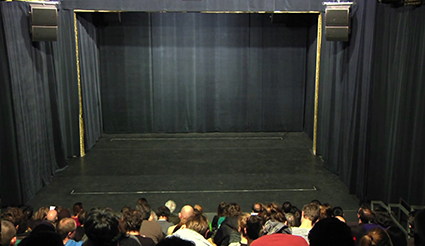
For Your Ears Only, Dianne Weller, Apocalypse 2
photo/video Alessan
For Your Ears Only, Dianne Weller, Apocalypse 2
The scenes excavate the deep cultural memories associated with the home, which tend towards images of violence, particularly violence against women—a surprising revelation about our collective imagination, contrary to the common discourse on women’s safety. For Campenhout, a seedy sexuality reminiscent of Brian de Palma films permeates the show, not least because the spectator feels like a voyeur, having to choose which of the rooms and actors to focus on. The world built in the work is deeply paranoid, a world of men reassuring themselves of their strength by using women—all three critics draw convincing comparisons to an urban, peace-time version of Coppola’s Apocalypse Now—and creating larger-than-life cultural hallucinations to replace reality.
Watching/listening to For Your Ears Only had intriguing parallels to calling a phone sex hotline, the (now vastly outdated) version where the listener dials into a pre-recorded audio story: the general seediness of the experience, the thematic intrusion into domestic scenes that fetishise the women who inhabit them, the reliance on the experience of the spoken description of events, as well as the very strange disjunction between feeling like a voyeur and not being able to see. The male gaze structures both, but the absence of visuals allows us to imagine things just right: the show in For Your Ears Only was exactly to my taste.
David Weber-Krebs, Into the Big World
David Weber-Krebs’ Into The Big World is the best performance piece I have seen in years. It concerns itself with nothing less than how European science organises knowledge. It traces various scientific methods, taxonomies and epistemologies through history, progressing from direct observation and unstructured lists to detailed taxonomies and theoretical models, to active meddling into natural processes. This progress is brilliantly embodied on stage by two performers, Noha Ramadan and Katja Dreyer, who chant and list and enumerate the things we know on an empty stage. As the knowledge becomes increasingly abstract, exact and the facts distanced from the quotidian life, so the interaction between their bodies and the set (sculpted economically with lighting and sound) becomes disjointed, distant and rigid. With a rigorous minimalism, the organic liveness of performance becomes an oppressively rigid clockwork, the language shifts from ‘Here is…’ to ‘I know…’, and a sensuous exchange between bodies and the space surrounding them becomes manipulation, then abstract ownership.
The ideas in the piece are masterfully expressed with a sensibility that is unmistakably choreographic: Weber-Krebs sculpts and articulates body, space and emptiness as precisely as a a master craftsman fashions wood into a chair. Moreover, this is not a live artist’s activist critique of abstract reasoning, and in no way a naïve work. Weber-Krebs has created many pieces with and for museums, and Into The Big World is a very informed performance. Its diagnosis of how our entire embodied lives are shaped by the scientific thought is accurate and precise: it equally describes the changes to how we eat, cure illness, how we attempt to harness energy or mitigate climate change. I am in no doubt that an audience of scientists would hugely enjoy Into The Big World.
I am also in no doubt that sound engineers and archivists would love For Your Ears Only: both approach their material with a rigour and conceptual depth that, paradoxically, makes their philosophical inquiry universally accessible, across relevant disciplines. Neither work obfuscates, but enlightens. In a comparatively more stressful, product-oriented and commercially minded ecology of Melbourne, I rarely see this level of rigour achieved by local artists. But it is rarely demanded, either, and this is why the experience of these two works was bittersweet.
For more on David Weber-Krebs see Virginia Baxter, In Between Time Festival, 2006.
For Your Ears Only, Dianne Weller, sound artists Ruben Nachtergaele, Ludo Engels, critics Andrew Haydon, Pieter T’Jonck & Elke Van Campenhout, lighting design Hans Meijer; Julie Pfleiderer, Beursschouwburg, 19-20 Feb; Into The Big World, by David Weber Krebs, performers Katja Dreyer, Noha Ramadan; Kaaistudios, Brussels, 10-11 Feb
RealTime issue #127 June-July 2015 pg. 40
© Jana Perkovic; for permission to reproduce apply to realtime@realtimearts.net
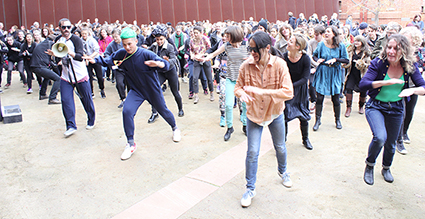
Hoofer Dance, Free the Arts Rally, Southbank Melbourne, May 22
“We will force Senator Brandis to have the public consultation he has avoided so far,” declared Mark Dreyfus, Shadow Minister for the Arts on 2 June. As we go to press, the Federal Opposition is calling for a Senate inquiry into the “Coalition Arts Slush Fund”—the $104.8 million heisted from the Australia Council to fund the new “National Programme for Excellence in the Arts” within Attorney-General and Arts Minister Senator George Brandis’ own department.
In recent weeks Media Arts & Entertainment Alliance petition has been circulating, a national protest held (see editorial), dozens of public statements made, mostly by the now at-risk artists in the small to medium sector but also Artspeak (the confederation of national peak arts organisations), letters of complaint sent to Minister Brandis and many significant articles published, especially online. Rumours abound that the Minister’s department brought pressure to bear on major performing arts organisations not to get involved in the discussion after Queensland Theatre Company artistic director Wesley Enoch, the State Theatre Company of SA, Black Swan and Circus Oz made their concerns public. There’s an understanding among the major companies that their wellbeing relies in the long-term on the health of the small to medium sector, but will they (CAST, the Confederation of Australian State Theatre Companies) come together to protest Brandis’ action?
While there’ll be no support from Opera Australia (“we’ll take money from anywhere,” said the company’s General Manager, Craig Hassall) or the Australian Ballet, it’s important that artists form an otherwise united front against the most significant assault on the Australia Council in its history and, above all, the contempt of this Minister for a large proportion of Australia’s artists. Let’s hope that by the time RealTime is on the streets, a Senate inquiry will have been scheduled and Brandis taken to task. The $104.8 million must be returned.
Read Major art heist: the Brandis file, our analysis of Senator George Brandis' recent budgetary decisions, published in the May 20 Profiler.
RealTime issue #127 June-July 2015 pg. 25-26
© Keith Gallasch; for permission to reproduce apply to realtime@realtimearts.net
‘Theatre restaurant’ is a descriptor that brings with it a distinct set of connotations, and they’re of the sort that few outside the actual theatre restaurant industry hope to have bestowed upon them. It was with some rare delight that I saw a recent venture by Melbourne polymorphs Aphids consciously billed as “part theatre restaurant.” Of all the denigrated forms that have been reclaimed of late—pantomime, burlesque, variety—this was one I never saw coming.
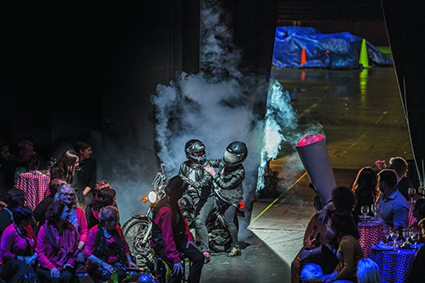
A Singular Phenomenon, Aphids
photo Bryony Jackson
A Singular Phenomenon, Aphids
Aphids, A Singular Phenomenon
A Singular Phenomenon does indeed have something of the theatre restaurant atmosphere to it, not merely due to the serving of plates of pasta to audiences. It’s the proudly communitarian spirit the work aims towards, a question not so much of the low-brow populism we often associate with the theatre restaurant (or cruise ship, or corporate event) as a no-brow anything-goes approach that seems unaware of the existence of theatrical convention. It takes quite a bit of art to appear so unselfconsciously artless.
The work has at its centre a truly iconic Australian pop song of the 1980s that will be instantly recognisable if you’re over about 30, though it’s almost certain you haven’t thought about it for many, many years. I’m told that Aphids hopes to remount A Singular Phenomenon elsewhere and so I’m wary of revealing the song’s identity, but the piece is certainly stuffed with enough business and detours that foreknowledge would be unlikely to detract from the experience. Still, I’m keeping mum.
I can reveal that the structure of the work sees audience members assigned characters from the history of the song and its creator, and as an extended role call is announced these characters take their place upon the stage. No interaction is required beyond that; we’re merely placeholders and the random allocation of parts is democratic enough.
There are exceptions in the form of real people who loomed large in the song’s history, and who take to the stage as themselves. On opening night the reviewers in attendance were also summoned under their real titles, which initially struck me as juvenile—’outing’ critics while The Blackeyed Peas song “Shut Up” blares from speakers is oddly antagonistic in a work that is otherwise carnival and celebratory. But if we’re to be the representatives of authority in a dynamic that otherwise seeks to level power structures, then so be it.
Charting the biography of a song is an interesting premise, though this history is entirely sympathetic to its subject and there’s not much critical edge to it. The production occasionally strays into murkier territory, such as the spurious claims of child pornography the song’s creator was subjected to after posting images by a well-known international artist to Facebook. But thankfully the behind-the-scenes life of this figure, and the track itself, is full of enough bizarre detail and cultural significance to warrant a mere blow-by-blow recounting, which is finally what A Singular Phenomenon amounts to. To throw too much dialectical critique into the mix would perhaps be to its detriment.
The Living Museum of Erotic Women
The Living Museum of Erotic Women is another event that is wholly celebratory, in this case of a quite astonishing array of women across history. It’s set up as a sprawling installation spanning five storeys and while there’s a vague nod to UK theatre company Punchdrunk Sleep No More (2011) in layout, the similarities don’t extend too far. Performers in various rooms enact vignettes, soliloquies, dance and burlesque routines, and audiences are mostly free to wander between each with the occasional gathering for a special routine in a shared space.
The women performed range from the familiar—Mata Hari, Marlene Dietrich, Salome—to the more esoteric, such as the Mongol warrior Khutulun and Kabuki’s Izumo-no-Okuni. At times the focus on the erotic aspects of these appears outlandish. Joan of Arc seems a weird choice, for instance, but here proves a worthy one in a solo routine that produces uncomfortably sado-masochistic imagery of torture, resistance and ultimate defeat. The ‘She-Wolf’ Messalina is another memorable addition, snarling and prowling a space covered in severed penises, problematising the gaze of viewers by reminding them of their own precarious physicality and proximity.
This is, again, not a particularly critical work. For the most part it’s an unalloyed tribute to the spectacle of femininity, and if the function of spectacle and masquerade isn’t particularly questioned here, at least the variety of modalities through which that femininity can be expressed is encouragingly diverse. There’s also a certain queering of essentialism, with the artifice of representation never confused for the ‘real’. Some of the acts on offer suggest a rich sense of craft and subtle nuance, while others are charming in the simplicity of their intent.
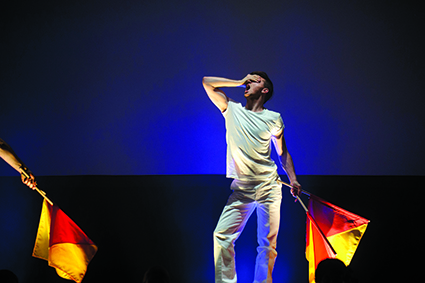
Semaphore, Kate Neal
photo Sarah Walker
Semaphore, Kate Neal
Kate Neal, Semaphore
There’s no doubting the technical skill and rigorous discipline behind Kate Neal’s Semaphore, on the other hand. This is a consummate feat in sound and dance. Inspired by her father’s time spent working as a signalman in World War II, Neal draws on visual and auditory codes such as Semaphore and Morse code and refigures them in extraordinary ways.
Neal is a composer and the work is primarily sonic—a heavy emphasis on percussion sees the employment of dozens of drums, bells and other strikable objects, while even breath itself is choreographed in percussive ways. The sharply regimented syncopation at times slides into ravishing piano glissandi and arpeggiated strings, suggestive of the rolling seas the signalman traversed, while brief sequences of animation and video provide context from Neal’s father himself.
All of this would make for a terribly fine work, so it’s quite an accomplishment that the addition of a potent dance element doesn’t distract or muddle the focus. Timothy Walsh’s choreography bleeds into Neal’s composition as semaphore flags slice the air with audible snaps and flutters, while the musicians are given movements that make their own performances dance-like. The bright red and yellow of the swung flags is made more pronounced by a gentle aura of blue light, and thick haze effects make more solid the air in which these signifiers mingle. If the staccato telegraph and the blinking signal light can be considered their own forms of language, Neal has proven that they’re as capable of poetry as any other.
Aphids, A Singular Phenomenon, creators Lara Thoms with Aaron Orzech, Liz Dunn, original project development by Tristan Meecham, The Merlyn, Malthouse Theatre, 2–23 May; Bernzerk Productions, The Living Museum of Erotic Women, director Willow J Conway, End to End Building, Collingwood, 12 May–7 June; Semaphore, composer, concept: Kate Neal, director Laura Sheedy, choreographer, dancer: Timothy Walsh, animation, video: Sal Cooper, Arts House, North Melbourne Town Hall, 27-31 May
RealTime issue #127 June-July 2015 pg. 43
© John Bailey; for permission to reproduce apply to realtime@realtimearts.net
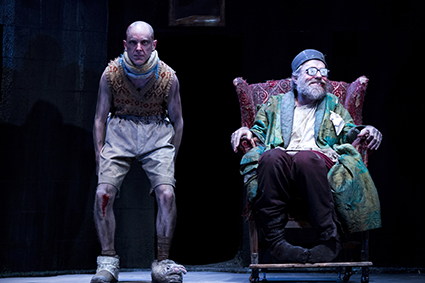
Tom Budge, Hugo Weaving in Sydney Theatre Company’s Endgame
photo Lisa Tomasetti
Tom Budge, Hugo Weaving in Sydney Theatre Company’s Endgame
On the Sydney Theatre stage is a huge black box framing the curved interior wall of a lighthouse which towers vertiginously, a small high window either side, no stairs, a door centre, a clock and fine spiderweb-like threads misting the bricks before evaporating. Here, in this ominously vertical edifice, a power struggle will play out between servant and master in a cruel habitual game.
STC, Endgame
In Beckett—novel, play, poem or letter—rhythm is elemental: line, legato, lilt, cadence and pulse. We readers ‘sing’ him in our heads; actors give him voice, no more tellingly than in the dialogues of Waiting for Godot and Endgame, where discrete voices must function rhythmically as one. The power play of co-dependency that is fundamental to Endgame demands it.
By the climax of Endgame pitiless dominance and hostile servitude have played out to breaking point—Hamm faces death, Clov might leave—is a hint of life, a boy, glimpsed in the wasted world outside enough to propel him? In this production, directed by Andrew Upton, there’s a game of a kind, but a matching of forces? Hamm’s relentless conniving (veiled in charm and the apparent honesty of personal revelation) and Clov’s decreasingly passive resistance (increasingly uncooperative, not to be baited, refusing Hamm’s intimations of affection), these need to be equally weighted—good games have discernible rhythm.
Hugo Weaving’s realisation of the blind, wheelchair bound Hamm is in the tradition of at least two great Hamms, Patrick Magee and Michael Gambon, in appearance even and in realising the character’s domineering, ironic gravitas. The interpretation is Weaving’s own, lyrical (his lines aptly not as ‘sung’ as in his Macbeth in 2014) and ranging greatly through eruptions of raw anger and senseless callousness to moments of pathos (immediately undercut), near insight and, finally, a deeply affecting if self-regarding stoicism. Hamm amuses himself with his ‘artistry’, lightly supplementing the play’s otherwise bitterly caustic humour right to the very end: “You cried for night, it falls: now cry in darkness. [Pause] Nicely put, that.” Weaving captures all of this anew.
Tom Budge doesn’t simply have Clov’s “stiff, staggering walk,” he’s bent sharply forward at the waist, knees lowered, appearing more seriously incapacitated, although strong enough to wield a tall ladder with which to climb to the two high windows to view that world outside for Hamm. Much business ensues including a protracted opening gambit as he goes mechanically, if falteringly, about his household business. His demeanour, costuming and movement are clown-like. It’s an uneasy fit with Weaving’s Hamm. The difference is amplified by a rhythmic disconnect: Hamm and Clov are emotionally out of sync but they need to pulse together to play their appalling tit-for-tat game. Budge’s responses are frequently too quick or poorly paced; nor are they vocally resonant. Clov too needs gravitas, real and not ironic, not just resistance or seeming bewilderment, otherwise his critical late lines carry none of the weight of his revelation that he’s been trapped in a closed world: “I say to myself that the earth is extinguished, though I never saw it lit.’’
Vocally Bruce Spence and Sarah Pierce are well cast as Nagg and Nell, Hamm’s legless parents kept in large garbage bins and fed from diminishing food supplies. It’s weird enough that they live in bins, but having them made-up as if in very advanced states of decay is again clownish and pre-empts our grasping of their sorry state—momentarily funny, affectionate and finally hopeless.
This Endgame was arrhythmic, an unequal match—a casting and conceptual fault—and, really, no game at all. Nonetheless, I’ll long be haunted by Weaving’s appallingly magisterial, doomed Hamm. A friend who saw both the STC and MTC productions (the latter with Colin Friels as Hamm and Luke Mullins as Clov) concurred, saying that the reverse was true in Melbourne, Mullins’ Clov embodying Beckett’s rhythms and spirit.
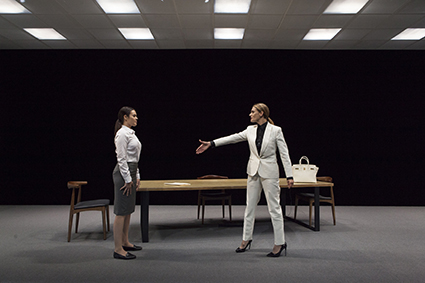
Sophia Roberts, Danielle Cormack, Sydney Theatre Company, Boys Will Be Boys
photo Brett Boardman
Sophia Roberts, Danielle Cormack, Sydney Theatre Company, Boys Will Be Boys
STC, Boys will be Boys
Thesis: if boys will be boys, will girls be boys in the corporate workplace? Australian playwright Melissa Bubnic’s Boys will be Boys is an engaging, strongly performed melodrama in the All About Eve vein (young actress usurps her elder supporter; film, 1950) set here in the contemporary finance trading world with its sexism, nepotism, crude careerism and corruption. Despite growing evidence that women bring balance and fairness to the workplace, including the corporate sector, Bubnic runs with the cliché of conversion of girl to boy with verve if not revelation.
Astrid (Danielle Cormack) is a middle-aged currency trader who has achieved much on her own terms. A loner, always playing to win, she grudgingly mentors young trader Priya (Sophia Roberts) who simply wants to make money. She simultaneously turns to a prostitute, Isabelle (Meredith Penman), who appears to be equally worldly, cynical and droll (“my father died before he could interfere with me”) for sex and companionship. Clearly Astrid is at some kind of turning point, but not enough to make a serious emotional commitment to Isabelle (whom she ‘passes on’ to her boss) or to stand by Priya when she is raped by a fellow employee (son of a wealthy client of the business) and a video of the assault handed around the office by staff. Priya, threatening to go to the police, secures Astrid’s accounts for herself along with the sacking of the offenders. McCormack vividly portrays Astrid’s loneliness (at home with a martini, Chinese takeaway and singing the blues), cut and thrust communication, anxieties and fatal rigidity. We are initially invited to identify with her, her humour, her pragmatism, her willingness to take on two new relationships, but Bubnic puts Astrid’s self-awareness and our empathy to the test. She cannot account for herself, declaring early on that she is what she is—there was no childhood trauma, no cause and effect. Bubnic implicitly asks what shaped Astrid—nature or corporate nurture?
All roles, male and female in Boys will be Boys, are performed by women—including Tina Bursill as a chillingly amiable, observant and thoroughly manipulative male CEO—but it’s hard to see why, other than heavily underlining the girls will be boys thesis. Bubnic’s 2013 play, Beached, about an enormously fat adolescent, the mother who surreptitiously fattens him—to bind him to her—and the female journalist who goes to pieces while discovering the truth also focused relentlessly on female failure, if much less convincingly and more didactically than in her new play. Boys will be Boys, with its songs, cabaret and dance scenes hovers between satire and intense drama, leaning toward the one-dimensional—there is no otherness, no counterpoint to Astrid’s descent, her aloneness makes her too easy a target. A tougher take on female ambition might have been tested not a loner but a woman with friends, a partner, interests. The Astrid we meet appears already damaged, ideal corporate material.
Red Stitch, Grounded
Melbourne’s Red Stitch made a welcome visit to Sydney with US playwright George Brant’s Grounded (see John Bailey’s review, RT122, p46) meticulously designed and directed and graced with a remarkable solo performance from Kate Cole whose highly nuanced delivery embraced and then shocked us. As in Boys will be Boys, Cole’s The Pilot is a woman in a man’s world, a top gun fighter pilot. After having a child she is assigned a role as a drone operator, a role she learns to embrace at the expense of her family (a unit she is already only provisionally committed to). If Astrid in Boys will be Boys altogether loses what sense of morality she has in a morally lax corporate world, equally The Pilot’s closed military world and drone operations guarantee not just moral failure but trauma and psychosis—her moment of insight (that she is killing a child like her own) is part of a breakdown that will not in the end liberate her because, like Astrid, she has no social or intellectual framework to make sense of it. Is the appeal of Grounded and Boys will be Boys not that they radically demonstrate how male work culture transforms women into non-women (non-lovers and non-mothers or bad mothers), or that they implicitly suggest women can neither entirely adopt male roles nor change the culture?
Sydney Theatre Company, Endgame, writer Samuel Beckett, director Andrew Upton, set & lighting Nick Schlieper, costumes Renee Mulder, Sydney Theatre, 7 April-9 May; STC, Boys will be Boys, writer Melissa Bubnic, director Paige Rattray, Wharf 2, 18 April-16 May; Red Stitch, writer George Brant, director Kirsten von Bibra, Seymour Centre, Sydney 1-16 May
RealTime issue #127 June-July 2015 pg. 44
© Keith Gallasch; for permission to reproduce apply to realtime@realtimearts.net
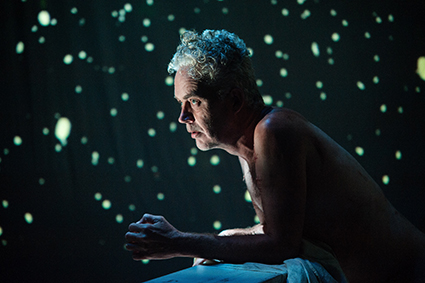
Brian Lucas, De Profundis
photo Dylan Evans
Brian Lucas, De Profundis
Director David Fenton and dancer-performer Brian Lucas have adapted Oscar Wilde’s literary epistle De Profundis for the stage. It’s remarkable that they are the first to do so, and their theatrical realisation of Wilde’s letter to his former lover (Lord Alfred Douglas, whose father hounded the pair and was ultimately responsible for Wilde’s imprisonment on charges of gross indecency) is equally extraordinary.
Fenton states, “This is not in any way an imitation of Wilde with outrageous ‘Wildean’ moments of artifice and conceit. It is rather a personal interpretation of the psychic and spiritual space of a man grappling to make sense of the Establishment’s systematic destruction of an artist and human being” (program note). This mission statement sums up the piece well. It is a 75-minute monologue—a literal speaking or acting out of the letter, the ‘prayer from the depths’—in which the performer ‘occupies’ rather than ‘does’ Wilde. This is not mimetic theatre; audience members hoping to see something equivalent to Stephen Fry ‘doing Wilde’ will come away disappointed. What we experience instead is a voyeuristic communion or an unflinching act of witnessing, of a great man stripped bare and humiliated, trying to make meaning, perhaps even art, of the shattering experience that is hard labour in a Victorian era prison.
We enter the theatre with the scenario already underway. The set designed by Raymond Pittman and Fenton reminds me of a Van Gogh straw-coloured domestic interior, stripped of its furniture. It is, of course, a prison cell. The naked performer (Brain Lucas) cowers in the upstage corner of what, at first glance, appears to be one of those perspectival modernist paintings; the lines of convergence meeting in the farthest corner make the human figure look larger than he is, but somehow at the same time shrinking, as though the scene may eventually consume him. Jason Glenwright lights the space in harmony with the pitch or timbre of the text and Pittman’s videography, projected on the cell walls, counterpoints the austerity with lavish images of ornate gilt picture frames, unfurling nosegays, snow falling (sometimes downward, sometimes up), cut crystal glasses and a beautiful youth—perhaps Bosie. It is an externalisation of Wilde’s internal life, with touchstones of the luxury and decadence he once enjoyed.
Lucas remains naked for almost the duration of the performance, and what follows is a harrowing, yet at times mordantly droll, recitation-in-counterpoint. The words (yes, 75 minutes of words from this performer RealTime readers will know for his lifetime commitment to Australian dance) are as beautiful as the video projections—searching, yearning, lyrical attempts to salvage understanding and a future from the prison experience. But the actions that accompany the spoken text reveal the true degradation of life inside Reading. Wilde/Lucas shits in a bucket, scrubs piss from the floor, fellates the prison guard, refuses food. “I was a man who stood in symbolic relations to the art and culture of my age,” he says as we listen to him recount the dizzy heights of his fame, but watch him plumb the depths. “I became the spendthrift of my own genius.”
As we listen to him ruminate on the ways in which his decadence yielded almost inevitable self-sabotage and then state-induced punishment and destruction, I cannot help but think of Myuran Sukamaran—he and Andrew Chan were shot dead on Nusakambangan that same morning—and his inverse trajectory to Wilde, from drug runner to artist, someone whose prison plight outraged most Australians. His death horrified us; so should Wilde’s have horrified his contemporaries. It did, of course, but for all the wrong reasons. I thought also of another gay playwright, Joe Orton, whose prison stint emboldened his anti-authoritarianism and soldered the rebel artist, and of Genet and his body of work that turns on the eroticisation of homo-social prison culture. Neither’s work would have been possible, politically or culturally, were it not for Wilde.
Lucas navigates the schism between what is said and what is seen in De Profundis with such dexterity. He makes himself so physically, unselfconsciously vulnerable throughout this one-man (actually, two- if you count the intermittently present, silent prison guard) tour de force. It’s grim viewing, but hypnotically compelling. Brian Lucas deals with the spoken word so cannily. I suspect what we’ve witnessed here is another transformation: of a vintage Australian performer, from contemporary dance maestro to fully-fledged stage actor. Another career turn that Wilde has helped broker.
Brisbane Powerhouse and Metro Arts, Oscar Wilde’s De Profundis, writer Oscar Wilde, adaptation David Fenton, creators Brian Lucas, David Fenton, set design Raymond Pittman, David Fenton, music David Megarrity, lighting Jason Glenwright, video Brandon Dowery; Brisbane Powerhouse, 22 April-2 May
RealTime issue #127 June-July 2015 pg. 45
© Stephen Carleton; for permission to reproduce apply to realtime@realtimearts.net
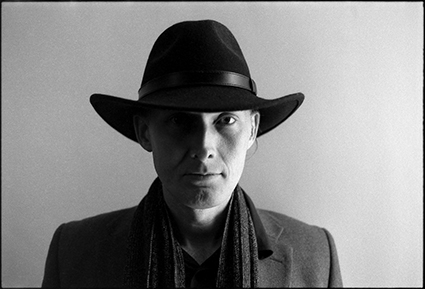
Lawrence English
photo Marc Behrens
Lawrence English
For those vague on their history (like me), the original Room40 was both the office and the group of cryptologists established at Bletchley Park in England during World War I tasked with deciphering German command codes. By World War II the team, which included Alan Turing, the forefather of modern computing, cracked the legendary Enigma Code, which is said to have significantly shortened the war.
Room40 was the inspiration, and became the name, for Brisbane-based sound artist Lawrence English for the arts organisation he founded in 2000. He explains, “That facility brought together crossword puzzlers, military experts, scientists, philosophers, bakers—anyone who was interested in code breaking and applied them to the same set of tasks…a common interest.” For English this resonated with his mission to promote the work of a range of artists with diverse musical output yet sharing “a genuine depth of interest in the sonic capacity to transform us.”
Fifteen years later and the sound and experimental music landscape is significantly different in terms of its cultural profile, relationship to other musics and its distribution channels. English has survived by being responsive and adaptable—he was an early adopter of monetised digital downloads—growing the label to include niche sibling projects such as the avant-pop-focused Someone Good and cassette imprint A Guide To Saints. English suggests that the label’s longevity has been assisted by Australia’s tyranny of distance: “I’ve never felt like I have to run anyone else’s race. I just do what I believe in and that’s been really helpful.” He also suggests that this distance gives the label a certain ‘mythology’ within the international landscape.
But of course Room40 is more than a label and distribution point. From its initial inception the organisation has also produced and promoted events starting with Fabrique at the Brisbane Powerhouse in the early 2000s, to Syncretism at the Judith Wright Centre and Mono at IMA, which continues today. English has also been involved in major festivals, acting as the Brisbane director of various Liquid Architecture and What is Music? festivals as well as his own Open Frame event. After many Brisbane manifestations (with some 10th birthday celebrations in London), this year’s Open Frame will take place in Sydney in July at Carriageworks.
Spread over two nights, the festival offers an impressive line-up of Australian and international artists who’ve either been directly released by Room40 or whom English sees as “influential” not just musically but in the way they’ve developed the experimental music milieu. One such guest is William Basinski (US). “Apart from the fact that his music is very very particular and fascinating and beautiful…[Basinski’s] Arcadia Project from New York summarises for me a certain way of making things happen and a kind of community building.”
Improviser, producer and one time Sonic Youth member Jim O’Rourke is a similar order of statesman to Basinski. He no longer travels from his home in Japan but English has been communicating with him for several years to tee up a remote presence. The result will be a multichannel pre-recorded sound work that English will “diffuse” (spatialise) over an eight-speaker set up.
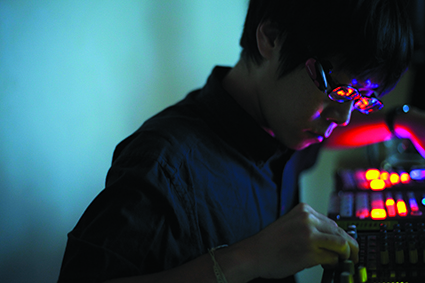
Makino Takashi
photo courtesy the artist
Makino Takashi
This year’s festival also incorporates a significant visual element. English is the first to be critical of unrigorous matching of visuals with sound suggesting that he is not interested in providing a distraction for audiences unaccustomed to simply watching an electronic artist’s minimal gestures: “I would rather listen to a really fantastic DJ play with nothing than an average DJ with some visuals.” However English believes that the artists he’s programmed use visuals in distinct and integrated ways. For example Makino Takashi from Japan creates both audio and visuals, the latter produced through a process that involves 16mm film that is digitally processed. For his Open Frame performance, Space Noise, he is working with a three-dimensional technique that differs from the standard red-blue offset method. “You really get that sense of pure psychedelia from what he does. I don’t know how it’s done to be perfectly frank, and I love it when I don’t know the magic trick.”
In fact all the visual elements are engaged with the physicality of film rather than just the manipulation of bits and bytes most often associated with electronic music. An interesting pairing of Australian artists is the much respected improvising pianist Chris Abrahams with filmmaker Louise Curham who uses hand-drawn film processes and manipulates the 16mm film live. This is a collaboration so intriguing and with so much potential it’s surprising it hasn’t happened before.
Also driven by 16mm film will be a collaboration between US filmmaker Paul Clipson and experimental pop artist Grouper (Liz Harris) presenting a long form piece, Hypnosis Display. Clipson’s methodology employs only in-camera edits. His mediation on the vast landscapes of contemporary America will be accompanied live by Harris.
Another collaboration English suggests has just been waiting to happen is between Robbie Avenaim with his SARPs project (Semi Automated Robotic Percussion System) and emerging composer Austin Buckett whose Grain Loops came out on vinyl via Room40 last year. Both artists are interrogating the very meaning of rhythm through quite different systems. English is hoping that their collaboration finds “not a middle ground. I’m hoping for a third ground—a third way.”
And finally, English himself will take the stage, something Sydney has not experienced for quite some time due to the curious lack of medium-sized venues interested in experimental music and able to facilitate a particular level of awesome subsonics. He explains, “What I’m interested in is this idea of the ‘body as the ear’ and a kind of synaesthetic turning point between touch and listening. To do that you need to have PA that can put out the right sound pressure.” If his performance at UnSound in Adelaide earlier this year is anything to go by, this will be unmissable (see RT126, p11).
After 15 years, does English see Room40 continuing indefinitely? “I have no interest in this idea that you can do, so you do. I’m really critical of what Room40 is about, but I think that criticality is a positive thing because it means it doesn’t become stagnant and one-dimensional, which anything can over time. I just want it to remain a little bit fugitive and restless because that’s what keeps it interesting for me and other people.”
See also Gail Priest’s 2014 profile on Lawrence English.
Room40: Open Frame, Carriageworks, 30-31 June
RealTime issue #127 June-July 2015 pg. 47
© Gail Priest; for permission to reproduce apply to realtime@realtimearts.net
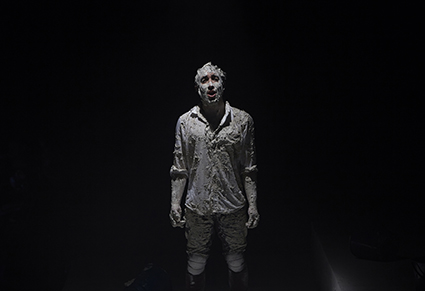
Brenton Spiteri, Fly Away Peter, Sydney Chamber Opera
photo Zan Wimberley
Brenton Spiteri, Fly Away Peter, Sydney Chamber Opera
On a vast broadly stepped space, its flat white surfaces thickly textured, three people delight in the Australia they love and conjure in song—a particular landscape, its skies and, above all, its birds. The Great War takes two of them in body and one in spirit to the Western Front where they agonisingly delineate its horrors. Home or war, it’s the same abstract space—a designer’s tabula rasa for our projections (aided by haze, colour shading and silhouetting in battle scenes). The landscape’s whiteness now ironic, the muddiness of trench warfare is evoked by the white clay with which, aided by his comrades, the dying Jim coats himself, becoming one with the earth he acknowledges as his being: “grains of this body loosening.”
Composer Elliott Gyger’s glorious soundscape lends hearing to our landscape imaginings: with glissandi, microtones, harmonics, warbling, cries and whistling the chamber ensemble evokes pervasive birdcall, the rumbling trombone becomes an aeroplane and trumpet and trombone lead the musicians in a raucous march into the aural terror of industrial-scale warfare. Just as fine is the sense of transcendence—experienced by Jim, the protagonist of David Malouf’s novel Fly Away Peter—made musical. Like most modern operas on first hearing there’s little that is melodically memorable, but tensions, textures and states of being (contemplation, anger, fear: Jim’s haunting falsetto on “Am I dead?” and his silence after singing “I just want to make that sound [of fear] with you”—he soon does), can all be vividly recalled, the shape of the drama moreso than its music.
The fine actor-singers (Mitchell Riley, Brenton Spiteri, Jessica Aszodi) are at turns lyrical, passionate and anguished and their diction and acting excellent—particularly Riley with his easy presence and acute sense of physical and emotional detail. His performance in Gyorgy Kurtag’s …pas à pas–nulle part for Sydney Chamber Opera was equally memorable (RT119, p16), although more is demanded of him here.
Read David Malouf’s Fly Away Peter and you will find yourself immersed in the discrete consciousness of each of its three principal characters—Jim, Ashley and Imogen—in turn. In composer Elliott Gyger and librettist Pierce Wilcox’s opera adaptation, we encounter the protagonists as a trio, and although each has moments relatively alone, they share the same narrational, psychological, musical and stage space, three minds and bodies as one, embodying vocally the novel’s highly focused interiority and empathies, a world—as in the original—in which little is directly spoken between them.
If you know the novel you’ll most likely grasp what’s going on onstage, but if not, the experience of the opera will undoubtedly be impressionistic—the narrative floats in and out of focus, there’s uncertainty at times about who’s who. Spiteri plays all the secondary characters and Aszodi enacts a symbolic and choral role, for example in the laying out of a World War I memorial graveyard. Instead of allowing us to spend ample time with Jim initially, to shape our awareness of his love of birds and his ability to see the land ‘from above,’ the opera’s prelude introduces us to him, all too briefly, briskly adding his peers in chorus—Ashley (Spiteri), the enlightened, young wealthy landowner who asks Jim to manage his property as a bird sanctuary, and Imogen (Aszodi), a photographer. Their ‘out-of-time’ reverie celebrates their companionship and a joint passion to “fix the bird for eternity”—preserving, documenting and photographing. It’s difficult to fix on identities and relationships. Gyger and Wilcox then commence the narrative proper—with Jim and Ashley’s first meeting—unfolding it scene by scene, essentially in the complex trio form, doublings and with episodes that lack clarity—the Brisbane march in support of the war, just what it is a fellow soldier, Clancy, is asking Jim to do, and the discovery of mammoth bones in the trenches.
The decision to make the trio the musical centre of the opera, although admirable, has enormous ramifications for the dramatic construction of Fly Away Peter—doubtless there was much dramaturgical effort on the part of director Imara Savage to accommodate the consequent challenges, some deftly solved, others not. What could have been as lucidly accessible as the novel has become an opera that is in equal parts engaging and distancing. Fortunately, the final scenes are clearer, Jim sensing the war will go on forever, curious that “We do not meet the men who kill us,” and hovering between horrendous reality (the surgical butchering of the wounded) and redemptive dream (new, farmed growth in battle wasteland).
Enhancing the opera’s theatricality, Wilcox makes much of lists of the names of birds and soldiers, repeated phrases for the trio and spare sung dialogue, drawing closely on Malouf. Savage’s direction, using the entire width and height of the set, alternates her staging between stillness, physical tension (Ashley’s firm grip when Jim resists boarding the aeroplane), speed and violence (Jim’s raw battle with a hostile fellow soldier who turns out to be equally frightened). Before dying, before merging with the earth, before the final stillness, Jim sits, leans right, head in hand, nodding slightly in the most affecting image in the opera (sung as “a woman inside who rocks back and forth”). Mitchell Riley conveys much with simple expression and gesture, Elliott Gyger with a small, powerful ensemble and Imara Savage with a simple if monumental design by Elizabeth Gadsby.
If the trio structure makes the opera less than lucid and there are a scene or three too many, the excess I took exception to was Wilcox’s attempt to make the opera ‘universal,’ with a sentimental authorial intrusion at odds with the novel’s (and largely the opera’s) masterful realisation of Jim and Ashley’s limited worlds. He adds lists of the war dead, German, Italian and others. Although Jim might muse, “We do not meet the men who kill us,” these two profoundly inarticulate men, who sing their thoughts, have little consciousness of their enemy, let alone a wider world. Jim’s insight comes when he envisages the war from the air (“like building a pyramid”) and fears it is eternal.
While the novel’s ending is transcendent—Jim immersed in his vision of oneness with the earth and, finally, Imogen, her friends dead, inspired by the sight of a young man (a surfer) ‘running on the water’ and believing “the past will not hold”—Wilcox and Gyger end the opera ambiguously, their focus on the dying Jim, an image at once painfully tragic and musically liberating, realising the opera and the production’s potential.
Fly Away Peter has been another success for Sydney Chamber Opera, as ever meticulously and effectively conducted by Jack Symonds. Next to the superfluities of its last production, Mayakovsky, Fly Away Peter leans towards but does not achieve the clarity of earlier SCO productions. If it should be remounted, and it deserves to be, that’s an issue for composer and librettist. Too often, almost-there creations in Australia are not done the justice of re-working.
Carriageworks & Sydney Chamber Opera, Fly Away Peter, from the novel by David Malouf, composer Elliott Gyger, librettist Pierce Wilcox, director Imara Savage, conductor Jack Symonds, musicians James Wannan, Jaan Palandi, Peter Smith, Alison Evans, Rainer Saville, Matthew Harrison, Alison Pratt, design Elizabeth Gadsby, lighting Verity Hampson, movement Lucas Jervies; Carriageworks, Sydney, 2-9 May
RealTime issue #127 June-July 2015 pg. 48
© Keith Gallasch; for permission to reproduce apply to realtime@realtimearts.net
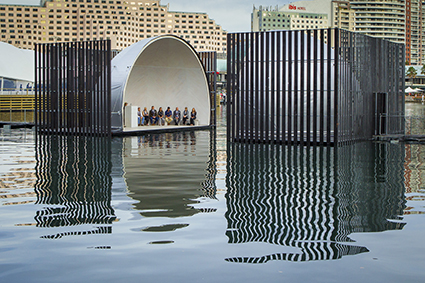
Nomanslanding
photo courtesy Sydney Harbour Foreshore Authority
Nomanslanding
When I venture to Sydney’s Cockle Bay in Darling Harbour to experience Nomanslanding, one of a number of public art projects around the country commemorating the centenary of the ANZAC campaign at Gallipoli, the weather is fittingly bleak and rainy, effectively buffering the touristic glitz of the area and applying a good measure of melancholy to this moving (literally and metaphorically) meditation on the ravages of war.
An amazingly ambitious project, Nomanslanding is initiated by the Sydney Harbour Foreshore Authority in partnership with Glasgow Life and Urbane Künste Ruhr. It has been created by an impressive collaborative team of artists each with significant experience in public and environmentally embedded art—Robyn Backen, Nigel Helyer and Jennifer Turpin from Australia, Graham Eatough from Scotland and Andre Dekker and the Observatorium team from the Netherlands. After its premiere in Sydney the work will find its way to the River Clyde for Glasgow’s Merchant City Festival in July and then to the harbour of Duisburg Ruhrort in Germany for the Ruhrtriennale Festival of Arts in August.
Arriving for a 30-minute session, audiences can choose to enter from either end of the bay, effectively taking sides and becoming one of the red or blue squads. Briefing happens in an army tent where we are asked to sign off on a disclaimer that runs to around 20+ OH&S items (ah, the logistics of public art in Australia). We are then issued with nifty, compact life jackets and led across the bay on a bobbing walkway to a half-dome. Here we face the ‘enemy,’ the other squad in their half-dome, but we are separated by a watery gap. Sitting around the edges of the space we hear whispers skitter, seeming to emanate from alarmingly specific points, behind, above and opposite. It’s a collage of English and German—lists of personal items, fragments of letters, the voices of women left behind. Then sounds of war begin to escalate and the half-domes start to silently slide towards each other. After a cacophonic moment of warfare, the two halves seal as one and envelope us in darkness.
We are given a few moments of silent contemplation before an achingly pure female voice is heard sounding like an amplified recording; but then a small (electric) lantern is lit to reveal a lone woman in white. She sings a haunting air—a beautiful melange of Celtic and European folk influences telling of rivers and tears and shores in several languages (lyrics by Graham Eatough, Andre Dekker, music in collaboration with Cora Schmeiser and Ben Fink). It is now that we really experience the magic of this structure. Near the centre of the space the acoustic properties of the dome amplify the singer remarkably, as if she’s miked. If she moves a metre either side, the intensity changes dramatically. If she goes to the edge of the space her voice slides over the roof, issuing forth from the opposite side. Finally her moving song sung and the official experience over, we are encouraged to stay and play with the acoustics of the space.
Nomanslanding is a well-balanced public art experience: it offers a sense of gentle adventure in the physical navigation of the space; allows for wonder as we explore the installation’s seemingly magical properties; and gives time and space for contemplation on its themes of war and reconciliation. There is no denying the significant metaphorical power of the structure, however I did want a little more actual content once in the middle of the experience. The recorded soundscape in the dome is on the edge of ambient and feels constrained, almost as if afraid of lapsing into cliché. Or is it a tentativeness around the listening attention spans/tastes of audiences? However the experience really becomes charged when the live performance commences. Perhaps now that the monumental effort of construction and logistics is complete, the sonic and performative content of the work might be expanded.
While the practices of certain artists with whom I am familiar are evident—Nigel Helyer’s sono-nautical explorations and Robyn Backen’s ongoing work with whisper domes—it is the cohesiveness of Nomanslanding’s large-scale vision that most impresses. It feels like a truly collaborative project drawing on the collective experience of the artists and curators to create a work that is far greater than any individual might have managed. This sense of collaboration adds tangible weight to the idea of reconciliation, forgiveness and reclamation, making Nomanslanding a significant and poignant public artwork.
After my session I stand on the shore outside the IMAX and watch the structure open and close again. Two seagulls are hitching a ride, one on each half. As the dome comes together they indulge in some mutual grooming, a gentle intimacy I don’t associate with these greedy, squawking birds. The metaphoric power of Nomanslanding is strong indeed.
Nomanslanding, Sydney Harbour Foreshore Authority in partnership with Glasgow Life/ Merchant City Festival and Urbane Künste Ruhr/Ruhrtriennale Festival of Arts; curators Katja Aßmann, Michael Cohen, Lorenzo Mele; artists Robyn Backen, Andre Dekker + Observatorium, Graham Eatough, Nigel Helyer, Jennifer Turpin; Cockle Bay, Darling Harbour, Sydney, NSW Centenary of ANZAC program
RealTime issue #127 June-July 2015 pg. 50
© Gail Priest; for permission to reproduce apply to realtime@realtimearts.net
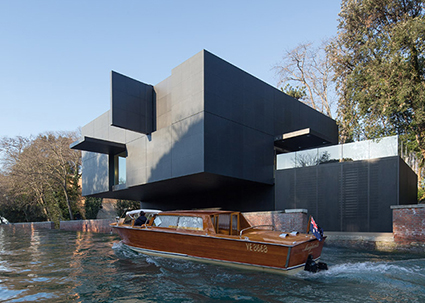
new Australian Pavilion
As Australia unveils its new 21st century pavilion this year, many other national pavilions within the Venice Biennale’s Giardini are being ‘veiled.’ The pavilions of Canada, Israel, Austria and Greece are actively disguised or altered by their artists. Others are swamped with liquid, or littered with broken glass, in each case drawing our attention to the building’s architecture, the function and politics of the Giardini allocations or even the limitations of possessing these much sought after permanent national pavilions.
The artist collective BGL hides the Canadian pavilion under scaffolding, transforming the building’s entrance into a tiny corner store. From the scaffolding, we are invited to drop coins through a maze into the glass windows. These windows—an important element of the Archimedean spiral-inspired structure—no longer function as the building’s exterior, but rather as an element of play within. Similarly, Israel’s Tsibi Geva drapes their pavilion under a grid of more than a thousand tyres—a coating that evokes danger in both sight and smell.
Leaving the exterior untouched, Austria’s Heimo Zobernig transforms his national pavilion’s distinctive arches and multi-level floor into a pared-back space. The 1930s building was designed by Joseph Hoffman and Robert Kramreiter, and is celebrated for its innovations in early Modernist gallery design. One of the key practical design characteristics is the diffused natural light source, which Zobernig has blocked with a low black ceiling and coupled with an equally oppressive floor. We are denied all reference to the already relatively minimal interior. Without the few distinctive features, we focus on the empty space and, amusingly, the expressions of the confused visitors who wander around the building looking for the artwork. It’s a very different experience to the narrow maze-like structure built by Austria’s 2011 representative, Markus Schinwald. Like Zobernig, he viewed the high ceiling, central raised entrance and long split interior as problematic, installing white painted ply to block both the ceiling and exterior approach. The notion that their building is ‘difficult’ to work with seems to be fairly consistent across many of the pavilions and, paradoxically, these ‘problems’ have inspired some engaging installations in response.
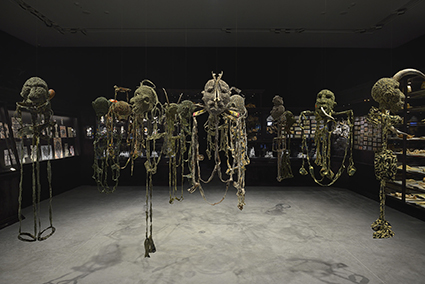
Fiona Hall, All the Kings Men (2014-15), Australian Pavilion
photo Christian Corte,courtesy the artist and Roslyn Oxley9 Gallery, Sydney
Fiona Hall, All the Kings Men (2014-15), Australian Pavilion
Opposite Austria’s pavilion is Greece’s equally symmetrical, but more decorative building. Its patterned exposed-brick exterior, portico and marble columns stand in contrast to the grimy recreation of a leather workshop within. Maria Papadimitriou’s installation is a replica of a shop in the Greek city of Volos, the celebratory exterior enhancing the impact of the raw and chaotic interior. It works in a similar way to Mike Nelson’s 2011 immersive environment within the Neo-Palladian British Pavilion, the interior of which he also referred to as ‘difficult.’ His aim was to “displace the viewer to another place,” and like Papadimitriou’s installation, the building’s romantic exterior acted as an important foil to the dark labyrinthine construction within.
Some of the more aggressive interactions with these buildings could be considered negative, but perhaps they simply communicate underlying cultural anxieties. The pavilions carry societal baggage—both positive and negative—having been designed or adapted according to the fashions, values and aspirations of the day. The USA’s 1930 Neo-Palladian building, for instance, reflects a certain cultural conservatism, while the redesign of the Greek and German pavilions in the same period contain nationalistic themes in line with their politics.
Australia’s former pavilion (architect Philip Cox, 1988) with its humble curved corrugated iron roof and wooden deck, was distinctly Australian. Its replacement (Denton Corker Marshall, 2015)—a mysterious solid black cubic structure that stands apart from its neighbours—is indicative of the image Australia now wants to project. The original was always described as temporary; however, the majority of the buildings within the Giardini were built in the spirit of impermanence and it’s only in the last 20 or so years that the buildings have remained fairly static. Those built in the early 20th century included apses and columns to accommodate sculptures, just as the architects of the new Australian pavilion have created a white cube in the name of ‘neutrality.’ The simple flat-walled interior definitely gives the illusion of a blank slate—a very literal response to the constant criticism of the old pavilion’s ‘difficult’ two-tiered space, which in itself inspired a work by Daniel von Sturmer in the 2007 Biennale.
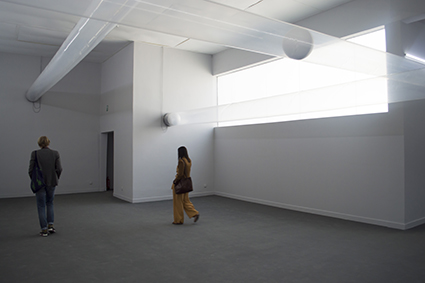
Helmo Zobernig installation, Austrian Pavillion, 2015
photo Henry Hawthorne
Helmo Zobernig installation, Austrian Pavillion, 2015
For the new pavilion’s inaugural exhibition, Fiona Hall has darkened the walls, using vitrines and spotlights akin to the aesthetics of a natural history museum. There are no stairs to get in the way; no marble columns or apses carrying cultural baggage; no courtyards or pesky internal tree trunks, though these distinctive features have over the years inspired engaging and critical artistic responses.
There are 30 permanent national pavilions within the main Giardini site, while 30 countries have temporary ‘pavilions’ at the biennale’s other key site, the Arsenale. The remaining 31 have established temporary exhibition spaces around the city in palaces, shop fronts and churches. The allocation of permanent Giardini space is undeniably political. The first pavilions were allocated to colonial powers like Belgium in the early 20th century, and today, the list of represented countries largely mirrors real life global power. A site within the Giardini carries prestige, a guaranteed audience and in the opening three days it is the first place the media flocks to. But for countries without these sought-after sites, the opportunity to choose a location can be used strategically; New Zealand’s artists, for example, have consistently demonstrated the benefits of working outside these permanent spaces.
New Zealand is a relative newcomer to the Venice Biennale, participating for the first time in 2001. While many countries excluded from the Giardini set up pavilions in the snaking Arsenale warehouse, the sites chosen by New Zealand in recent years have either been specific to the artwork or used to enhance elements in it. Michael Parekowhai’s 2011 contribution and Francis Upritchard’s 2009 work used elements of their grand surroundings strategically and sympathetically. Upritchard’s petite figures, for instance, were installed in the rooms of an ornate neo-classical palace. Placed on simple tables, some of the colourful human figures gazed into the room’s cloudy mirrors, but were not site-specific per se. They were sensitive to their surroundings, and in turn, the environment subtly altered and enhanced the artist’s work.
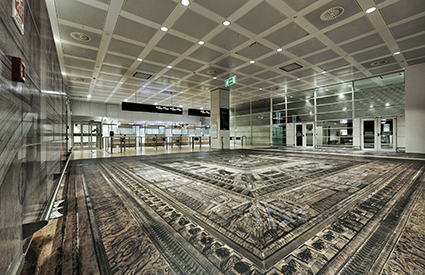
Secret Power, Simon Denny, Marco Polo Airport
photo Paolo Monello
Secret Power, Simon Denny, Marco Polo Airport
This year’s representative, Simon Denny, uses multiple sites, one old and one new: the ornate Renaissance-era Marciana Library in Piazza San Marco and the arrivals area at Marco Polo Airport. Secret Power is inspired by Edward Snowden’s top-secret USA intelligence leaks, exploring power relations in an age of global telecommunications. Photos of the library’s celebrated interior are plastered on the floor, walls and luggage carousels in the airport’s secure arrival zone. Even though I’m aware of the installation beforehand, I walk past the decoration without thinking because in an age of visual communication and marketing, I have learned to block out advertising strategies that use this kind of pictorial language. In a way, my unconscious dismissal indicates the work’s success, particularly as Denny’s installation in the library interrogates the way in which visual communication and play can be used to conceal knowledge and influence unconscious behaviour.
As Denny’s site-specific artwork demonstrates, for countries excluded from the Giardini ‘club,’ Venice provides a rich source of sites for critical engagement. However, no country would give up a spot in the Giardini. The location brings much-desired media attention and a guaranteed audience, which, in an art world dominated by marketing and hype, trumps ease and flexibility of site every time. The inflexibility and ‘difficult’ spaces consistently cited by artists working within the Giardini, is not necessarily a negative; after all, these loaded spaces have inspired some of the most interesting artworks of this year’s biennale. The Giardini’s history is fascinating; not only does it map a century of cultural and political power, it has also survived fascism and contains an unparalleled mix of architectural styles that trace the aspirations of countries over time. Difficult or not, it’s a site that begs for artistic response.
Venice Biennale 2015, 9 May-22 Nov
RealTime issue #127 June-July 2015 pg. 52-53
© Lucy Hawthorne; for permission to reproduce apply to realtime@realtimearts.net
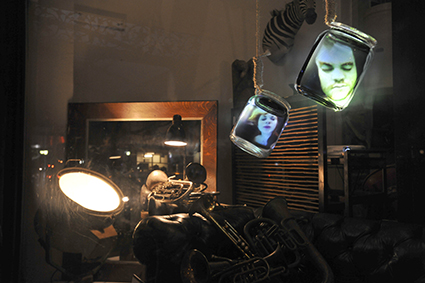
Young Blood, Arika Waulu, Gertrude St Projection Festival, 2014
photo Bernie Phelan
Young Blood, Arika Waulu, Gertrude St Projection Festival, 2014
For its eighth year, the hugely popular and aesthetically innovative Gertrude Street Projection Festival has been curated for the second time by festival co-founder and executive producer Kym Ortenburg and Yandell Walton—one of the featured artists of the second festival. Walton says, “I was really interested in volunteering for the festival to try to get a really good mix of contemporary art and community projects within its 30 to 40 sites. I think throughout the selection process that has been a really strong focus for us so it’s not outweighed by one side or the other.”
Ortenburg, with a background in producing, says that some years ago she attended the Australian Television & Radio School “and was always very interested in light. Yandell’s background as a visual artist and my more moving image, video-based and film location interests have combined. We both bring particular aesthetics to the festival and both very much enjoy the idea of projection being site-specific. I think that’s where our collaboration works the best.” Walton adds, “Another focus has been to provide a platform for emerging artists or artists who have not necessarily worked within the medium and offering them technical support. I’ve done a lot of mentoring and projection workshops. This year we’ve picked a lot of artists who might not necessarily have the skills but with our team we can make it happen.”
Ortenburg says of projection art, “it’s come a long way in a very short space of time. Yandell was one of the early artists and [others such as] Kit Webster, Hugh McSpedden and Ian de Gruchy even earlier. These are among the people who first started to look at the whole idea of site-specific projection art. And now it’s come to the forefront in the minds of many artists really interested in combining their passion—whether it’s sculpture or visual art or animation art—and the [realisation] of it in a specific site.”
In Europe and the UK, and in Melbourne, there are large screens in public squares. What’s the difference between showing works there and in a suburban street?
Ortenburg suggests, “this type of event gives the community—the artists and the audience—new ways of looking at something that’s quite familiar. The streetscape that they walk up and down all the time is suddenly transformed [and they experience] a new and different way of looking at it, either visually and aesthetically or just the notion that you’re drawing attention to something.” As an example she cites very large projections onto the Atherton Gardens Housing Commission Estate in the 2014 festival. “That really transformed both the people who live there and the people who walked by and hadn’t really thought about social housing. Suddenly it became an incredibly magical canvas that had great impact.”
During the festival, is there a sense of Gertrude Street itself being full of light and magic?
“Yes,” says Ortenburg, “people give us a lot of feedback about that very fact. It brings everybody out into the street. It’s freezing cold, it’s dark, it’s Melbourne in July so to get thousands of people out, of all different ages from 6pm till midnight is a pretty fabulous achievement! And the audience, the residents and the artists are all part of a community. It creates its own little sphere of ‘magic’ in the middle of Melbourne winter.”
How much do the works vary in scale and how are sites selected?
Walton says, “we have massive building projections but also much smaller works. We have works that use mini-projectors and some that combine projection with traditional mediums like painting and sculpture. You can project onto anything, so a lot of the works are not [conventionally] screen-based at all. They’re using, for example, a transparent material to suggest a ghost-like figure. Or they’re projecting within a space that also has objects in it so they’re creating more of an installation rather than just a projection. It was really obvious this year reading the applications that younger artists are using projection in many different ways, combining disciplines, which is so exciting for me. As a visual artist myself, I’ve never really done screen-based work; I’ve always pushed projection into more of a spatial practice and, clearly, younger artists are doing that more and more.”
The co-curators offer as an example Dalton Stewart, “a painting student at VCA who has not worked with projection before and will project an animation onto a painting he’ll hang.” Walton offers another example, “Arika Waulu’s Young Blood involves projection onto cowhide. The projected imagery is just as important as the object itself in the reading of the work. I’m also co-curating with Arie Rain Glorie a [complementary] show at Seventh Gallery that’s looking at projection conceptually in which the five artists are not necessarily using projection machines—it could be light as in neon art. We’re giving the general public access to contemporary art and ideas of projection.”
Are there film and video makers among the festival artists?
“Cinematographer Chase Burns submitted a very big work we’re projecting on two sides of the Builders’ Arms Hotel, which is on a corner.” Ortenburg notes that the festival street works do not have sound; “this challenges filmmakers and creators of video installation to create images that can hold an audience without it. That’s always interesting to see because sound is such an important component of film.” Established dance filmmaker Sue Healey is included in the Gertrude Contemporary gallery with her work On View.
Just how important is site?
Walton responds, “It’s massive, from choosing the artists to negotiations to do with site. We have to get permission for the sites and [sometimes] have to go back to the artist and say, this is the site we’ve got, can you work with it? Each work is different; each site is different. You’ve got totally site-specific works that are mapped and logistically site-specific but conceptually as well. So it’s huge! That takes up the most time in this whole business.”
What’s an example of a work engaging with a site?
Ortenburg says that Arika Waulu’s cowhide screen work is displayed “within a very eclectic shop called Tarlo and Graham which sells antique exotica. Arika’s work sits within this aesthetic as well. The projections are of protests in relation to the closing of remote Aboriginal towns and communities in Western Australia; these have been intercut with images of earlier protests.”
How are most works seen?
“We have two works,” says Walton,” that involve going into restaurants, all the others you see as you walk along Gertrude Street. In terms of scale, there are some you can see from a car or a tram because they’re so big. With others you get most impact as you walk. It’s only a kilometre long and there are 35 works along the way.” Ortenburg adds, “Some of them are quite discrete so you have to really look. People enjoy that process of seeking out the projection and seeing how it’s interacting with the site and the streetscape.” RT
Gertrude Street Projection Festival, director Nicky Pastore, co-curators Yandell Walton and Kym Ortenburg, Fitzroy, Melbourne, 10-19 July
RealTime issue #127 June-July 2015 pg. 54
© RT ; for permission to reproduce apply to realtime@realtimearts.net
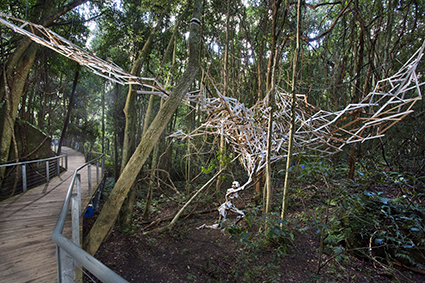
Elyssa Sykes-Smith, A Canopy of Thoughts
A high wind blows across Katoomba on the morning of my visit to Sculpture at Scenic World, whipping tourists’ hair into haystacks at the cliff-top entrance. Five hundred and forty-two metres below, however, in the pocket of Jurassic rainforest where this annual exhibition is installed, all is sheltered. There are three ways you can reach Sculpture at Scenic World: either by the celebrated near-vertical Scenic Railway, by cable car, or on foot along one of the Jamison Valley’s public walking trails.
On this occasion, the cable car provides a vertiginous, spectacular descent. On the way down, Fransesca Mataraga’s 2240cm-long striped banner can be seen twisting in the wind between the twin, very straight and supremely tall eucalypts to which it’s attached (installation carried out by a courageous arborist). This year’s judges, curator Anne Loxley, Blue Mountains sculptor Clara Hali and Emeritus Professor David Williams, have selected 31 artists for the exhibition, now in its fourth year (and the first for Exhibition Manager Justin Morrissey, taking over from Lizzy Marshall).
While last year’s selection explored the relationship between the machine-made, the hand-made and the natural, as well as more straightforward modernist and/or playful installations, this year’s emphasis is on organic, enigmatic works that seek to mimic their environment to create a camouflage effect that, while posing challenges for photographers, makes us alive to the forest’s intricacies. Greer Taylor’s Reciprocity, for example, reveals itself as a mass of suspended twigs and slim black rods, meticulously designed to be elevated as a body. The result is of a harmonious increase in the density and detail of the landscape: a shimmering spatial dialogue between artwork and forest.
Deborah Redwood’s brightly coloured Sacred Vines snake along the forest floor in imitation of the natural vines that proliferate here. The delight the eye takes in tracking these sinuous forms is perhaps at odds with the work’s intent; by placing her artificial, non-functional vines (made of discarded consumer materials) alongside real ones, which are innately non-wasteful, Redwood is commenting on human waste and excess. An environmental message is also implicit in Michael Shiell’s Fools Vessels: Balance, a delicate wire canoe that appears to float in the air, strategically suspended by two counterweights. Shiell used wire from farm fences in western Victoria that had been destroyed in a once-in-200-year flood event on the Wimmera River in 2011. The work’s allegorical title, source of materials and precarious equilibrium all express concerns about climate change.
Installations by Stevie Fieldsend and Marcus Tatton intimately engage with this particular place. With Mysterious Threshold, Tatton places several upright bundles of twigs, coloured in parts, at intervals on the forest floor. Emerging subtly from the landscape, they intrigue with their suggestion of unknown rituals. Fieldsend’s Bulging Ichorous magnifies the forest’s small wonders through a group of carved black wooden stumps that look as if they belong here, each topped with an enticing glass globule suggestive of sap or dew.
The very title of Somchai Charoen’s Landmind suggests a sinister examination of the landscape. The artist’s pastel flowers dot the forest floor, their prettiness belying the deadly mechanism represented beneath. They create in the viewer a distinct sense of virtual unease, forcing contemplation of a very real global evil. Lang Ea’s disembodied heads litter the landscape in a similarly disquieting way, also symbolising the aftermath of war.
Bringing a less grim sense of human perspective to the landscape, Motoko Katsuta Kitano’s Dream/Yume is heard before it is seen as the strains of Twinkle, Twinkle, Little Star play through the forest. Around the corner, the atmosphere of surreal lullaby is realised in the form of a child’s cot through which a tree grows. Further up the slope are two double beds, one covered in moss, the other made of mirrors. Hiding in plain sight, they are the stuff of mysterious fairytale, suggesting a humanity reclaimed by nature. Continuing the domestic theme, Sandra Nyberg’s Heritage is a timber house frame, an elegant drawing in space that refers to both Hill End miners’ huts and modernist Scandinavian design. Echoing the actual reconstructed miner’s hut the viewer passes on the boardwalk, it also serves as a ghostly reminder of the region’s coal-mining history.
With a great sense of sweeping motion, Elyssa Sykes-Smith’s modernist assemblage of angular timber pieces, A Canopy of Thoughts, shows a lunging female figure whose upraised arms join and transmogrify into a spreading cloud of timber bars above, which in turn merges with the forest. The winner of this year’s competition, it’s a technically accomplished, rather heroic piece. In common with many sensitive works in this exhibition, its synthesis into its environment is such that it might almost have emanated from the forest itself.
Sculpture at Scenic World: 2015 Exhibition, Katoomba, NSW, 15 April-10 May
RealTime issue #127 June-July 2015 pg. 55
© Katerina Sakkas; for permission to reproduce apply to realtime@realtimearts.net
Please note you can nominate for ONLY ONE GIVEAWAY.
Email us at giveaways@realtimearts.net with your name, postal address and phone number. Include ‘Giveaway’ and the name of the item in the subject line.
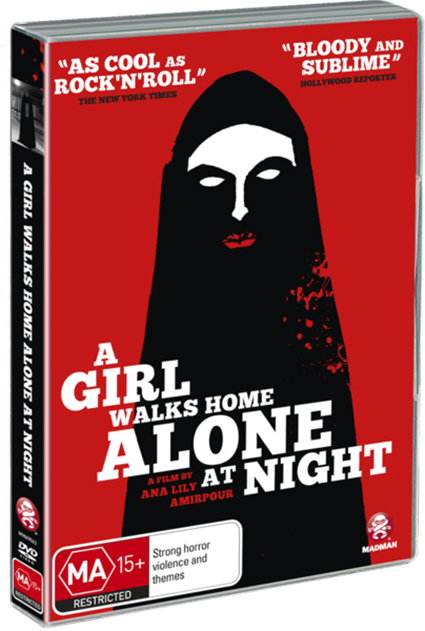
DVD: A Girl Walks Home Alone at Night
Ana Lily Amirpour’s debut feature cultivates a mysteriousness beginning with its setting, the fictional Bad City, a Persian-speaking semi-rural town where dead bodies are daily dragged into a ditch on the outskirts with no explanation. Bad City is simultaneously of the East, with its language, glimpses of Islamic TV and title character’s chador; and of the West, with its stylistic nod to the Western and its allusion in name and noir-ish graphic aesthetic, to Frank Miller’s quintessentially American comic and film series, Sin City. Katerina Sakkas (see the full review).
5 copies courtesy of Madman Entertainment
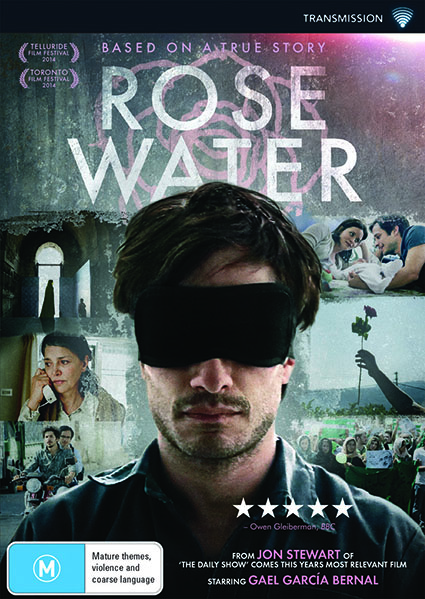
DVD: Rosewater
Fans of The Daily Show will know the story behind the making of this labour of love by host Jon Stewart. Starring Gael Garcia Bernal, Rosewater is based on the memoir Then They Came for Me by Iranian-Canadian journalist Maziar Bahari (with Aimee Molloy), charting Bahari’s imprisonment for 118 days in Iran’s Evin Prison as a consequence of participating in a satirical interview with Daily Show regular Jason Jones. At a time when journalists around the world are subject to harassment, imprisonment and, often, murder, Rosewater is an important film.
5 copies courtesy of Transmission Films
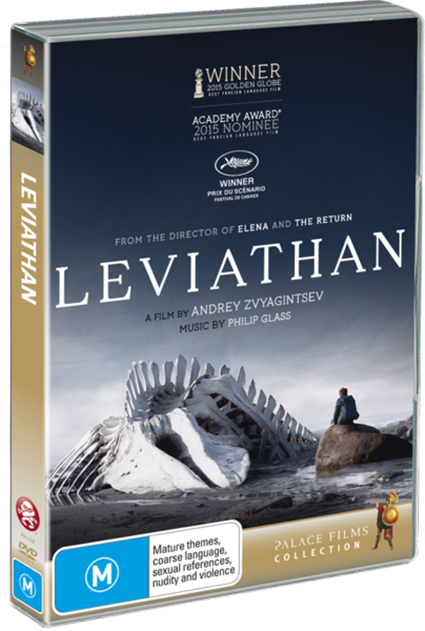
DVD: Leviathan
Directed by the maker of The Return and Elena, Andrey Zvyagintsev, Leviathan was Winner of this year’s Golden Globe award for Best Foreign Language Film, if little appreciated in Putin’s Russia because of the film’s focus on the destructive tensions created by class, faith and corruption and their intertwining. The Mayor of a coastal village near the Barents Sea in a Northern Russian town is in cahoots with developers to compulsorily acquire land, but the owner fights back with the help of a lawyer friend from Moscow. A bold psychological and socio-political thriller, Leviathan is beautifully shot and powerfully acted.
3 copies courtesy of Madman Entertainment
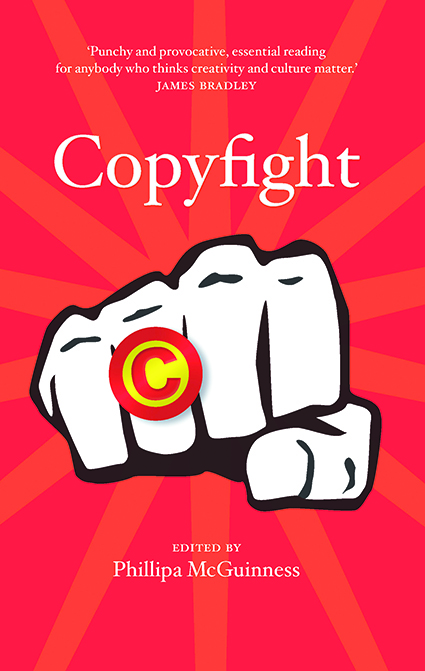
Book: Copyfight
Copyfight is an important book, a response in cultural terms to the demolition of artists’ incomes, and thereby the arts, occasioned by illegal downloading reinforced by Copyleft rhetoric about creative freedom—the freedom in fact for people who otherwise would not steal to righteously plunder the works of filmmakers and writers, and freedom for the likes of Spotify to make the most out of content providers’ copyright property by paying them as little as possible. Editor Phillipa McGuinness’ witty, informed introduction surveys the issues and the vigorous essays that follow, by Linda Jaivin, Joes Borghino, Marc Fennell, John Birmingham and others, assay both sides of the argument.
3 copies courtesy of NewSouth Publishing
RealTime issue #127 June-July 2015 pg. 56

Mahtab’s 9th birthday
The programming of Motion Pictures, A Festival of New Cinema by curators Kate Blackmore and David Capra defined what’s ‘new’ by looking back to the past and into the future. They led a willing audience, on foot through Fairfield from a cinema site of the golden age of movies to gallery video art, digital spectacle (in another abandoned cinema) and competition screenings of works by the next generation of filmmakers. We were indulged with afternoon tea at the exotic Stars Palace Reception Centre, watching Tracey Moffat’s wickedly funny and socially revealing Love (2003), which resurrected further movie memories.
Fairfield once boasted the 1,700-seater Crescent (1934-67), built by A J Beszant, whose cinemas flourished in suburban Sydney from the 1930s to the 90s. His Palatial Theatre in Burwood had almost 2,000 seats. The last Beszant cinema was sold in Cooma in 1995. On the street outside what was once the Crescent we heard from John Kirkman (Executive Director of Information Cultural Exchange, ICE] about the history of the Beszant enterprise and from senior citizens who relished their memories of the cinema’s heyday. Then we signed waivers so we could wander the ruin, a vast space stripped of its movie house furbishments. We could only imagine.
At the end of the day we gathered in another cinema, the gutted 1980s Forum to witness Pia van Gelder’s Harmonious Field Studies: an engrossingly evolving interplay of sound and imagery projected on a huge bare wall where once stood a screen. This felt a very strange mix of past, present and future.
Earlier at Powerhouse Youth Theatre recent works by Shaun Gladwell, Angelica Messiti, Shaun Rafferty and Soda_Jerk provided an apt prelude to brief talks that told of the breadth of the motion picture experience for viewers and participants. Craig Anderson spoke about the ‘special interest’ favourites in his 8,500-strong VHS cassette collection including one by the parents of Sylvester Stallone, Al Pacino and Dustin Hoffman who, having appeared in Richard Simmons’ tapes of exercises for the aged, ripped him off with one of their own. Maria Tran, showing thrilling footage from her career as an Asian action movie actor and stand-in spoke about the advantages of making YouTube ’tests’ to get film projects going.
Ali Khadim (who featured on skateboard in Shaun Gladwell’s Midnight Traceur, 2011 in the gallery) discussed the need for realism in action picture editing; Isobel Parker Philip pondered our multiple selves as we watched Gene Kelly dancing with his life-of-its own mirror self in Cover Girl (1994); and Oscar winning costume designer Tim Chappel spoke of the joys of creating outfits as alien as possible for Priscilla Queen of the Desert (1994). The subsequent screening of Khaled Sabsabi’s Guerrilla (2007) with its triptych-split screen and intense close-ups cooled the mood and raised the political temperature of the room as we considered its three speakers’ involvement in the war in Lebanon.
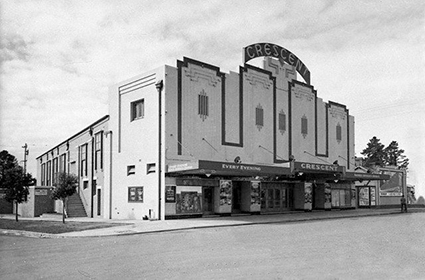
The Crescent Cinema 1934-1967
Beszant Young Filmmakers’ Award
Sponsored by Fairfield’s Neeta City Shopping Centre, the $1,000 Beszant Award for films by 16-25 year-old emerging Western Sydney filmmakers went to Mahdi Mohammadi for his film Mahtab’s 9th Birthday (2014, 10mins) a finely made, simply told and frightening story about a young Afghani girl doomed to disappear behind a burqa. Much of the film focuses on the characterful girl until her father’s arrival home with his gift and then the camera focuses on him; she is no longer seen, just heard, stifled.
The other contending films varied in quality and confidence but each revealed skill and occasionally strong ideas. John Nguyen’s The Neighbourhood Thief subtly observes a thwarted household robbery but needs another dimension, as does Vihn Nguyen’s The Subsistent Glamour, an account of work in a hair and beauty salon. In Andres Bustamante’s gentle animation, Memoria, an astronaut keeps seeing a woman in red, but is she really there?
Kathy Vu’s Identity is a tightly plotted, finely shot widescreen mystery—a man wakes up with no memory in a strange building, suspects he’s been involved in a crime and stages a violent escape, only to recall the innocent truth in the bright light of day. Game On by Jerry Kahale is muddled but potentially very funny with two cleaners in a video game factory risking involvement in the violent action.
Motion Pictures’ charismatic hosts David Capra and Kate Blackmore, its air of intimacy and community, its traversal of the streets of Fairfield, its respect for history and its openness to the diversity of screen forms old, new and to come made for an unflaggingly engaging and informative experience. Congratulations to its producer Powerhouse Youth Theatre for imaginatively re-envisioning its Short Cuts Film Festival of 2004-14. Young filmmakers can not only compete for the Beszant Award but situate themselves in the history and present of a lively screen culture.
Motion Pictures, A Festival of New Cinema, Powerhouse Youth Theatre, Fairfield, Sydney, 18 April
RealTime issue #127 June-July 2015 pg. 24
© Keith Gallasch; for permission to reproduce apply to realtime@realtimearts.net
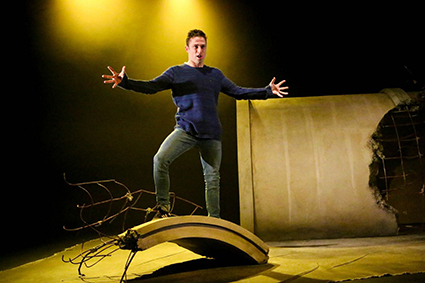
James Smith, This Is Where We Live, a HotHouse Theatre and State Theatre Company of SA co-production
photo My Wonderland Photography
James Smith, This Is Where We Live, a HotHouse Theatre and State Theatre Company of SA co-production
A gigantic concrete pipe, reinforcing mesh protruding from its smashed edges and two broken chunks scattered at the forestage, is revealed through a smoky haze. There’s an almost apocalyptic feel as teenage Chloe, in cut off denim shorts over black tights with a checked shirt tied around her waist, saunters onto the stage and hits the audience with a bold torrent of rapid-fire shards from her life. We are instantly pulled into her world and held there in her unflinching gaze.
Chloe (Matilda Bailey) is new to this dead-end town, brought here unwillingly by her emotionally absent mother who has moved in with yet another new boyfriend. Beneath Chloe’s tough exterior lies a complex collision of physical, social and educational disadvantage and a well of unmet needs. Her edgy displacement comes on top of her oceanic grief for her dead father. The ying to her yang is Chris (James Smith), classmate and slightly less-wounded poet. They fall in love against a pervasive backdrop of bullying and hardship and search for a way out.
Playwright Vivienne Walshe has said that she dislikes both the direct nature of language in theatre and the usual delivery of poetry (Time Out, Sydney, 21 May, 2013). Her unique solution is to keep the language fast and tight where the characters reveal themselves to us in gutsy poetic bursts. Chloe’s jagged self-reflections give voice to her bleak inner world. Her dialogue is an energetic mix of flashbacks and present realities with words cleverly substituted for sound effects: “Pad pad, pad to my room.” Chloe shares every thought, mood and movement with us, drawing the audience deeply, and sometimes uncomfortably, into her dark and chaotic life. We watch for signs of hope to sneak in through the cracks as she explores the potential catharsis of Chris’ love.
Walshe offers us kaleidoscopic fragments of language and character to piece together as we can. There is a deep love of language at the heart of this play, challenging us to listen carefully for subtle changes in whichever of the two characters is telling the story. We must stay alert and gather the clues before they scatter and are lost. On top of the internal thoughts and verbal sound effects, the characters question and answer themselves, simultaneously quoting teachers and parents and school bullies. There is a pulse to the language; it is instantly evocative and powerfully rhythmic. After some measured praise from her mean teacher—who’s also Chris’ father—she says, “He’s taking the piss. If he’s taking the piss I will hang myself from his front door. He’s not taking the piss out of me. I stare out the window, watch kids playing handball. I am quietly, quietly, and I hope you’ll keep this one on the down and low. I am quietly bursting with joy.”
Initially Chris and Chloe observe each other, orbiting each other’s worlds while speaking in parallel snippets directly to the audience. As their relationship develops their dialogue also becomes more connected and more directed towards each other. At the high point of their brief union they speak to each other, facing to face as the armour on both sides falls away, before being rebuilt. It’s a cleverly choreographed dance of text, personality and plot as the performers inch closer to themselves and each other.
For all its energy and momentum, the play carries a heavy sense of stasis. Chris and Chloe are locked into this hostile town in the same way their parents are locked into their dysfunctional relationships. Chloe condenses it to its essence when she says, “There’s a place here in the conga line of listless souls with my name on it. Reserved me a seat and everything. Where we live while you hate us.” There is a gnawing sense that nothing can improve here and any possibility for new beginnings will need to be sown elsewhere, far away from here.
We see their decaying family lives up close. Chris’ bullying father and alcoholic mother are a particularly ugly combination of regret and disdain. There’s almost inevitability about the violence between Chloe’s ineffective mother and her new man. Chloe retells it as, “Crash. Oh no! Here we go. Mum spilt the coffee on the lino. Hear them in the kitchen start the funeral march. I’m sorry sorry Brian.”
Playwright Vivienne Walshe has cast her thematic net wide in a layered play about struggle and identity with domestic violence, grief, bullying, emerging sexuality, disability, learning difficulties and disadvantage masterfully woven into the narrative. There is a unique poetic brutality to Chloe, and we glimpse the exposed scaffolding of her vulnerabilities as she shifts away from her default defiance. In one especially powerful scene she is forced to read in front of her class and as she stumbles and falters with her reading we see her bravado fracture. All too aware of her shortcomings she will later ask the well-read Chris, “What’s a poet got that a dyslexic can use?”
Matilda Bailey is superbly sure-footed as Chloe, striding seamlessly along the wide spectrum of internal and external thoughts and moods. We watch her crack open and close over again, as her grief simmers ever closer to her fragile surface. James Smith skilfully takes the character of Chris on a transformative journey from the slumped, painfully shy “Odd-Boy” in his over-sized jumper to an increasingly confident boyfriend who dreams of rescuing “Chloe of the Underworld” from her tormentors and perhaps from herself. The brilliant duo has been expertly directed by Jon Halpin in this complex and densely-packed performance.
Andrew Howard’s musical score of subtle bass booms and intermittent chimes works below the surface, letting the poetic, at times frenzied, text carry the story unimpeded. Scott Howard’s changes of colouring highlight postural shifts, allowing us to zoom in on Chris and Chloe as they circle each other, and any possible future they may have, around the broken pipe.
This Is Where We Live is a beautiful poetry-slam of identity, violence and neglect with a swirling undercurrent exposing the darker truths inherent in staying where you are.
—
This review is one of four from a RealTime intensive, first-stage writing workshop held 1-3 May in Albury-Wodonga in conjunction with Murray Arts and HotHouse Theatre and conducted by RealTime Managing Editors Virginia Baxter and Keith Gallasch. The other writers were Ann-maree Ellis, Sally Denshire and Ruby Rowat whose insightful reviews can be read here.
HotHouse Theatre & State Theatre Company of South Australia, This Is Where We Live, writer Vivienne Walshe, director Jon Halpin, performers Matilda Bailey, James Smith, designer Morag Cook, composer Andrew Howard, lighting Rob Scott; HotHouse Theatre, Albury-Wodonga, 30 April-9 May
RealTime issue #127 June-July 2015 pg. 31
© Kate Rotherham; for permission to reproduce apply to realtime@realtimearts.net
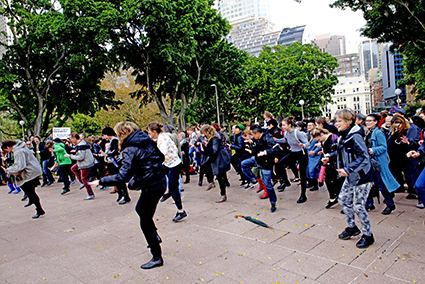
Hoofer Dance, Free the Arts Rally, Hyde Park Sydney, May 22
photo William Yang
Hoofer Dance, Free the Arts Rally, Hyde Park Sydney, May 22
Our editorial photograph is by William Yang, one of the speakers at the Sydney #FreeTheArts rally by the Hyde Park fountain, which was also addressed passionately by artsworkers Rachel Healey, Fiona Winning, Fraser Corfield and Liza-Mare Syron. The Fondue Set led a proud, good-humoured mass dance performed around the country in defiance of George Brandis’ 2015–16 arts budget heist of $104.8m from the Australia Council. Read our revealing file on Brandis, which we hope inspires you to maintain the rage and take action.
Body Image Screen is the title of our RT 127 feature. With a surge of recent and forthcoming events focused on body and screen it seems more than timely to assess that intensifying and rapidly mutating relationship.
Our burgeoning regional coverage brings you reports on new work presented in the cultural hot spots of Cairns, northern Tasmania, Castlemaine, Kandos, Albury-Wodonga and Avoca.
My Darling Patricia has disbanded after successfully producing a decade of highly idiosyncratic, ground-breaking hybrid performance works. For our Women+Performance series, Bryoni Trezise interviews members of the group about their significant body of work, and the challenges of its creation.
RealTime issue #127 June-July 2015 pg. 2
© Keith Gallasch & Virginia Baxter; for permission to reproduce apply to realtime@realtimearts.net
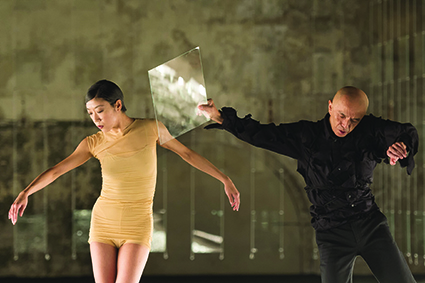
Rihoko Sato, Saburo Teshigawara, Broken Lights performance
Wonge Bergmann, courtesy Ruhrtriennale, 2014
Rihoko Sato, Saburo Teshigawara, Broken Lights performance
The screen, in its many manifestations and sites (just short now of direct wiring to the brains of the blind), is ever more seamlessly integrated into our lives, in the art that plays us back to ourselves as fact or fiction and in the continuum between that is reality.
The screen is a receiver for projections, a way of seeing and can be anything—wall, water, cloud, body. But touch-sensitive computer, tablet and phone screens record and interactively transmit two-way ‘projections’—the most seductive form of contact save for face-to-face dialogue and skin contact. The screen (once just a platform for projections) has become a palpable entity, engrained in the perceptual phenomenology of everyday life. In his musings on Atlanta Eke’s Body of Work, Andrew Furhman thinks the screen has become a body, a performer—an idea that excites and disturbs him.
Two recent major photographic exhibitions celebrate the photograph as screen. Robyn Ferrell sees the images of AGNSW’s The Photograph and Australia not only as emblematic of cultural aspirations but also as a reminder of the public embrace of photography, supremely evident in the late 19th century passion for calling cards on which one’s photograph was reproduced—a prelude to today’s Facebook posts and selfies. AGSA’s Black Rose must be one of the largest exhibitions of the work of an Australian photographer—immersive for some viewers, overwhelming for others, irritating for those who saw it as egotistical and lacking the discrimination of fine art curation and engrossing for those who saw it not so much as an exhibition as a massive installation which depicts, projects, writes, speaks and plays back a traumatised life rescued by art as realised through the camera lens. Trent Parkes’ Black Rose is multimedia autobiography and as big, in its own way, as any book.
‘Installation’ is also writ large in Carriageworks’ 24 Frames Per Second. There’s a substantial history of film and video embedded in installation as well as varying degrees of cross-artform connectivity. 24 Frames pushes these further with a focus on the body, movement and immersion and involving artists and collaborators from a variety of fields. Above is a photograph of a live performance created by Japanese choreographer Saburo Teshigawara and performed by him with long-time collaborator Rihoko Sato for a commission from the 2014 Ruhrtriennale. For their Carriageworks commissioned Broken Lights, an intimate, immersive four-channel installation from Teshigawara filmed in a refractive space filled with danced-on broken glass. Will 24 Frames Per Second inform or reframe our sense of the body and movement?
Performance art’s preoccupation with the body was put in fresh focus by the Australian Experimental Art Foundation’s PP/VT with talks, new performances and earlier ones ‘delegated’ for reproduction to other artists. Once performance art’s authenticity rested on performances being uniquely one-off and sometimes documented by photography, review or word-of-mouth—these are the evidence, as well as the traces of the performance in or on the artist’s body. Much has changed—video archiving, live transmission, coffee table books, celebrity status for performers and popular events like the Kaldor Projects’ 13 Rooms (2013). Performance art now wants to be remembered, duplicated and rewarded. But Ben Brooker, in his report on PP/TV, thinks that “only cultural memory can do that, somewhere in the complex and fraught mix of rumour and document, visibility and erasure, that has always been the genre’s terrain.”
Cat Jones attended SXSW Interactive in Austin Texas where topics such as digital cloning of the mind via social media (with intimations of immortality) and “the brain [as] an embassy of the digestive system” were assayed. Jones also encountered the open source Map Your World project which allows disadvantaged communities to see their world anew via data collection, drawing and digitising maps with which to impel social change. Catherine Fargher, also at SXSW Interactive, was inspired by Never Alone, a computer game collaboration between nearly 40 Alaskan Inuit elders, storytellers and community members for the preservation of their heritage. She was also taken with storytelling strategies involving wearables and sensors “to create context and interactivity.”
Philip Brophy, reviewing American video artist Ryan Trecartin’s, Re’Search Wait’S (2009-10), addresses some of the downside of the ‘distributed’ body. He writes that the type of “linguistic junction” Trecartin’s work evidences “is an inevitable staple of Web 2.0, because once so many people start talking/filing/sharing/commenting/linking on any topic, their speech will approach the event horizon of lifting off from its societal plane and floating into a meta-speech realm detached from its originating communicative impulse.” He later adds, “Similar to Web 2.0’s deliberated collapses of communication, Re’Search Wait’S characters are full of lens-centric monologues.”
The relationship between body, image and screen is becoming increasingly complex at the same time as it is constantly being normalised—by innovation, commerce and, yes, art for which the screen is rich in theme and tools. The immediacy of the body-image-screen conflation makes it difficult to step back from and reflect on the self that screens and is data-screened.
RealTime issue #127 June-July 2015 pg. 3
© Keith Gallasch; for permission to reproduce apply to realtime@realtimearts.net

Trent Parke, Ants on Jatz cracker biscuit, Dampier WA, 2011
Trent Parke/Magnum Photos
Trent Parke, Ants on Jatz cracker biscuit, Dampier WA, 2011
In Trent Parke’s The Black Rose, we first see walls covered in a spectacular black and white museum-style panorama of the sky at dusk onto which cut-out images of birds, bats, insects and even fish are mounted. Some of the creatures ‘fly’ outside the picture space. In the explanatory text, Parke says the image is a representation of a dream he had.
In the next room, he begins to tell the story of his life and of the origins of his work. Here we begin to appreciate the massive scale of the exhibition which unfolds as a sequence of chapters involving many hundreds of images in rooms curated thematically. The third room is dimly lit and filled with black and white images—insects in the night sky against a background of stars, an illuminated spider web, the glowing eyes of black cattle in near darkness, crabs on a shore and a video of moths fluttering around an outdoor light. This room seems to be about illuminating the teeming life of darkness.
The next room is brightly lit and the work of a different character, emphasising childhood and family. Beginning with a large, vivid picture of his wife, photographer Narelle Autio, and newborn baby moments after birth, it includes images of a strand of Parke’s late mother’s hair, of his father’s wristwatch and of his children as they grow. Though very personal, some images appear coldly detached, particularly when the subject is captured under penetratingly bright light. One set of black and white images shows a sick child on a bed seen from high above; such a viewpoint creates a feeling of disconnection rather than empathy or sympathy. Some images are small, some overwhelmingly enlarged, so the viewer’s response shifts from observation to confrontation. The juxtaposition of images is also crucial, for example an image of tadpoles is placed next to that of a child as if to question their equivalence. While such images are loaded with symbolic and emotional significance, you get the feeling that the act of photographing a subject can defeat as well as convey personal attachment and sentiment.
The exhibition has been seven years in the making and began when a stranger offered Parke a cutting of what he described as “a black rose” and encouraged him to plant it, which he did in 2007. (The plant in Parke’s photo doesn’t look like a rose, but resembles an aeonium manriqueorum zwartkop, a species of subtropical succulent. The zwartkop variety is very dark purple, almost black.) In a voice recording, Parke speaks of the day in 2011 when the pot containing the black rose inexplicably fell and shattered while he was playing backyard cricket with his son. Naturally he photographed the broken pot and its spilled contents but there is more to the image than the triggering of his photo-journalistic reflex—coincidences and unexplained events are central to the artist’s thinking.
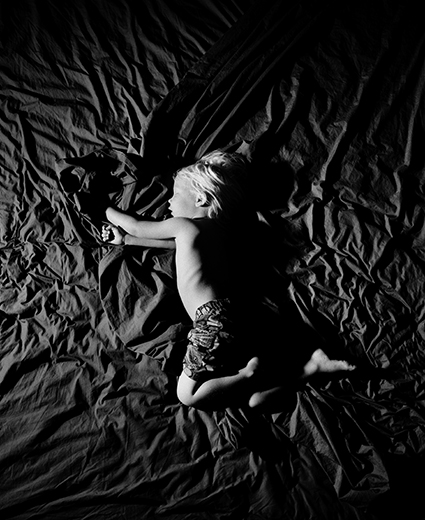
Fever, Dash Adelaide, 2014
© Trent Parke/Magnum Photos
Fever, Dash Adelaide, 2014
You can buy a lavish catalogue that includes Parke’s writing selected from 14 of his previously published artist’s books, the sources of some of the images in this exhibition. He talks of the death of his mother when he was 12, how for a time he blocked out the memory of her and how this prompted a series of works in which he reconsidered his childhood, his burgeoning interest in photography and photographic trips around Australia. The exhibition is set out as a personal retrospective whose elements are stitched into a narrative, a journey of memory, imagination and dreams like a story told in cryptic vignettes.
Trent Parke is a member of Magnum, the elite group of photographers founded by Henri Cartier-Bresson, Robert Capa and others in 1947 as an agency for photojournalism and photographic art. His work ranges across the use of the photo as factual record and as fictional or abstract construct. There are images of people which have been so manipulated that the figure is a haze of dots, appearing as a ghostly, unrecognisable silhouette in a lighter ground. Occupying three sides of a room is a video close-up of the skin of a dying, decaying squid, an image that looks like liquid slowly bubbling and which is incomprehensible until explained.
There’s a set of 365 colour photos of the sun setting daily at the beach near Parke’s Adelaide home. This suite, covering one wall, examines the sunset as a visual phenomenon and signifies the photographer’s dedication to maintaining an observational record over an extended period. It becomes a metaphor for the rhythm of life; evidently he emailed each image daily to Magnum colleagues. These images are mounted as a single work that superficially resembles a strip of movie film that would collapse a year into an instant. This distortion of time is a recurring theme in the exhibition. But to gain the sensation of the sublime that a sunset can evoke, we must ignore the whole and study each image separately. We’re not only reminded of the adage that a photo is a moment frozen in time, but that we must appreciate each work in this exhibition, each moment, individually.
In another room, themed Outback, Parke shows a sequence of images taken at night in which the only source of illumination is his flash-gun; in a voiceover, he tells of scaring away a charging crocodile with the flash, the camera becoming a defensive weapon. Opposite these is a display of sensationalistic headlines from the Northern Territory News reporting crocodile attacks. Then there are images of death —cattle carcasses in the desert, a beached whale. There are shots of rabbits and a booted foot crushing a cane toad.
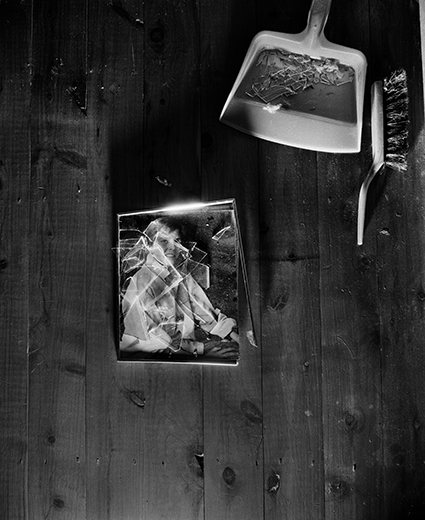
Trent Parke, Shattered portrait, Newcastle, 2009
Trent Parke/Magnum Photos
Trent Parke, Shattered portrait, Newcastle, 2009
Further on are Black Rose Tarot Cards, images chosen to symbolise characters or transitional states, alluding to Parke’s interest in fortune telling and mysticism and acknowledging his mother’s interest in Tarot. Lastly, again illuminated by his flash, there is a ceiling-high photo of a gum tree, which his mother years before had saved from destruction by developers. In creating this image, Parke felt he had concluded his journey.
The last room of the exhibition contains hundreds of rolls of developed film, hung like a curtain against bright light for our inspection, representing not only the vastness of his oeuvre but Parke’s commitment to continuous observation. Evidently he shoots a thousand rolls of film a year. The advertising for the exhibition shows an image of a bare-chested Parke examining processed film at the beach on Fraser Island in 2003, a romantic evocation of the young, visionary artist at work. The image, by Narelle Autio, has the flavour of an un-posed, spontaneous, Magnum-style shot. Several of her photos pepper the exhibition and she assisted in its development.
Trent Parke apprehends his world through the camera lens. The Black Rose can be seen both as autobiography and as an exploration of the use of photography to record events, convey memories, construct or represent ideas and create both optical and emotional effects. In weaving seven years’ work into an overarching narrative Parke seems to be trying to reclaim, or prove the veracity of, his own experiences. An abridged version of the exhibition may have captured the essentials of his approach to photography as an art and hence been more navigable for the viewer, but presumably would have omitted what for Trent Parke are important elements in his story.
Adelaide Festival, Trent Parke, The Black Rose, Art Gallery of South Australia, Adelaide, 14 March–10 May
RealTime issue #127 June-July 2015 pg. 4-5
© Chris Reid; for permission to reproduce apply to realtime@realtimearts.net
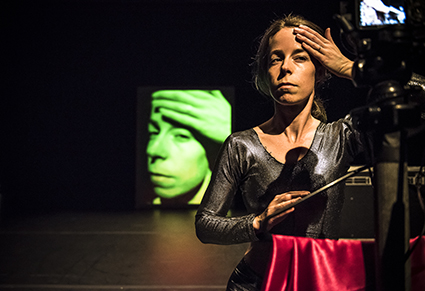
Atlanta Eke, Body of Work, Dance Massive, 2015
photo Gregory Lorenzutti
Atlanta Eke, Body of Work, Dance Massive, 2015
“Jacob? Jacob, is there something wrong?” Atlanta Eke stands front and centre, dressed in silver spandex tights and long-sleeved silver crop-top, squinting through the lights up at the control booth where video production designer Jacob Perkins is mixing the live camera feed. “Yes, there is something wrong,” comes the reply, faintly heard, from behind the audience.
It’s a moment of brief uncertainty for the audience. Is there a problem with the technology? Has the camera broken? No. Suddenly the swirly synthesiser atmospherics give way to wild drums and ominous chords. Eke dons a space helmet, improvised from a plastic bin lid, and hurls herself back into the fray. The something which is wrong is the appearance of an invading army—aliens which look like large, bouncing blue balls.
But something might have been wrong with the technology. Or it might have been that the technology itself was wrong. Or the way that the technology was used was wrong. There is something problematic about the way Body of Work combines video and live performance. So much of what is written about dance and video—or about screendance, dance as mediated by a camera—is aimed at identifying and articulating the essential difference between what happens on the screen and what happens in performance. Is there some elusive quality of liveness which the screen lacks? What about when the video of the dance is broadcast simultaneously with the performance? Are we talking about fundamentally different orders of affective experience?
And yet the distinction between screendance and dance as such is becoming increasingly blurred; cheaper and more sophisticated video technology is allowing experimental choreographers to more completely immerse the screen within the liveness of performance. The screen is being transformed: a body to be choreographed, like all the rest.
Body of Work premiered at the inaugural Keir Choreographic Award in Melbourne, 2014, where it won first prize. It was then re-performed by Eke for Dance Massive in March, expanded and tweaked, but with essentially the same look and feel. And as with much of Eke’s work, it can be difficult to do more than describe that look and feel.
Atlanta Eke haunts the interzones between performance art and contemporary dance, often using live music, elaborate costumes and props, theatrical and live art provocations, and very little that looks like formal dance. It is dance which feels conceptual and politically charged, but where the concepts and politics are elusive, or can only be intuitively discovered.
Set against a background of science fiction clichés, Body of Work insists that choreography is a problem of time as much as it is an art of space. It is therefore a formal exploration of the relationship between the screen, the camera, the audience and the performer, and how each works on and is worked upon by the others across time. In this quartet the screen, and even the camera, become non-organic performers: dancing bodies with certain formal equality with the human performer.
During one of the work’s key scenes or movements, Eke stands before the camera and applies white face paint, as though the lens were a mirror. She then records a short loop of herself posing. That video clip is then replayed on the screen while another short loop is recorded of Eke miming an interaction with the first clip. That second clip is then replayed and another interaction is recorded, and so on. In her interactions, Eke caresses the previous recording of her image, tracing her outline, fondling the pixels.
Later she gives this recursive process a horror movie theme. She begins not with an alluring image, something to be cosseted, but with something monstrous. The first video clip is a close-up of her vomiting green ink. While this image loops, she places herself before the screen as if a cowering victim, hands raised, then reclines cat-like, and so on, each new pose carried backwards, deeper into the screen.
The first thing to note is what an impressive technical feat of choreography this is. The framing and the live editing of the loops is pulled off with remarkable precision, and yet it has the swagger and flow of something improvised. The tone of the piece is set by Daniel Jenatsch’s live musical accompaniment, which is all rough-edged art jazz and lo-fi parody of B-grade sci-fi scores.
But what happens to all this easy virtuosity when the dance is over? Does it endure? Body of Work suggests that it does. Here we see a past that is always present. As Eke traces the outlines of her own body, as it once was, she is tracing the outline of a memory. She is not showing us the memory itself, but she is showing us that it exists. She is showing us the surface of a past which is, to use the terminology of Gilles Deleuze, always virtual, or virtually contemporaneous.
This way of looking at the past throws an interesting light on questions of ‘presence’ and ‘liveness.’ Eke describes her piece as “a dance with time that dissolves the distinction between human and machine. It is a dance of synthesis, a hybrid, a cyborg where opposition is irrelevant so that the question remains; who choreographs and who is choreographed?”
And who is this cyborg figure? Is it Eke herself, shining in her silver spandex? What is the relationship between Eke in flesh-and-blood and Eke on the screen? Choreographically, it is a relationship of interdependence. The screen shows us something that has been performed, but it is also a part of what is simultaneously being performed. Is the cyborg figure the total rhythmic ensemble? A hybrid of flesh and screen and camera? Thus the work is the body, and the body is, in a generative sense, of the work.
If the form of the work is cyborg, what does this mean for the content? Does it bring Atlanta Eke’s politics back, by way of a video loop, to a postmodern feminism? To the “cyborg feminism” of the 1980s and Anne Harraway’s “ironic dream” of a common language, but re-performed for today in a postmodern context?
Screens and live video feeds are everywhere in dance and theatre today, even on the biggest stages, where directors and choreographers are keen to exploit the natural promiscuity of the camera eye and to dazzle their audiences with the latest media wizardry. Just as the camera has, over the last hundred-odd years, worked to transform live presence into cinematic presence, directors and choreographers are now transforming the screen as active performer, with its own bodily presence, a corporeality which is not necessarily different in kind to the human body. It’s a brave new world, and again the question must be asked: “Is there something wrong?”
Body of Work, concept, choreography Atlanta Eke, video Hana Miller and Jacob Perkins, music Daniel Jenatsch; Dance Massive 2015, Dancehouse, Melbourne, 16-18 March
Dance photographer Gregory Lorenzutti will have his first Australian exhibition, “Dance is My Landscape”, in Melbourne this June at Dancehouse in Melbourne. Exploring the moving body and the ability of a skilled artist to capture the fleeting, beautiful moments that are created through dance, “Dance is My Landscape” will feature more than 100 photographs of dancers from around Australia and Brazil. “Dance is my Landscape” is a free exhibition. It runs 12-14 June. All exhibited pieces will be available for purchase.
RealTime issue #127 June-July 2015 pg. 6-7
© Andrew Fuhrmann; for permission to reproduce apply to realtime@realtimearts.net
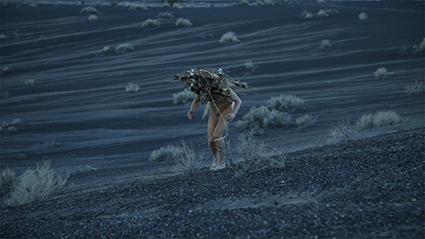
Francois Chaignaud and César Vayssié, The Sweetest Choice, 24 Frames Per Second, Carriageworks, 2015
photo courtesy the artists
Francois Chaignaud and César Vayssié, The Sweetest Choice, 24 Frames Per Second, Carriageworks, 2015
24 screen installations by 16 Australian and eight overseas artists—choreographers, filmmakers, video artists, contemporary performance makers—and dancers or other collaborators who inspire them. This is Carriageworks’ greatly anticipated 24 Frames Per Second, a major exhibition of 24 commissioned installations created “at the nexus between film, dance and the visual arts” [press release]. Three years in the making, it’s the outcome of Carriageworks’ successful bid for funds made available by the Australia Council’s National Strategy for the Development of Screen Dance initiative.
Australian screen dance in the 1990s and 2000s, with its links to international forums and festivals, its award-winning makers and our own nurturer of the form, ReelDance (its significant collection of films now publicly accessible at the UNSW Library) enjoyed great prominence. That’s not been the case in recent years. Perhaps the form will be reinvigorated by 24 Frames Per Second although the exhibition’s focus, if with choreographers and dancers involved, is firmly on a meeting of art forms: “the exhibition has been conceived in response to a shift towards interdisciplinary and collaborative experimentation in contemporary artistic practice” [press release].
Installation is not new to screen dance, but 24 Frames’ total commitment to it is, in respect of scale, the disciplinary diversity and hybridity it embraces. Hence the excitement and curiosity that anticipates 24 frames—will it yield innovations beyond the dance screen legacy, a great furthering of the hybrid arts, an expanded arts audience and new opportunities for artists, especially those in a challenged dance ecosystem?
Curation
I spoke with Beatrice Gralton, co-curator with Nina Miall of 24 Frames Per Second. She describes the process of putting the event together as “a very collaborative process from the beginning. The selection of artists was made by Lisa Havilah, Lisa French, Nina Miall and myself. We talked about who we thought would make an interesting contribution to the project at different levels—emerging, mid-career, established, experimental, Australian, Indigenous, international—the whole lot.”
“For the artists there was really an open brief,” says Gralton. “Here’s the commission, there’s no thematic; you can do what you want; you can collaborate with whoever you want; you’ve got this much money; we can help you raise additional money if you need it and let’s just keep talking along the way. The artists came to us with all kinds of thoughts and display requirements and live components. It’s been really interesting because we’ve approached artists who work in such different ways.”
Location & design
We’ve had to consult really closely with the artists so that works in the enormous cavernous space that is Carriageworks will be presented in the best possible way. What makes it interesting for us is that we’re not a traditional gallery space. We don’t have a white cube and you can’t fake it. If anything, that works to our advantage because what we’re trying to do with this exhibition is a big experiment. We’ve been talking to all the artists to see how they want their works to be displayed and then trying to create an exhibition that really allows for that.”
24 Frames Per Second will be located in Carriageworks’ 6,000 square metre annex comprising Bays 22 to 24, where screen works in the Biennale of Sydney program were shown in 2014. Works will also be shown in that other expansive space, the Carriageworks foyer.
Galton says that the exhibition design for the annex comprises “a hub with four quadrants and a central chamber, and from this hub two corridors lead back out into the space. We are excited about the design, it’s fairly unconventional and we hope people enjoy navigating the exhibition as a whole with its many parts. It’s quite disorienting. Works are displayed on the exterior walls and within chambers. The idea is that as you enter you’ll see a number of long views of works on the walls and you’ll then be able to choose your own adventure.” As always a big challenge, says Gralton, is sound: “Some artists have asked for headphones and some don’t want them; a couple of works are silent. We’re also carpeting and baffling the interior spaces, so that helps.”
What screening durations should visitors be prepared for? “Anywhere between four minutes and I think the longest work is 45 minutes. You might want to visit a couple of times. Some of the works have a narrative arc, some don’t.”
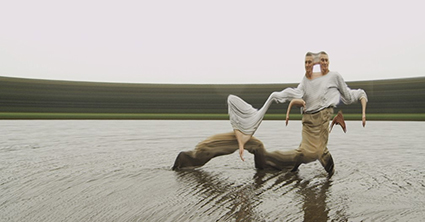
Natalie Cursio, Daniel Crooks, Untitled
image courtesy Carriageworks
Natalie Cursio, Daniel Crooks, Untitled
Installation construction
I ask about the demands of installation construction. Gralton tells me that Japanese artist Saburo Teshigawara’s Broken Lights comprises a four-channel work for which he’s constructing a box for the viewer to walk into with walls and ceiling that act as rear-projection screens. “The overall image is of shattered glass, so you walk into a box of shattered glass.” “Will we walk on glass?” “No, but you’ll see the dancing, which is. It’s a really beautiful work.” In Lizzie Thomson’s White Record, “Four large screens will be suspended from the ceiling and they’re rear projected, but there’s about a metre in between them. So you’ll walk into the space and be surrounded by them.”
In a conversation last year, Gralton recalls, Melbourne choreographer Nat Cursio said, “‘I can really see my work on a freestanding monolith.’ So we’ve built for her an eight-metre long, four-metre tall monolith onto which the work will be projected.” Cursio approached a video artist she’d long wanted to work with, Daniel Crooks. His inherently choreographic sensibility is evident in his vertical video ‘time slicing,’ which transforms people and public spaces into beautifully fluent rhythmic abstractions. The work includes, onscreen, influential senior Australian dancer and choreographer Don Asker. Gralton adds, “It’s been great to commission artists and then see who they want to work with.”
Emergent themes
The curation of 24 Frames wasn’t thematic, but however Gralton thinks one theme “that has emerged is the performative body’s relationship to technology—futuristic, dysfunctional, therapeutic, anthropomorphic—all of those. And vernacular dance and mythology is another theme we’re seeing in works by Angelica Mesiti, Christian Thompson, S Shakthidharan, Khaled Sabsabi and also Lizzie Thomson.”
Gralton thinks cine-choreography is also evident: “the camera as choreographer…in the works of Teshigawara, Michaela Davies, David Hinton and Sriwhana Spong. There are some really interesting interrogations of the dance film as a genre. Artists who have taken that on in my mind are Brian Fuata, Byron Perry and Antony Hamilton. And then the figure in the landscape, as well as elements of portraiture…and definitely dance and performance representing some kind of social and collective expression.
“These are very much the ideas that artists are dealing with, pushing their mediums to the max and thinking about technology and always the body and always landscape. We really hope that this project has given artists a chance to experiment and do things that perhaps they’ve been thinking about for a while but haven’t had the forum.”
Carriageworks, 24 Frames Per Second, Sydney, 18 June-2 Aug; artist talks 20 and 27 June
RealTime issue #127 June-July 2015 pg. 8
© Keith Gallasch; for permission to reproduce apply to realtime@realtimearts.net
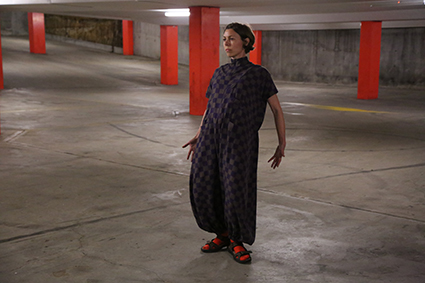
Lizzie Thomson, White Record, 24 Frames Per Second, Carriageworks, 2015
image courtesy the artist
Lizzie Thomson, White Record, 24 Frames Per Second, Carriageworks, 2015
In 2012, choreographer and dancer Lizzie Thomson was approached by Carriageworks to join its pitch to procure the $300,000 made available by the Australia Council’s Screen Dance Initiative. The proposed 24 Frames Per Second was a successful bid and so Thomson joined a massive “curated commissioning” of 24 national and international artists, dancers, choreographers and filmmakers whose creations would be exhibited after three years in the making at Carriageworks.
At the time of Carriageworks’ approach, Thomson was completing her degree in Visual Arts at the then College of Fine Arts and had been working on several of the ideas and the movement research that engendered her live work Panto, an opening-up of her practice to “anything and everything,” described by reviewer Cleo Mees (RT105) as a “loose trying-on and throwing-off of ideas.” Now almost four years down the track, similar investigations inform her foray into screen dance and the creation of her new work White Record (a title she credits to another 24 Frames artist, Brian Fuata).
When I speak with Thomson about her current choreographic practice, she notes the consistent curiosity about embedded histories of dance and art carried over into her work from her research. She says dancers’ bodies have the “presence of different histories” that are both known and unknown. As the daughter of two dancers, the history begins in her DNA; training in a suburban dance school, at university, then dancing with choreographers and collaborators nationally and internationally over the decades, the layers of influence run deep. In this piling on of forms, the greatest challenge came with the teachings of choreographer Rosalind Crisp with her ‘no history’ scores: ‘YES to all’ was categorically silenced by a big fat ‘NO.’ (But then came Panto!)
The mimetic, schizophrenic absorption of “different information” into the moving body (a common story with dancers) has raised the question for Thomson: “What do I do with it all?” From this place of questioning, she has found 24 Frames the perfect platform to take an objective view of all these influences, not solely from beneath or beyond her dancing body, now up on screen, constituted and fragmented in its two-dimensional mediation. She understands that screening the body posits her as a “choreographic object to study” (in the William Forsythe sense), allowing an unravelling of her own histories, and the opportunity to see deeper cultural connections.
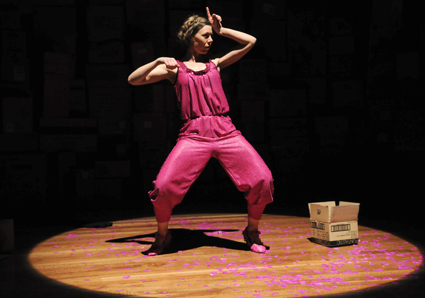
Caption Lizzie Thomson, Panto, 2011
photo Heidrun Lohr
Caption Lizzie Thomson, Panto, 2011
When asked about her process for White Record, Thomson describes how these different histories are often conflicted, or sometimes so sedimented and quiet that their emergence is a surprise. This was the case 10 months ago during the “cataloguing” of certain histories in a “body archiving” and “alphabetising exercise.” A “weird jazz” suddenly shook loose from her “shaking practice.” This “forgotten jazz” went back to her childhood dance teacher, Jennifer Barry, but even more indirectly, Barry’s connection to Colombian-American choreographer and Black activist Eleo Pomare (1937-2008). In this newly uncovered memory of her early jazz training, Thomson feels she is making genealogical links—a kind of bodily hermeneutic—with the West African and Afro-American roots of Jazz dance. She now ‘twerks’ and mimics remediated forms of racial appropriation from music video clips (Beyoncé doing Fosse!). Her movement-based study has led to a deeper set of questions around colonialism, imperialism and cultural appropriation: difficult reflections on one’s ‘whiteness’ in a country that so cruelly blanked its blackness; her dancing and our Western white dances complicit in this white colonialist past.
White record is a four-channel video installation projected onto four “life-size screens configured as a square” to give the audience a “three-dimensional experience.” They will be free to enter at any time during the 8-minute looping solo. The sound is being engineered offshore in Oakland, California by another Aussie, Kevin Lo, and will be a 10-minute loop independent from the image. The work has been filmed by Sam James between the “great bright orange pillars” of Kings Cross Car Park below the home of Alaska Projects, and edited as a complex conversation between angles and the four screens by James with Thomson’s sister Gina. Artist Agatha Gothe-Snape is conceptual consultant on the work that has finally come together in discrete phases over many locations.
24 Frames was “conceived in response to a shift towards interdisciplinary and collaborative experimentation in contemporary artistic practice” (Media Release). The artists have had no opportunity to meet, share skills, or participate in discussions about their works or the aesthetics of this “nexus between film, dance and the visual arts.” But as an exhibition and not a screen dance festival, we as visitors can together participate in the ontology and future of screen dance in this country come June 18.
24 Frames Per Second, Carriageworks, Sydney, 18 June-2 Aug
RealTime issue #127 June-July 2015 pg. 9
© Jodie McNeilly; for permission to reproduce apply to realtime@realtimearts.net
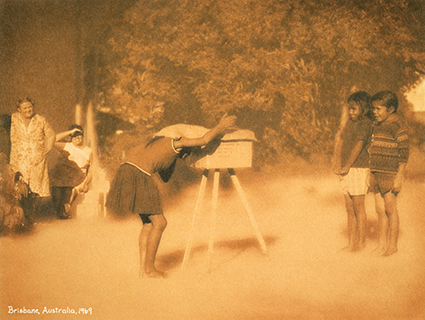
Tracey Moffatt, I made a camera 2003, photolithograph, collection of the artist
courtesy Roslyn Oxley9 Gallery, Sydney
Tracey Moffatt, I made a camera 2003, photolithograph, collection of the artist
In Max Dupain’s 1937 photograph, Sunbaker, the viewer is drawn into sensations of lying on sand, sun on skin. Through it can be felt the wellbeing, the abundance of that careless leisure. More than capturing the moment, Dupain’s photograph has come to distil a sense of being a citizen of the Lucky Country.
No doubt this is what the blurb for The Photograph and Australia means by “shaping our understandings of the nation.” No matter that the sunbather himself was actually English. All the better, because ‘being Australian,’ like all democratic urges, is an aspiration. And Dupain’s photograph has become iconic because of it.
It is hung near David Moore’s 1966 photograph European Migrants (not all of whom were migrants, as it happened) preparing to disembark at Circular Quay in the 1960s.Their expectant, anxious faces carry that aspiration, and communicate it to the viewer years later in a place they may now take for granted as home.
Photographs have become a way of seeing ourselves. They’ve become a way of being ourselves. From the beginning, the photograph was taken up into real life, capturing imaginations. As the experience of viewing The Sunbaker shows, a photograph is not merely a depiction of an event, but viewing it can be felt as an event in itself. It is democratic in this elemental sense, offering its sensations to all who can see them and recognise themselves in them.
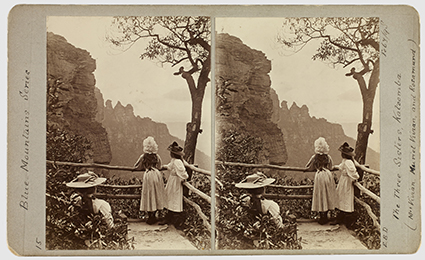
Ernest B Docker, The Three Sisters Katoomba – Mrs Vivian, Muriel Vivian and Rosamund, 7 Feb 1898, stereograph, Macleay Museum, The University of Sydney
It’s uncanny that Australia formed in the same time frame as photography. The two have grown up together, so that now to display a history of photography in Australia is to display a history of Australia, and likewise a history of the photograph. The daguerreotype was invented just as the colony of New South Wales was getting underway (traced by Geoffrey Batchen in the accompanying catalogue).
A way of being ourselves through seeing ourselves; the exhibition shows this desire predating the phone camera by more than a hundred years. A giddying wall of photographic cartes de visite that circulated in the 19th century draws a direct line to social media.
The exhibition emphasises documentary and visionary aspects of photography, the secret of its success being that it shows how things really are. The photograph also shows how things are really enigmatic. The photograph shows what is there, but only in its absence.
It reproduces reality in a specific way—it renders it two-dimensional, it confines it to a frame, it edits out all senses but the visual. These critical elements shape our vision of what there is. In this enigmatic realism, the photograph is expressive of the post-postmodern era. Examples abound: the panoramas taken by Melvin Vaniman in 1903 a photographic portrayal of the large view we naturally see from a height. Now, the landscape of the Blue Mountains is most recognisable in wide-angle. It has become our imagining of it.
Vaniman’s 1904 panorama of the Fremantle port gave expression to an economic vision, in which the concept was laid out like a map. Henceforth, the Port of Fremantle can now be realised as a commercial proposition, beach and water and jetty and hinterland united to serve the vision.

Melvin Vaniman, Panorama of intersection of Collins and Queen Streets Melbourne, 1903, platinum photograph
State Library of New South Wales, Sydney
Melvin Vaniman, Panorama of intersection of Collins and Queen Streets Melbourne, 1903, platinum photograph
These are naturalised views, but the panorama Vaniman made of Collins Street is more uncanny, since despite seeming plausible, there is no such natural view. It evokes filmmaking conventions of the tracking shot to be enacted a century later.
Similarly, James Short’s photographs of the Moon’s surface, not visible to the naked eye, are visualised as if they could be, photographed through a telescope in the early 1900s. Ninety years later, David Stevenson sees stars in a manner that could never be perceived, as time-lapse streaks of light.
New genres are shown springing to life to meet new realities: C.E.W. Bean and his photographer Hubert Wilkins document the Gallipoli battlefield, inaugurating for Australia the war correspondence that we now experience nightly as news footage. The mug shot of Ned Kelly, and the photographs taken at his execution, evoke the conspiracy of photographic evidence in law enforcement, espionage and surveillance.
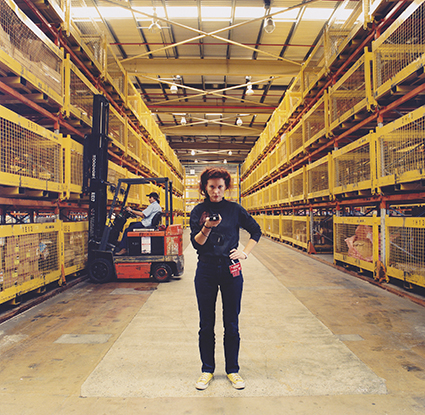
Anne Zahalka, artist #13 (Rosemary
Laing) 1990, from the series Artists, colour
Duraflex photograph, Collection of the artist
Anne Zahalka, Licensed by Viscopy
Anne Zahalka, artist #13 (Rosemary
Laing) 1990, from the series Artists, colour
Duraflex photograph, Collection of the artist
In a startling reversal, it turns out that that which cannot be photographed is not likely to exist. Anne Ferran’s large prints of the site of the colonial Female Factory ironically portray this, showing only grass under which the past is buried.
Sometimes the photograph becomes wish-fulfilment, a desire to see things a certain way. The many small photo-portraits in velvet cases from the nineteenth century, bijoux of another era, show off emotional investments in the image. Like religious icons, they can embody loved ones (and illustrate the privilege that the photo has to carry feelings).
The political, too, occurs in a wishful imagining of some realities in the life of the nation. Desires can be seen to change with the times. The varying images of Indigenous people provide a striking example. Paul Foelsche, the Northern Territory’s first police inspector, took portraits of tribal Aborigines in the anthropological manner. Kerry & Co’s “Aboriginal Chief” (1901-07) provided the image for Brook Andrew’s renowned work Sexy & Dangerous, strangely not present in the exhibition, although works by Tracey Moffatt and Ricky Maynard hold its place.
Henry Fris photographed “the last of the native race” of Tasmania in 1864, dressed up as in any Victorian formal family portrait. Samuel Sweet’s 1884 portrait taken at Poonindie Mission is an ominous arrangement of Indigenous children with their priest. Baldwin Spencer’s careful photographs at Bungalow reveal nothing of the living conditions endured there by the Stolen Generations.
Jump-cut to 1975 and Mervyn Bishop’s classic press photo shows a politician, Gough Whitlam, pouring soil into the hand of Aboriginal elder, Vincent Lingiari, in an iconic shift in representation.
The internet, embodying the virtual, makes the photograph a template for communicating. The democracy of the photographic now produces unpredictable effects; the opening up of photography to the naive, the technical, the social and the documentary provides a growing counterpoint to the professional and artistic possibilities developed in the medium.
The installation, The Compound Lens Project (2014-15, Patrick Pound with Rowan McNaught) ponders the aesthetic question this raises. The website samples a collection of found photographs following the logic of an algorithm. Pound dares us to imagine that “all the images in the world now make up a vast unhinged album.” This is an enduring emblem for the exhibition. By accident or design, its oppressive abundance evokes the claustrophobia of images now, crowding us headlong into global technological change.
The Photograph & Australia, curator Judy Annear, Art Gallery of NSW, 21 March-8 June
RealTime issue #127 June-July 2015 pg. 10-11
© Robyn Ferrell; for permission to reproduce apply to realtime@realtimearts.net
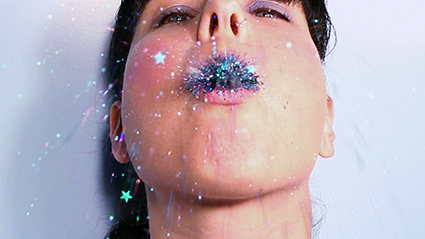
Ray Harris, Glitter Vomit (video still) single-channel HD video, 5.36 mins
courtesy of the artist
Ray Harris, Glitter Vomit (video still) single-channel HD video, 5.36 mins
Performance art’s latest international revitalisation—in part a reaction against years of object-based spectacle in the art museum, and reflecting a surging interest in a dematerialised, experience-orientated art—has been well documented. Amelia Jones has argued that the “wholesale resurgence” of the genre borders on obsessional in the art world, while Diana Smith, member of Sydney-based performance art collective Brown Council, noted in a 2013 essay, “In Australia there have been new levels of visibility for performance art in major institutions across the country and with it, as curator Reuben Keehan remarks, ‘a greater purchase among a younger generation of practitioners’.”
This younger generation features heavily in PP/VT (Performance Presence/Video Time), which brings together at the Australian Experimental Art Foundation in Adelaide a gallery-based exhibition with a focus on new works and delegated performances, and video works and installations that include documentation of live events, and performances, such as those by South Australian Ray Harris, made specifically for screen. Only four of the exhibition’s participating artists—Jill Orr, Arthur Wicks, Jill Scott and Eugenia Raskopoulos—could be said to represent Australian performance art’s old guard.
“I think my brief to myself,” curator Anne Marsh explained to me, “was to have some kind of an overview of what’s happened in the last 10 years or so and to showcase the younger generation.” Key to this are a number of delegated performances, a form continuing to gain traction in the art world even as experienced practitioners, perceiving inauthenticity and commodification, resist it. “On one level,” Marsh comments, “delegated performance is a kind of homage to the original, on another level it critiques the original, but because it’s a copy it also makes it kind of cleaner and more digestible for a commercial market because we already know what the artist did—the edge is off it.” Few of the older generation artists whom Marsh asked were interested in doing a delegated performance but, she continues, “I really wanted to include some artists in their 50s and 60s, to give the visitor to the gallery an indication that performance art actually has a history in Australia.”
This history’s documentation is still being caught up on, as evidenced by the fact that Marsh’s comprehensive survey of Australian performance art, Body and Self (1993), remains the only publication of its kind and is out of print. There are signs that a new wave of scholarship is emerging—PP/VT’s companion book is Marsh’s internationally-focused performance art survey, Performance Ritual Document (2014) and Edward Scheer’s The Infinity Machine: Mike Parr’s Performance Art 1971-2005 (2010) is the first major monograph on an Australian performance artist—but Marsh’s desire to see the closing of “a gap in Australian art history” remains unfulfilled despite performance art’s increasing assimilation by the art establishment into its mainstream ‘white box’ spaces, concomitant with growing scholastic attention and cultural cache. (As I write this, two out of the three top trending items among my Facebook friends’ feeds are about performance artists, Marina Abramovic and Emma Sulkowicz.)
“Why do we have a new wave of performance art?” Marsh asks rhetorically. The AEAF is in its 41st year of operation, and we are in an upstairs office at the foundation’s premises in the Lion Arts Centre on North Terrace. Below us are the gallery space and Dark Horsey bookshop, where the shelves are lined with art magazines, cultural studies classics and slim volumes of short-run poetry. “I think society is ready for it because we live in an experience economy. I was in Sydney at the end of last year and I was talking to a commercial gallery director. She said to me “I can’t sell paintings anymore—the rich people want ‘experience’.”
The recent record-breaking sales at auction of works by Picasso ($106.5m) and Alberto Giacometti ($141.3m) notwithstanding, there is ample evidence that the pendulum has indeed swung back towards the ephemeral and the experiential, and away from the exalted art object à la Damien Hirst’s zenithal For the Love of God (2007). We might point to Marina Abramovic’s international renown—projected far beyond its early cultishness by the weeklong series of re-performances, Seven Easy Pieces performed at New York’s Guggenheim in 2005—or the voguishness of Kaldor Public Art Project’s 13 Rooms (2013). The latter’s proliferation of delegated performance and framing of its participants as ‘living sculptures,’ redolent of masculinist formalism and exploitation (as well as, no doubt, the exhibition’s suspicion-fomenting popularity with Sydney’s general public), rankled some critics. (See performance artist Barbara Campbell’s response in RT115).
Queensland-based duo Clark Beaumont, comprising QUT graduates Sarah Clark and Nicole Beaumont, became, according to Marsh, famous through their contribution to 13 Rooms, Coexisting. The piece, performed for 8 hours a day over eleven days, saw Clark and Beaumont intertwined on a plinth slightly too small to comfortably accommodate two people. The duo is represented in PP/VT by Hold On To That Feeling (2013), a dual channel video installation in which they appear on a sports field in the normatively masculine pose assumed by Judd Nelson’s character John Bender at the end of the 1985 film The Breakfast Club: legs slightly apart, head tilted insouciantly, one fist raised victoriously against a clear blue sky. In its excruciating protraction, a gesture ordinarily fleeting and associated with the traditionally homosocial team sport, becomes emphasised as, in Judith Butler’s terms, a constitutive performance of gender.
Another notable work for video is Brown Council’s This is Barbara Cleveland (2013, available to view in its entirety online at www.browncouncil.com). The 16-minute video, which, as Marsh put it to me, trades on Allan Kaprow’s notion that “some of the best performance art you’re ever going to know about probably exists only through rumors,” is a part-mockumentary, part-art film about the life and work of fictitious performance artist Barbara Cleveland (the surname is an in-joke – Cleveland Street housed Sydney’s Performance Space from 1983 to 2007). “We know,” says talking head Kate Blackmore, “that Barbara Cleveland was an Australian artist working primarily in Sydney in the late 1970s and she disappeared in 1981.” Various mouths in close-up, like that in Beckett’s Not I, intone extracts from lectures Cleveland wrote during her late 1970s/early 1980s heyday and that were discovered in a box in 2011. Few traces remain—just the typed out lectures, and a handful of poor quality photographs —of Cleveland’s progression from Mike Parr/Peter Kennedy-esque idea demonstration works to the ritualism and simple gestures of her later, strongly feminist oeuvre.
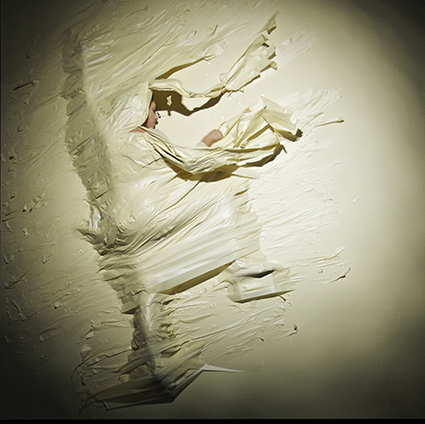
Jill Scott delegated to Mira Oosterweghel, Taped 2015, documentation of live performance at AEAF (Adelaide) 14 May, 2015
photo Alex Lofting
Jill Scott delegated to Mira Oosterweghel, Taped 2015, documentation of live performance at AEAF (Adelaide) 14 May, 2015
Brown Council’s fascination with the mythical aura lent the performance artist by the genre’s sparse documentation and (not unrelated) marginal status in critical discourses is also the basis for a participatory live work, The History of Performance Art. In the bookshop, Council members Frances Barrett, Kate Blackmore, Kelly Doley and Diana Smith share a circle of chairs and a microphone with audience members as stories of witnessed performance art works, both recent and from long-ago, often half or barely remembered, are traded. I duck in and out of the always lively conversation, caught between it and Jill’s Scott’s Taped (first performed in San Francisco in 1975, here delegated to Mira Oosterweghel), taking place next door in the gallery. Steve Eland, AEAF director since 2014, remembers a senVoodoo performance during which an audience member licked their finger after touching it against a wall splattered with the artist’s blood. Other names drift in and out of focus—Andre Stitt, Bonita Ely, a hairdresser called Pluto who “threw syringes into his arm”—and in the interplay of memory, hearsay and conflicting knowledges new myths are born, others renewed, still more revised or gently skewered as a sort of communal oral history is lovingly educed.
A different kind of historicisation—one defined by Derrida as the “illumination of the beginning of things”—occurs with Marsh’s curation of archival and documentary video. The oldest, shot in short bursts on a Super 8 camera, indexes two performances by Arthur Wicks from 1981: Chicago Cake Walk, in which Wicks “walked rather precariously along the iced edge of Lake Michigan in Chicago,” and Measuring Stick – From Inside the Black Box, in which the artist awaited the arrival of high tide on beaches in New South Wales and South Australia. More recent works represented by documentary video include Fiona McGregor’s You Have the Body (2008), a tripartite performance about unlawful detention in Australia based on a one-on-one encounter, and Frances Barrett’s My Safe Word is Performance (2014), a difficult to endure body art work in which Barrett is repeatedly slapped on bare legs for around 20 minutes by a male collaborator who has been instructed that he can, in addition to slapping, spit or urinate on Barrett, hit or blindfold her. Technologically mediated though the spectator’s experience of the latter is, its ability to disturb persists, reminding us of Amelia Jones’ contention that: “While the live situation may enable the phenomenological relations of flesh-to-flesh engagement, the documentary exchange (viewer/readerdocument) is equally intersubjective.”
Jones’ “live situation,” whatever we are to make of its ontological distinctiveness (a one-day symposium, You Had To Be There, was dedicated to this question on the exhibition’s penultimate day), is generated in PP/VT by the delegated (the above-mentioned Taped, Kelly Doley’s Cold Calling a Revolution, delegated to Ashton Malcolm) and the mediated though real time (Patrick Rees’ Narcissus Aquaticus Solipsistus Cogitus—Live from the Reflectadome!, beamed into the gallery from Los Angeles via an almost unintelligible Google Chat feed) and a whimsical, rambling monologue that took place during the symposium and in which a “present but absent” Arthur Wicks, represented by an empty suit, broadcast from “subatomical space” having been “reduced to just a handful of soundbites.”
Jill Orr’s Trilogy III—To Choose singularly recalled the shamanism and ritualism that was central to much of the performance art of the 1970s. Evoking pagan ritual, the artist, swaddled in white cloth and suspended by means of a heavy underarm rope, dismounted a boulder and approached the audience, leaving behind a striking outline of her body on a grid of panels made an eerie green by washes of phosphorescent paint. A thrashing, expurgatory choreography followed, after which Orr ceremonially removed her cloth foot bindings and serenely exited the space, the afterimage of her body still visible on the grid, her presence continuing to haunt the gallery amid the dispersing crowd.
Who knows what of PP/VT will pass into the collective imaginary, will be forgotten, absorbed, reconstituted? Its idiom is an expanding and increasingly commodified one—for proof of this, one need only point to Marina Abramovic’s impending, high-profile works for Kaldor Public Art Projects and MONA, or recent exhibitions and festivals in Brisbane (Trace: Performance and its Documents at GOMA, EXIST-ENCE 5) and Newcastle (Enduring Parallels at The Lock-Up)—but the market is too fickle and restless an entity to sustain performance art’s resurgence for long. Only cultural memory can do that, somewhere in the complex and fraught mix of rumour and document, visibility and erasure, that has always been the genre’s terrain. We Create the Image Together was the subtitle of an earlier iteration of Orr’s Trilogy. Indeed we do.
PP/VT (Performance Presence/Video Time), curator Anne Marsh, Australian Experimental Art Foundation, Adelaide, 1 April-16 May
RealTime issue #127 June-July 2015 pg. 12-13
© Ben Brooker; for permission to reproduce apply to realtime@realtimearts.net
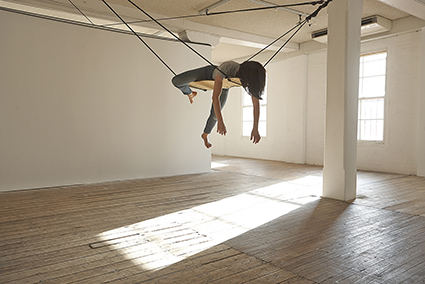
Marianna Joslin, Unstable Moments, Metro Arts
photo Dane Beesley
Marianna Joslin, Unstable Moments, Metro Arts
“‘Delegated performance’ is the act of hiring non-professionals or specialists in other fields to be present and performing…on behalf of the artist, and following his or her instructions.” Claire Bishop, “Delegated performance: outsourcing authenticity,” October, No 140, Spring 2012.
Flying or falling, supported or bound, what are the visible and invisible structures in landscape and culture that hold our vulnerable bodies in suspension? These are the strictures explored in the new solo exhibition at Metro Arts by Melbourne-based performance artist Mira Oosterweghel.
In the essay accompanying the exhibition, academic Anne Marsh comments that Oosterweghel has rapidly built “a strong practice in the field of body art and delegated performance.” The latter is a distinctive preoccupation for a young Australian performance artist in a small national scene that still heavily emphasises the actual artist’s presence.
Oosterweghel’s elegant installation at Metro Arts seems like the climax of a long journey from sculptural form to large-scale delegated performance. Indeed, when I interviewed her she described how that ‘intuitive’ process began. “During my training in sculpture I would often use my own body to experiment with my works…This was how I developed my first performative work, where I filmed myself laboriously pushing around a lump of play-dough equal to my own weight.’’
While drawn to the feminist ideals of body art, Oosterweghel became frustrated with the autobiographical readings of her work that would sometimes undermine her political or conceptual intentions. She turned to delegated performance to provide a sense of clarity. This involved not just working with performers but accepting delegations from other performance artists, such as Australian performance art pioneer Jill Scott. Oosterweghel’s delegated works have grown from solo pieces to complex installations such as My Technique is my Own (2015) which involved four performers straining in suspension harnesses anchored to a gallery floor.
What is fascinating about her body of work is the evident care with which the artist frames the performances. Dressed in monotones (grey, white or black) her collaborators look ordinary but somehow uniform; capable of performing the physical tasks required but in no way ‘trained.’ There is a sense of looseness about the tasks in which they have been instructed despite the physical skill and exertion required to be bound, suspended or harnessed.
Indeed, these signature apparatus make their appearance in the Metro exhibition. Oosterweghel’s work is highly responsive to site and she was excited to work in the large white heritage open space of the Metro Gallery which is separated by low walls and large pillars into three sections.
In the first section, the first male performer and veteran of Oosterweghel’s work, Lachlan Tetlow-Stuart, was in a harness anchored to the wall closest to the entrance. He strained against the harness, rebounding like a rubber band but stopping often to interact with people in the space. The second male performer worked in the middle space, which was diagonally cut across by a rope ladder, anchored at the bottom of the wall and the top. Slowly, methodically and resisting eye contact, he ascended the constantly wobbling ladder with a great deal of concentration.
The final installation was the most precarious and engaging. A birdlike woman in skinny jeans and with painted red toenails balanced on a paddle-shaped board. The board was held in a complex set of suspension lines that radiated like a spider’s web from a central anchor on the floor of the gallery where the floating white gallery wall met the broad planks of the wooden floor.
Slumped over the board, the performer’s arms and legs dangled, only her toes tensed. Next, she raised her arms and propelled herself through the air. As she flew, she was constantly making tiny adjustments to stop falling. She did not acknowledge us watching her fly, but when we came close, she smiled and invited us to push.
Viewed from the side of the gallery the three installations could be seen together in a mesmerising tableau: cogs in a wheel, mice in a cage, vulnerable bodies in webs of pressure and balance. The strength of the work was that sense of line and tension, detachment and experimentation. Yet these qualities were also problematic, the stripped elegance and formal composition lacking that abjected body, that strain or compromise that had given some of Oosterweghel’s prior works their edge and that primal quality needed in body art.
However, this is a minor quibble about an installation that had been meticulously planned and constructed and that showed a true artist navigating her own path, blazing a new generational trail in performance art.
Mira Oosterweghel, Unstable Moments, Metro Arts, Brisbane, 22 April-9 May 2015
RealTime issue #127 June-July 2015 pg. 14
© Kathryn Kelly; for permission to reproduce apply to realtime@realtimearts.net
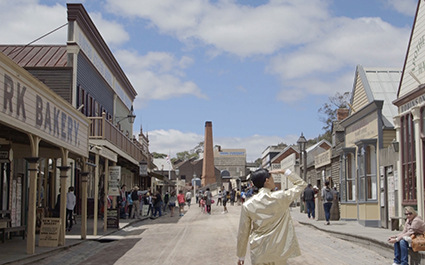
Eugenia Lim, Yellow Peril, 2015, single channel HD video
photo courtesy Bus Projects
Eugenia Lim, Yellow Peril, 2015, single channel HD video
Melbourne’s infamous public sculpture, Ron Robertson-Swann’s abstract, minimalist Vault (1980), evokes hoards of hidden riches with its official title and bears the racist slur of its nickname garnered when its sun-bright planes were first unveiled: ‘the Yellow Peril.’ Eugenia Lim cleverly and playfully incorporates Robertson-Swann’s prefabricated steel icon into her own Yellow Peril in which sculpture, photography and video interplay to explore ideas around mining and immigration, and concomitant themes of hope, desire and the quest for prosperity.
Yellow Peril encompasses five components: an eponymously named video work, two small sculptures and two shimmering photographic works printed on gold Mylar emergency blankets. In the video, Lim poses as a mysterious ‘Ambassador’ in a gold Mao-suit, walking the faux streets of Sovereign Hill, Victoria’s open-air Gold Rush museum-cum-time-warp theme park. Think baskets, bonnets, blacksmiths and buggies, plus tourists with selfie-sticks traipsing along dusty thoroughfares. Shot by Tim Hillier, the video looks all the more surreal for its CGI-like angles and colours. Watching it feels like stepping into both 1850s Ballarat and a digital animation, as Lim’s unassuming character wanders, largely ignored, through the town.
Making cameo appearances in the video are both Robertson-Swann’s icon and what was once the biggest gold nugget ever found: the Welcome Stranger. Lim’s own replica of Vault, just 10cm long and crafted in cardboard and gold leaf, occasionally appears in the Ambassador’s palm, while a large model of the Welcome Stranger accompanies her to a photographer’s studio where she poses with it in an ironic rewriting of history. On a shelf at Bus Projects gallery, the little Vault model and a miniature Welcome Stranger shimmer across from two leaf-thin Mylar blankets hung side by side. On their myriad gold rectangular panels—reminiscent of ingots—is a pair of black and white photographs. One features the Ambassador posed formally with the giant nugget in front of draped curtains and painted backdrop. On the other, Lim’s parents are seen standing in fuzzy black-and-white in front of the real Vault sculpture in the centre of Melbourne, shortly after their migration from Singapore to Australia.
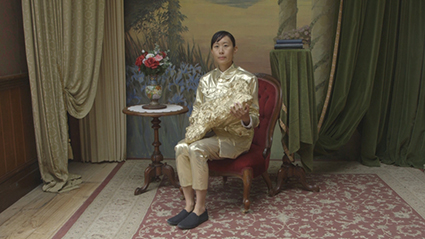
Eugenia Lim, Yellow Peril, 2015, single channel video
image courtesy Bus Projects
Eugenia Lim, Yellow Peril, 2015, single channel video
Eugenia Lim has worked frequently with invented characters and deliberate anachronisms, and often with personas that feed into explorations of Asian identities in different cultural contexts. In her artist talk for Yellow Peril she explained that the archival photo of her parents directly inspired this work, making it more personal than previous projects. She decided to explore the motif of the Yellow Peril “and also in a broader context the relationship between China and Australia, socially and politically.” Seeking a location that would allow her to employ both “humour and deadpanness,” in a manner both “potent and fun,” she settled on Sovereign Hill. “It struck me how performative it already was, with people from different eras, bakers and diggers, Chinese mainland tourists, other tourists—so if you go there you feel like you’re in Disneyland or somewhere […] There are also ghost towns around that area that died after the boom—we’re in a different boom now, of course.”
Indeed, Lim’s Ambassador wanders around the fake boom-town like a ghost, largely unnoticed by the tourists, or assumed to be part of the scene. The character, Lim said, was informed in part by Chinese-born artist Tseng Kwong Chi, who used a Mao suit in his work in the 1980s to explore different locations; he had once worn one in New York because he couldn’t yet afford a Western suit and found he was treated like some high-level Chinese delegate. “The suit made people treat him like an esteemed ‘other’ when he’d been in New York for years and was fluent in English,” said Lim.
The Welcome Stranger nugget no longer exists, having been melted down shortly after its discovery. Its various gleaming replicas, the Vault sculpture and the fuzzy image of Lim’s parents at the start of their life in Australia, suggest intertwined and very different searches for wealth across eras and political spaces, while the juxtaposition of Lim’s ghostly Ambassador with Sovereign Hill’s Gold-Rush characters and bemused tourists suggests a mesh of desires and histories not easily teased out and resolved. Our hunger to mine the earth is in there, certainly; so too, hinted at by the floating Mylar emergency blankets, is the fragility of human life and the journeys taken by so many in search of ‘promised lands.’ Yellow Peril resists a clear narrative, though, content to let ghosts and echoes drift alongside the wooden façades, the flat steel panels and the pitted surfaces of what lies hidden below ground.
Eugenia Lim, Yellow Peril; Bus Projects, Melbourne, 8–25 April
RealTime issue #127 June-July 2015 pg. 15
© Urszula Dawkins; for permission to reproduce apply to realtime@realtimearts.net
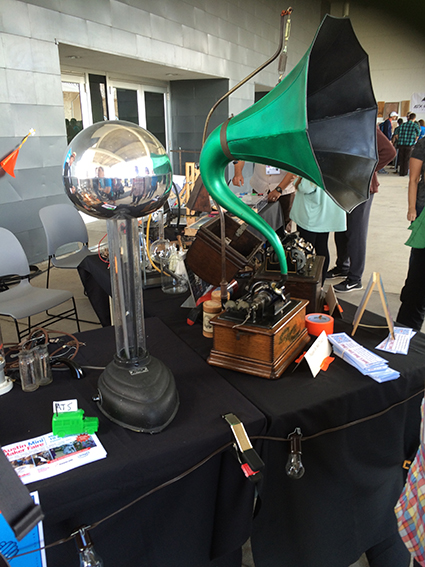
The Market SXSW
photo Catherine Fargher
The Market SXSW
I make my way to the Austin Convention Centre on the day before SXSW Interactive commences to meet Kylee Ingram, an Australian producer with her own company, Elevator Entertainment. Digital entrepreneurs are already hawking their wares and Kylee and I are greeted by Kyle Kemper, a ‘virtual exchange’ guru from Ottowa Canada.
Looking like Charlie from the Chocolate Factory, Kyle is a spruiker of Bitcoin. He charms many attendees by offering virtual currency for beers, pies and popcorn, depending on guests’ countries of origin. This kind of promotional activity is a strong strand of SXSW, along with trade pavilions, startup hubs, game pavilions, keynote speakers and specialist conference strands in areas as diverse as gaming, art and science, content and distribution, marketing and branding.
Maker movement and gaming pavilion
On day one, I make my way to SXCreate where a range of inventors, scientists, makers and performers spruik 3D printers, electrical gadgetry, robots and VR goggles to the public and offer live science-show performances. I note the space is full of curious and inquisitive locals and their kids doing hands-on interacting. Unlike the Gaming Pavilion, a mix of commercial and indie game makers and sellers, this space has a distinctly DIY feel and something of a steam-punk paradise about it.
Lovejams, Art Games & Game Innovation
At the Long Centre Gaming Conference sessions, I attend a session titled Lovejams, Art Games and Game Innovation at USC with developer Tracey Fullerton, an Associate Professor at University of Southern California School of Cinematic Arts, director of their Game Innovation Lab. She has made a series of games that are both educational and creative. Walden, a game, simulates the experiment in living made by Thoreau at Walden Pond in 1845-47. Fullerton notes that games are not a “can opener to teach specific things.” She suggests that gamification as a concept can be misleading. “Games don’t make things easier, they make things hard. At their best they challenge the intellect, and make you learn in new ways.”
A game creating a buzz throughout SXSW is Never Alone, a collaboration between Alaskan Inuit storytellers. Nearly 40 Alaskan Native elders, storytellers and community members contributed to the development of the game. The Cook Inlet Tribal Council’s CEO Gloria O’Neill, is also the founder of Upper One games, which merged with Alan Gershenfeld’s E-Line media to create this BAFTA-winning game—a direct partnership with the Indigenous people themselves in an inclusive development process requiring serious commitment from all parties, from initial concepts to final product. Inspired by the rich art and imagery of Alaskan Native cultures, Never Alone brings the atmospheric and compelling world of traditional Iñupiaq stories alive. The developers expressed interest in sharing this model with other indigenous communities, such as Australia’s, as a tremendous opportunity to delve deeply into folklore to find stories that can be expressed in unique ways through video games for sharing with global audiences.
Games redefine learning
I saw many exciting projects from Canada, specifically Quebec. Brothers Devin and Shawn Young created Classcraft, an online platform that turns any classroom into a giant role-playing game for the school year. Its success resulted in a $1 million grant from the Canada Film Council and the game being used in schools throughout the world, including 31 in Australia, ranging from late primary to high school. The game was developed initially as a basic prototype in Shawn Young’s work as a Quebec high school teacher, mainly as a means of motivating at-risk students to become more involved in classroom and group activity. It developed into giving student teams ‘character identities’ in a fantasy game environment, allowing them to ‘play’ in a series of quests as well as random activities.
Quests might involve battles in which special powers are awarded, which create real life outcomes, such as the opportunity to submit an assessment a day late, or in the case of a punishment incurred in the game, students might be required to read unfamiliar poetry in front of the class. Random game activities might include “today’s event” where “The Kitty Master” informs students that “you are cursed by the crazy cat lady,” so everyone must end sentences with a “miaow” or lose 5 points. Students’ involvement has become such that they are attending school to stay with their team and achieve results, and to see what todays ‘random’ events might be, which translates into growing self esteem and real life education outcomes. Classcraft play might take six to ten minutes of the day, alongside regular curriculum activities. The fact that the game is fun to play, rather than being an educational game per se, and has real life outcomes that are meaningful to the students, has led to its phenomenal success.
The Future of Storytelling: FOST
FOST founding member Charles Melcher, once a leading New York publisher, explores ways of learning, appealing to multiple learning intelligences via interactivity. He argues that interactive publishing can allow for the Socratic tradition (of dialogue as educational) to be extended, given that when something is written down it can become ‘dead’ language and microtonal facial expressions and subtlety of hand gestures are lost. Research at Columbia University has shown that by using new media to work with kids with disabilities such as Dyslexia and ADD, various cognitive recognition modalities can be used. Melcher suggests that it will take a while before we work out the unique properties of new media as we are, to some extent, still ‘setting up the camera.’
Immersive storytelling & the internet of things
Lastly I see Lance Weiller, one of the immersive storytelling leaders in the US who inspired me to come to SXSW. Along with Sagaworld.ca’s Jonathon Belisle and Vincent Routhier from Quebec and interactive toy design, video mapping and projection artist Meghan Athavale from Winnipeg, Weiller discusses the basic grammar of telling immersive and interactive stories. Surprisingly, his methodologies for storytelling and building scenes and narrative borrow strongly from cultural storytelling and mapping exercises popular in community cultural development and theatre models from the 1980s to today. His tools include telling stories with objects, creating scenes with post-it notes and finding the hot-spots in a story; all storytelling and theatre conventions in use today. What is different is that Weiller encourages his postgrad students to use wearables and sensors as their objects within this process, creating an environment where a story can be told in a networked environment where the ‘internet of things’ [physical objects embedded with electronics etc. Eds] creates context and interactivity.
Throughout the sessions with interactive storytellers who build educational and immersive games, the message was the same: games explore play based on series of skills. If you use the skill sets and methods that you already possess to collaborate, play, build groups, communicate or tell stories, game designers can go from there and find systems and mechanics for users to ‘play.’ Unless the process is clear, recognisable and usable by groups, and the skills have relevance to that group, the games may not succeed. Vincent Routhier echoed this idea, when he suggested, “so many developers are caught up in developing the tools, they haven’t actually worked on the play methodology.”
Back in Australia, I note how often people say ‘no’ to new ideas and products. We are used to many forms of cultural funding coming from government sources with well-worn paths to specific ends, often via gatekeepers. The US freemarket economy culture, which is creating a burgeoning podcast, YouTube and maker culture is different from Australia. We expect wages, and to make a living. Fair enough. That’s the Australian way except when it isn’t an option. Texas, the taxi driver tells me is ‘a non union state,’ and that means that start-ups don’t need to provide standard wages; all kinds of deals can be struck independently, with contracts or without. I imagine America in the 19th century, when industrialists and inventors were speculating and creating cars, railroads, lightbulbs, skyscrapers, the products that rode the waves of steam power, electricity and steel. At SXSW, despite the risks, I see that a decade into the new millennium the same sorts of speculation are occurring in the information revolution, technology start-ups, the internet of things. A new frontier will lead to a new order of things, great profits for some, and will favour the brave.
SXSW, Austin, Texas, 13-22 March, 2015
RealTime issue #127 June-July 2015 pg. 16
© Catherine Fargher; for permission to reproduce apply to realtime@realtimearts.net
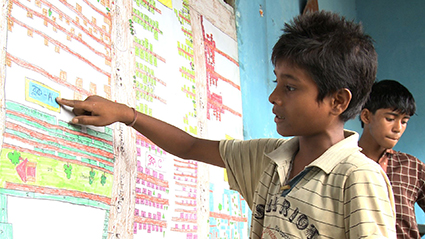
Map Your World, The Revolutionary Optimists, Kolkata
In the space of two years between 2013, when I first attended, and 2015, content acceleration at SXSW Interactive has moved from innovative to exponential and something to write home about.
SXSW is a machine controlled by business; its body, its blood flooded with marketing psychology. The likelihood of brainwash is frighteningly real. Along with cranial lavage, you will need the stomach to attend. It’s also a bloodbath of free, independent thinking. You may leave as I did with a strange mix of adrenalin rush, rising nausea and the sense of hopelessness that any of us, individuals or groups, are free or have the capacity or sway to make social change anywhere in the world or that technology in any form ever was or ever will be good. Corporations have us, and our governments, well stitched up.
Although harder to find in 2015, it’s fascinating that there are gems of unique art and culture framed in this entrepreneurial context. There are conversations that coalesce activism, the senses, community, story and so much more. SXSW Interactive is a week of pure intellectual rigour, conceptual genius, leaps of faith, technical adventure and disruptive reality checks. I haven’t found such a combination anywhere else. In a minefield of charisma, brands, NLP (neuro-linguistic programming) and festival loot, let’s touch on a sprinkling of 2015’s offers dealing with some of our oldest compulsions: immortality, spirituality and revelatory technology.
Martine Rothblatt: immortality & AI selves
Martine Rothblatt is CEO and Chairman of United Therapeutics, author of Virtually Human: The Promise—and Peril—of Digital Immortality (2014) and of The Apartheid of Sex: Manifesto on the Freedom of Gender (1995). In her interview keynote for SXSW Interactive, part of the Art, Science and Inspiration program, she described her personal quest to alleviate the suffering of transplant patients along with a recount of other super achievements (like the world satellite radio Sirius XM) and of philosophies being forged by her scientific and technological inventions.
The project closest to her heart is based on xenotransplantation: a limitless supply of organs for immediate human transplant, created from genetically modified pigs—and prompted by her daughter’s then incurable lung disease [subsequently cured by Rothblatt and her collaborators]. Rothblatt reports that transplant survival with her new model has gone from hours to eight days. She suggests that once one month is reached, a year and longer will be not far behind.
Her side project is the creation of a digital clone of the human mind made from accessing mannerisms, recollections, feelings, beliefs, attitudes, ethics and values gathered from our digital traces—social media, emails. Google is currently writing mindware from this information. Rothblatt has created a proof of concept, BINA48 (2010), an artificially intelligent mind clone of her wife that inhabits a head and shoulders robotic bust of same. Where these projects and Rothblatt’s philosophies converge is in immortality where networked artificial intelligence enters a constructed living body, to replicate someone who has or already exists.
Reflecting our progress towards Singularity, our vocabulary of terms like “software-mind” is shifting to objectify the human and preference non-human in terms like “brain-based original” and “human-level consciousness.” Rothblatt is also a lawyer. The keynote brought to the fore Rothblatt’s agitation for philosophies and legal steps to provide identity law for future forms of life. A person can be natural or juridical (like a corporation). Wild law extends this premise to the Earth as a legal person with rights of jurisprudence. In Virtually Human, Rothblatt advocates for machine law and the machine as an identity.
I come out of this session, like many others, mind racing, exhilarated by human intelligence and accumulative knowledge yet sort of shattered: not really understanding tomorrow, alienated from fellow humans, asking why we desire the things Rothblatt proposes. I feel the incongruity of a new generation gap to come. Someone online asks, “Who pays to maintain this virtual self after the person it was created for dies?”Are these constructions responsible for their own survival or will they be wards of state? What are the economic drivers? At what point is the non-human reclassified as human? Questions to add to those for SymbioticA’s Neolife Symposium 1-3 October this year.
Rothblatt rolls out her vision as if it’s natural evolution. She makes sense, she’s rational, progressive, she’s emotionally connected, she has a family, is a political activist, founded a religion. We are frogs taking a swim in a satellite-connected waterhole of her making with very high sides, set over a flame.
Spirituality Through Interactive Technology
I found comfort at the Spirituality Through Interactive Technology panel, an intriguing gathering of cross-disciplinary humans in the audience: health practitioners, filmmakers, scientists and spiritualists. The session led with the premise that traditional interactive media has a bias for thinking from the perspective of the other, highlighting instead early trends that make space for “internal immersion” through self-perspective—that VR experiences in this vein are described with the word ‘presence’ and that VR is being used in new ways. And that presence and the intensity which people experience through these new experiences is producing happiness and empathy.
The conversation extended to neuroscience research by Olaf Blanke into perceptions of presence and other recent research suggesting that the brain is an embassy of the digestive system, not the centre but a creation of a more ancient system and placed at the periphery—our heads. There are after all more nerve cells in the digestive system than there are in the brain.
The session was run by interactive story architect and choreographer Michel Reilhec and Opeyemi Olukemi, Manager, Interactive at Tribeca Film Institute. Artists from the TFI program ANAGRAM (UK) hosted their own panel, with a pen and ink artist, on the junction of VR and physical artforms: How to Play with VR, Physical Spaces and Ink. The panel featured insights into Door Into the Dark, an immersive experience in personal documentary storytelling [in which lone participants become profoundly lost in the ANAGRAM installation, wearing a sensory deprivation helmet, travelling along a rope, cued mostly by touch and audio instructions. Eds].
Technicians of the Sacred: The New Native Apps
This session was convened by Wendy Levy, filmmaker and Executive Director, New Arts Axis, an organisation dedicated to facilitating creative innovation for arts, culture and human rights. Levy was previously in Australia for Hive Labs 2012. The panel focused on projects that bring tribal wisdom to the technology table, featuring two maps for action projects.
Save Wiyabi Mapping Project “aims to decolonise the anti-violence movement” and uses “digital feminism and technology.” Lauren Chief Elk, co-founder of the project, describes limitations in the collection of ethnicity data by USA authorities that document deaths. In the recent past only two data points were collected—a single ethnicity (Latino/Hispanic) or none. Death reporting is also governed by jurisdiction; there is no centralized data consolidation point. This creates a dark sinkhole for the visibility of genocidal femicide. The project is a map and database of missing and murdered Indigenous women that now invites global submissions. Australia is missing.
Another project, Map Your World is run with Google Maps and Earth. Presenter Eric Doversberger, Production Manager, People Analytics explained that the tools are open source with resources for project setup available, aiming to empower groups to create private or public maps populated with multiplatform story content. For example The Revolutionary Optimists, initiated by Indian lawyer turned social activist Amlan Ganguly. This has children in Kolkata conducting interviews about the health of water wells—location, colour, smell and who’s getting sick. In the beginning, they worked predominantly on paper. They collected so much data that they were able to make reports and petition for new wells. Another project led by Chief Almir, of the Surui tribe of the Brazilian Amazon, used the Map Your Indigenous Community to map traditional land. The model aims to close the gap between elders and young people and offers children new skills. A key outcome is Chief Almir’s ability to track and pinpoint illegal deforestation.
October each year is Map Your Indigenous Community Month. The project team will be visiting Australia to run workshops and talk to communities. Perhaps of interest for Australia’s war on terror and ‘lifestyle choices’?
SXSW, Austin, Texas, 13-22 March
RealTime issue #127 June-July 2015 pg. 17
© Cat Jones; for permission to reproduce apply to realtime@realtimearts.net
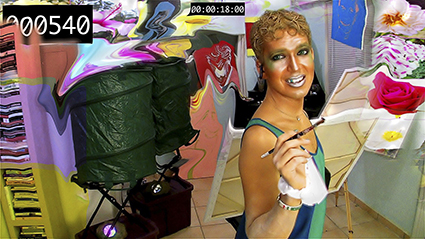
Re’Search Wait’S
Too fast, too much, too messy, too everything. The suite of four videos that comprise Ryan Trecartin’s Re’Search Wait’S (2009-10) certainly ticks the boxes of video overload, aural saturation, performative freneticism, hyper-banality, lo-res assault. Riffing on Trecartin’s ‘unmonumental’/post-mashup/post-Internet take on Video Art, the extant writing on its screenic/headphonic pixel-partying mostly misses the materiality of his audiovisuality and the specificity of its televisual lineage. For despite whatever convoluted interior narrative logic they propose or whatever uber-zeitgeist-dystopia can be extracted from their artistic construction, his works are mostly about one thing: being fucked-up.
This state is primarily determined by the relentless clash between performers embodying characters, figures, memes, beings, glyphs and emoticons and how their embodiment evidences an integral dislocation between a person and the life and work they lead. Across Re’Search Wait’S’s parade of wannabe-art-stars, lank-office-schmos, acid-pixie-bitches and tween-porno-queens, one senses a distinctive mode of theatricality—like Brecht on angel-dusted helium. I don’t need to read this or perceive it because I’m being told it non-stop (across nearly two hours as I take in all four videos in their entirety).
Despite Re’Search Wait’S visual bombast, its soundtrack highlights this performative schism. Featuring roomy dialogue caught solely by in-camera microphones and pitch-shifted in post-production, it streams Chipmunked phraseology adopted within crappy pseudo-corporate workplaces, shitty rented apartments and roaming interzones where friends therapeutically bitch and gripe. Each of these zones in reality is neurotically fortified by its insular argot and semantics, the mastering of which grants power to one intent on commandeering its terrain. The diarrhoeic speech delivered by Trecartin and others in multiple roles portrays them as masters of this language. But the adherence to each zone’s linguistic logic also entails one’s disenfranchisement within such a fabricated system governed by cynical exploitation: people prove how fucked-up they are by laying the greatest claims to not being so.
Yet Re’Search Wait’S embraces the hysterical unfit between the self and its socialisation, here expressed by the tyrannical voice-track which dictates all the fragmented responses, engagements and altercations acted out and up by its self-immolating cast. In this sense, Ryan Trecartin is listening to not only what people say, but how what they say about themselves likely contradicts any sense of self identity. This type of linguistic disjuncture is an inevitable staple of Web 2.0, because once so many people start talking/filing/sharing/commenting/linking on any topic, their speech will approach the event horizon of lifting off from its societal plane and floating into a meta-speech realm detached from its originating communicative impulse. Thus a ‘meme-onic’ wordscape floats like a data field and virtually downloads itself into the ‘real world’ of your office, your flat, your favourite bar, your mind. Disjuncture then becomes a mode of synchronisation—that is, of speaking in ways that invent a cleft yet bipartisan state where two people communicate via noise, interference, overload and multiplicity. Similar to Web 2.0’s deliberated collapses of communication, Re’Search Wait’S characters are full of lens-centric monologues. Neither interior not exterior, they are directed to the same void that a billion loser vloggers believe is their other half: a phantom corpus engineered by vapid comments which the vlogger takes personally.
The secondary level of Re’Search Wait’S’ attraction to being fucked-up is ontologically encoded in the videos. Departing from High Modernism’s extolment of destructive acts, Trecartin’s auteurship is built from the prefab tagging of creativity which all software promises its users. Drolly pretending to believe this hype (itself a theatrical stance inherited from Warhol through to Corey Arcangel), iMovie vfx-editing and Frooty Loops audio-tracking is employed to the point of self-destruction.
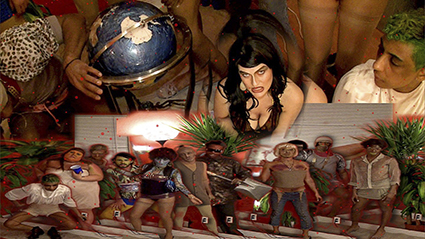
Re’Search Wait’S
And while this enables a reading through Pop Art strategies, I’m more reminded of Pop music’s own celebration of this wilful and perverse destruction. For the recurring gesture of smashing stuff up that frequently appears in Re’Search Wait’S is fucked-up teen 101. Its formative televisual moment originates in early music videos like Twisted Sister’s “We’re Not Going To Take It” (1984) and The Beastie Boys “Fight For Your Right To Party” (1988): their performers pathetically destroy cheap sets. This impulse synchs to a substream of music videos, stretching from The Prodigy’s POV meltdown “Smack My Bitch Up” (1997) to Andrew W.K.’s bloodied “Party Hard” (2001) to Ke$ha’s morning-after “TiK ToK” (2009) to Die Antwoord’s “Baby’s On Fire” (2012)—even to Miley Cyrus’ vainglorious “Wrecking Ball” (2013). In cinema, it’s lauded in Greg Araki’s Totally Fucked Up (1993), Larry Clark’s Kids (1995) and Bully (2001), Harmony Korine’s Gummo (1997) and Trash Humpers (2009), Jason Kahn’s Detention (2011) and Todd Phillips’ Hangover trilogy (2009, 2011, 2013). While contemporary art continues to become bogged down in its graduate course PowerPoints on globalism and artistic responsibilities, Re’Search Wait’S aligns itself with this distinctive televisual music history of fake histrionics and destructive theatrics.
Running parallel to being fucked-up is Re’Search Wait’S’ fixation on the manifold methods of curing those who are fucked-up. And maybe these characters—like the various ‘consultants,’ ‘stylists’ and ‘freelance advisors’ who are forever imparting advice in the four videos—are the most fucked-up. They speak half a century of American psycho-babble and self-help hucksterism. (Even Andrew W.K turned to ‘motivational speaking’ in 2005, imparting a keynote in 2014 titled “Andrew W.K. and The Philosophy of Partying.”) Possibly the clearest art-line thrown here is to Paul Morrissey’s Flesh (1968), Trash (1970), Women In Revolt (1971) and Heat (1972), whose Warhol superstars Joe Dellasandro, Holly Woodlawn, Andrea Feldman, Jackie Curtis and Candy Darling beautifully portray fucked-up characters all the while mouthing self-help diatribes. Trecartin’s characters are a meld of those superstars, and the nobodies embroiled in staged moralistic interventions who willingly appeared on early 90s tabloid talk shows like Jenny Jones, Jerry Springer and Ricki Lake (the latter of course an original actress in four films by John Waters—himself an astute aficionado of the fucked-up).
Again, it’s the maniacal pitch-altered, time-compressed, data-corrupted cam-crap which dumps this loquacious assuagement directly in one’s claustrophobic headspace via headphones (the means for auditing all these works in their installation format). This intensifies the presence of the spoken, accenting its ceaseless drooling and dribbling and its breathless drive to forestall silence and the dead air of calm reflection. While the connections to the 90s phenomena of AutoTune pop hits and underground dance sub-genres like Gabba and Happy Hardcore are apparent in these Gerbil/Chipmunk voicings, I’m reminded of earlier canny grapplings with consumerist newspeak and voice manipulation in records like Moon Unit Zappa’s “Valley Girl” (1982) and Will Powers’ “Adventures In Success” (1983). The former mimicked the advent of the San Fernando Valley’s mall-bitch intonations; the latter down-pitched Lynne Goldsmith’s voice to affect a camp male new-age guru. These days, such gabble echoes through Michael Alig’s early 90s Party Kids doing the tabloid talk show circuit, to VHS self-improvement web archive Everything Is Terrible! (since 2007), to AOL’s ‘digital prophet’ David Shing giving TED talks in 2014. Re’Search Wait’S talks the same talk.
–
Ryan Trecartin, Re’Search Wait’S (2009-10), NGV International, National Gallery of Victoria, Melbourne, 15 May-13 Sep
RealTime issue #127 June-July 2015 pg. 18-19
© Philip Brophy; for permission to reproduce apply to realtime@realtimearts.net
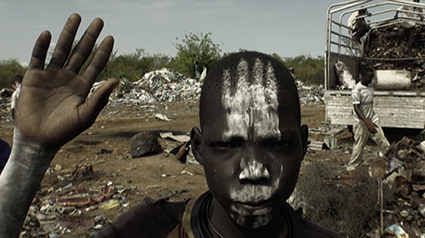
We Come As Friends
We buy our tickets and watch the films in our comfortable, air conditioned cinemas. We feel concerned, angry and outraged. We express all this and more to each other in fashionable bars after the screenings. Some of us get paid to pontificate on the horror we have witnessed on screen. One of us writes, “It all makes me extremely embarrassed to be a privileged white American eating mini-Snickers in a climate-controlled theatre” (“We Come as Friends,” Slug Magazine, 20 January 2014). Those of us who write lines like these tap out our words on fashionable computers manufactured by Chinese workers just as exploited as the people we write about. We feel bad, but reassured that we’re distressed by our privilege.
Watching Hubert Sauper’s We Come As Friends at this year’s Human Rights Arts and Film Festival in Melbourne, I couldn’t help wondering if documentaries—or at least a certain type of documentary, and the reactions it elicits—do more to reaffirm structures of global inequality than we’d care to admit. Is there a better way to affect change than simply pointing our cameras at misery?
Sauper’s film is surreal, impressionistic and unrelentingly confronting in its offhand representation of real life awfulness—much like the filmmaker’s previous effort, Darwin’s Nightmare (2004). But where Sauper’s earlier film gradually built a layered picture of a specific situation—the processing industry around Tanzania’s Lake Victoria that supplies much of Europe’s fish products—We Come As Friends depicts a larger and more diffuse state of affairs. Broadly, the unifying thread here is the reiteration in the present of a relationship established centuries ago between Africa and the rest of the world—richer countries come to Africa, they divide and they plunder. The dividing here is starkly in evidence, as the film is shot in Sudan in the lead up to the 2011 referendum that saw the country split into two nations.
We Come As Friends opens with views of the Earth’s surface from space and a voiceover from Sauper describing a journey to the “foreign planet” of Africa. The camera then walks beside one of the “aliens”—a small, naked boy, smiling at the lens. It’s an opening heavy with irony, or is it? We’re at the Human Rights Festival, right? Surely we don’t view Africa this way?
Next we see confused scenes around a tiny, homemade plane belonging to the director. He appears grounded, as unidentified uniformed men mill about. Like much we see over the following two hours, the scene is confused, confusing and ultimately unexplained.
Then we see Sauper flying his plane over Africa and landing in the middle of various situations in places unnamed in South Sudan, where he meets a range of fellow visitors to this alien land. To the locals he shows a signed document affirming that he is “a friend.” He hangs out with Chinese oil workers who extract thousands of barrels a day to send back home. He films the American ambassador opening a power station, “bringing literal and metaphorical light” to the area. He chats with a British bomb disposal expert who wonders why the Africans are still 200 years behind the rest of the world. And, most frightening in their brazen, blind colonialist vigour, a settlement of Texan Christian missionaries he stumbles across breathlessly explain that there are children “literally running around villages naked” a few miles away who need to be educated in God’s ways (rather oddly for the supreme creator of the universe, God is apparently very concerned about what we are wearing). Later we see the missionaries forcing new white socks onto the feet of some of the aforementioned naked African children.
There’s no doubt We Come As Friends succeeds in conveying a sense of all-pervasive exploitation, of ‘us’ conquering, objectifying and stealing from ‘them.’ Sauper’s scattershot approach, however, does little to really illuminate what we see happening here.
In a recent interview Sauper commented, “Every scene you see in the film, I can talk for three hours about what it is, what’s the context” (Film Comment, 12 May 2014). While watching We Come As Friends I often wished he would do just that, home in on a particular instance and help us grasp what is actually going on, instead of just bombarding us with hopelessness dressed up with irony. For without any sense of elucidation beyond a sense of pervasive exploitation, all we are left with is yet another portrait of Africa as an unredeemable basket case of poverty, violence and conflict. More than enough, I suppose, to make middle-class Western viewers feel “embarrassed,” but presumably this is of little comfort to the people on screen.
More disturbingly, I couldn’t help feeling that Sauper himself—and by extension his audience, including myself—were part of the problem. And I don’t mean the film encourages us to reflect on our own imbrication in the economic relationships we see on screen. That might possibly be of some use. Rather, the film places filmmaker and audience firmly on one side, and those onscreen–sufferers and exploiters alike—on the other. We can sit at comfortable arm’s-length, shake our heads about those Westerners creating all these problems and essentially remain uninvolved, aside from, you know, feeling bad about being on the winning side in all this.
The “alien planet” metaphor that kicks off the film establishes the problematic dynamic. While it unsubtly draws attention to the ethnographic lens through which most of us still view the African continent, the rest of the film does little to really upset or even question the neo-colonial relationship that so often underpins this kind of filmmaking, between rich people with money and cameras and people we point cameras at and fix within our own frame of reference.
There are several scenes, for example, in which Sauper talks to local African people who begin to offer informed critiques of Sudan’s situation, steeped not only in historical knowledge but also their owned, lived experience. Like everything else we see, however, these interludes are presented as de-contextualised snatches. We get no real sense of who these people are or the precise circumstances they are discussing, and their voices are swamped by the cacophony of other images and sounds that pass before us. The Texan missionaries, in fact, get much more screen time. We’re really left none the wiser about local reactions to all this, other than the rather obvious point that most Africans are less than happy about their situation. I kept wishing Sauper would give his camera to one of the locals and let them make a film instead.
Frankly, do we really need another film about Africa made by a European–even, or perhaps especially, a well-meaning one? Do we really need another white middle-class filmmaker landing in a foreign land, extracting scenes of misery with his or her lens, and bringing them home for Western consumption? If Hubert Sauper had given his camera to one of the locals he interviewed, I wonder if their film would have made us feel more than “embarrassed” as we munched on our Snickers?
We Come As Friends, director Hubert Sauper, producers Hubert Sauper, Gabriele Kranzelbinder; Human Rights Arts and Film Festival, Australian Centre for the Moving Image, Melbourne, 7–21 May
RealTime issue #127 June-July 2015 pg. 20
© Dan Edwards; for permission to reproduce apply to realtime@realtimearts.net
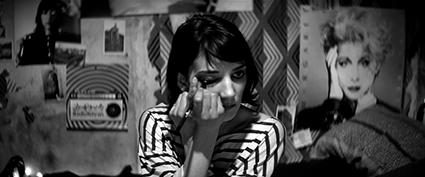
Sheila Vand, A Girl Walks Home Alone at Night
Ana Lily Amirpour’s debut feature film cultivates a mysteriousness beginning with its setting, the fictional Bad City, a Persian-speaking semi-rural town where dead bodies are daily dragged into a ditch on the outskirts with no explanation. Bad City is simultaneously of the East, with its language, glimpses of Islamic TV and title character’s chador; and of the West, with its stylistic nod to the Western and its allusion, in name and noir-ish, graphic aesthetic, to Frank Miller’s quintessentially American comic and film series, Sin City.
A shadow world, it floats in time as well as geographically. Arash (Arash Marandi), the handsome young protagonist, has scrimped for a classic 50s American car and wears the James Dean ensemble of tight white T-shirt, jeans and leather jacket with an air not of imitation but of someone who has sprung from the era. In contrast, Saeed (Dominic Rains), the blinged, tattooed drug dealer who holds sway over several characters’ lives, belongs to the present. At home when she removes her chador, the Girl (Sheila Vand), with striped top, heavy eyeliner and bobbed hair could belong anywhere from the 1960s to the 80s to now, an ambiguity befitting her vampiric state.
With its fable-like archetypes, revealed in the credits—the Girl, the Pimp, the Prostitute, the Princess—as well as its expressive movement and emphasis on the gaze, the film displays the intensity of silent cinema, with Murnau’s Sunrise: A Song of Two Humans (1927) and (for obvious reasons) Nosferatu (1922) brought to mind. Amirpour’s hypnotic use of slow, deliberate movement is a defining feature. Characters dance: the drug dealer writhes seductively; the Princess and friends undulate trance-like at a Halloween party; the Girl in her bedroom twists to stolen LPs. Young lovers move ever so gradually towards each other in an incremental embrace. Movement disconcerts while it mesmerises, as when the Girl glides in search of prey along depopulated night-time streets, at one point mimicking the gait of a victim from across the road.
While the film might make use of archetypes, it undercuts them through the figure of the Girl, whose apparent vulnerability deceives her prey. Walking home alone at night (an action that women are constantly advised against) the Girl becomes the locus of fear rather than its victim. Her perceived girlishness and feminine piety house something primal and frightening. Sheila Vand’s still and watchful performance conveys this masterfully.
Unlike the other characters, Arash is not given an archetype, but like Caleb in that other vampire Western, Kathryn Bigelow’s Near Dark (1987), he represents a purity of heart—or as close as we’ll get to it in Bad City. As with Caleb and his vampire lover Mae, the encounters between Arash and the Girl are weighted with significance.
In Angela Carter’s short story “The Lady of the House of Love,” it is the innocence of the young English soldier (embodied in his virginity) that proves the undoing, or unmaking, of the ancient vampire maiden. Here too, as well as in Near Dark, the young man is a catalyst for change in the female vampire’s life, though Amirpour leaves the exact nature of this change somewhat ambiguous.
See Giveaways for the opportunity to have your own DVD of A Girl Walks Home Alone at Night.
A Girl Walks Home Alone at Night (2014), writer, director Ana Lily Amirpour, cinematography Lyle Vincent; distributor Madman
RealTime issue #127 June-July 2015 pg. 22
© Katerina Sakkas; for permission to reproduce apply to realtime@realtimearts.net
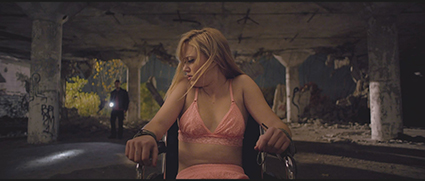
It Follows
After minimal credits, It Follows opens on an escape: a young woman running from a house down an evening street in leafy suburban America. She looks back in terror every so often but neither we, nor those she passes can see the threat. A visceral bass booming accompanies her flight, like a heartbeat. She scrambles into her car and drives to the beach. We see her in a beautiful long shot with the dark sea behind. She leaves her father a tearful phone message.
Next shot: the following morning, the woman’s body on the sand, one high-heeled leg bent at a grotesque angle. After this horrific prelude, we’re back in suburbia—large two-storey houses, stretches of unfenced lawn. Jay (Maika Monroe), our 20-ish protagonist, floats in a small above-ground pool. From here on, It Follows will build terror with exquisite deliberation, displaying a mastery of those liminal moments when the fabric of reality wears thin.
Much of the film’s horror is achieved through narrative suggestion rather than shock effects. Take a scene early on when Jay is on a movie date with Hugh (Jake Weary), someone she clearly likes but doesn’t know all that well. They play a game: taking turns, each of them picks someone in the crowd they’d want to trade places with, while the other guesses whom they’ve picked and why. As they seat themselves, it’s Hugh’s turn to guess Jay’s choice. “The girl in the yellow dress,” he hazards, but there’s no one standing where he’s pointing. A couple of beats. “Is this a joke?” Jay asks. Hugh abruptly suggests they leave, citing sickness. This clever conjuring of a presence we cannot see instantly warps our sense of a secure reality.
Hingeing on a simple premise—the notion of a sexually transmitted evil that assumes human form and follows its victim—It Follows is a very frightening film. Its greatest power lies in the way it creates a sense of two worlds coexisting: the everyday world of college students and suburbia and movie dates overlaid by another reality beyond our understanding. Disasterpeace’s immersive synth soundtrack constantly evokes the otherworldly, shifting between ominous (the booming in the first scene) and something numinous (a sweet chiming as Jay gets ready for her date).
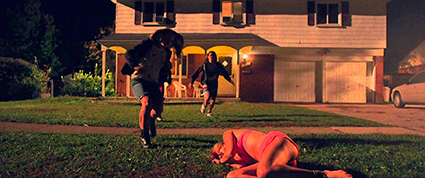
It Follows
Mike Gioulakis’ cinematography repeatedly returns to the long view of a figure or figures centred in a landscape. Nature is shown in crystalline detail. Night scenes are lit as atmospherically as an Edward Hopper painting. The composition of shots often recalls the elaborately sinister tableaux of photographer Gregory Crewdson. We’re in the territory of the Sublime here, where beauty is inextricably linked with terror and awe. Nineteenth century Romantic painters found the Sublime in nature and ruins. It Follows gives us lingering shots of leaves as well as the contemporary urban ruins of Detroit City (employed to similar atmospheric effect by Jim Jarmusch in his 2013 vampire film Only Lovers Left Alive).
This is the aesthetic antithesis of much contemporary horror, particularly the found-footage genre, which pursues a documentary frisson through small-screen grunginess, creating fear of what lies outside of the frame, or beneath the pixellation. The cinematic expansiveness of It Follows, on the other hand, increases our paranoia precisely because we can see so much. When Jay is outside among other people, the eye immediately scans the distance in a “Where’s Wally” manner for suspect figures. The film plays with this tendency by throwing out an occasional red herring, as well as, on one occasion, a possible threat that Jay doesn’t even notice. The use of slow 360-degree rotating shots further emphasises the fact that for the duration of the film, the viewer is enclosed in a big, sublime world encompassing unfathomable terrors.
It Follows (2014), writer, director David Robert Mitchell, cinematography Mike Gioulakis, score Rich Vreeland (as Disasterpeace)
RealTime issue #127 June-July 2015 pg. 23
© Katerina Sakkas; for permission to reproduce apply to realtime@realtimearts.net
The percussionists Louise Devenish and Claire Edwardes teamed up with clarinetist Ashley Smith to close the Totally Huge New Music Festival with a virtuosic and powerful program.
Chris Tonkin’s IN for solo percussion and electronics was first performed in 2005 at Ircam and develops one of the most original sonic palettes in the percussion-and-electronics repertoire. Edwardes spends a fair bit of time rubbing a plastic scrubbing brush in her hands, producing a high buzzing and squeaking sound that can only be described as “puckered.” If that does not put your teeth on edge, then Edwardes’ scraping of a superball down the surface of a bass drum will. The sound is almost exactly like nails on a blackboard. Such close, dry sounds are juxtaposed with more resonant ones, like a bass drum pitch-shifted down into a thunderous, ground-shaking tone. In a show of compositional finesse, the electronic part is independent throughout, less reacting to the instrumental part than accompanying it.
Magnus Lindberg’s Ablauf is a limit-example of power and volume on the clarinet. Piercing shrieks and manic, fortissimo noodling are all part and parcel of contemporary clarinet music. But Ablauf is so violent that one wonders why, after it was composed in 1983, anyone ever bothered writing a clarinet line above mezzo-piano again. Smith dug his feet into the ground at one end of the line of seven music stands. Taking a deep breath, he launched into the piece’s lung-bursting screeches and squawks. The barrage is athletic and relentless. I don’t know how anyone could keep up such ear-piercing volume for so long (there were many fingers in ears around the auditorium). About two-thirds of the way through the piece, the clarinetist actually starts screaming. At first Smith erupted into short vocal explosions among passages of virtuosic fingering, but soon the clarinet was taken out of the equation entirely. Smith effectively stands there and screams like a beast. A soothing bass clarinet movement follows.
Nico Muhly’s It Goes Without Saying does just what the title says. It’s a nice but completely unremarkable solo clarinet piece accompanied by several more pre-recorded clarinets, a harmonium, and some percussion. Smith ‘placed’ each phrase of the clarinet line just so, bringing out its delicate simplicity. Why do I mention the piece at all? Because, as Damien Ricketson’s Time Alone showed, nice needn’t mean boring.
In Time Alone, a solo percussionist explores a motif on a vibraphone with one hand. In the intimate Callaway Auditorium, Edwardes was able to begin very quietly, carefully manipulating the motor with her other hand to bring out beating tones and expressive swells. The simplicity of the opening arpeggios is entirely necessary to reveal the wonder of their harmonic expansion about a third of the way through the piece. As the piece progresses, an electronic part enters with layered, distant-sounding morse code signals. The percussionist also begins humming along to the vibraphone line. So engrossing are Ricketson’s sotto voce harmonic convolutions that I wonder whether it needed to rise to a dynamic climax at all.
Edwardes did very well saying the title of Michael Smetanin’s Finger Funk correctly every time. Two percussionists play the entire piece with their fingers on a marimba. I imagined that striking out note after note with one’s fingertips would be a painful enough prospect, but each note is in fact played as a tremolo with the index fingers of both hands. The piece is interesting choreographically as well as musically, as the two players have to manage their space on the instrument as they execute rapid, raking glissandi with their fingernails and dramatic strikes with their thumbs (protected by erasers strapped on with rubber bands). While the physical discomfort of playing the marimba with one’s fingers understandably limits the repertoire written for this technique, Smetanin shows that there are a broad range of timbral and dynamic possibilities available.
The concert featured an impromptu protest against George Brandis’ redistribution of funding from the Australia Council: Edwardes listed the many Australia Council-funded organisations and projects that have helped her access ever-expanding audiences, including the New Music Network, Tura New Music and Ensemble Offspring, as well as commissioning programs and music venues. This protest was followed by rapturous applause.
Edwardes and Devenish closed the program with a performance of Gyorgy Ligeti’s Continuum. Instead of performing the work on solo harpsichord, the duo distributed the score’s two staves between marimba and vibraphone. On keyboard percussion, Continuum’s wall of shimmering, dissonant sound becomes a transparent interplay of closely interlocking parts. The composition becomes almost three-dimensional in the way that one pattern changes against another, like a cube turning and revealing a new side as the old stays in view. It was a particularly satisfying sort of minimalism: Like Steve Reich with an extended harmonic palette.
Time Alone is packed with distinctive and striking works that display the extreme virtuosity of Edwardes, Devenish, and Smith. It was a bold and celebratory end to a thrilling festival.
The final concert of the 12th Totally Huge New Music Festival provided a feast of percussion repertoire performed by Louise Devenish and Claire Edwardes coupled with the exquisitely virtuosic clarinet playing of Ashley Smith. According to Edwardes, the concert’s curator, Time Alone “pits some of the bigger compositional names of the 20th century… against Australian master of our time… ” (program note).
Beginning with Chris Tonkin’s IN for bass drum and electronics, the audience were pulled into an introspective sound world utilising a bass drum played with homemade rubber mallets, a wire scrubbing brush, and various extended playing techniques. IN features live sound processing to produce a dystopian soundscape reminiscent of film scores. The live electronics, controlled by Tonkin himself, created rumbling hums from the bass drum and static. At several points Edwardes played the scrubbing brush into the microphone, the result of the processing resembling the buzzing of flies. The audience, able to meander the stage after the concert, could see the score for IN. It was apparent that although the piece seemed semi-improvised, Edwardes had meticulously planned her realisation of the semi-graphic score.
Then came Magnus Lindberg’s potent work Ablauf for clarinet and two bass drums, featuring Smith on the clarinet, beginning with a piercingly loud multiphonic chord. Ablauf is described in the program as “squealing clarinet paired with fortissimo concert bass drums”; it frequently featured multiphonics in the clarinet part, requiring both alternate fingerings and singing while playing, accented by thunderous hits on the bass drums.
The work noticeably decrescendos throughout its duration while presented in several sections; the first is piercingly loud coupled with heavy bass drum hits, the second alternates between loud and soft phrases in the clarinet part, the third section is more melodic but with sporadic accents. Then sees the introduction of shouted outbursts from the clarinettist while still playing, which devolves into maniacal nonsense vocals. The clarinet is then swapped for a bass clarinet and the piece finishes softly and lyrically with rumbling swells from the bass drums, a complete juxtaposition with the way it began. The composition showed off Smith’s skill and he easily did it justice.
The Time Alone of the concert’s title appeared as a standalone piece from a larger work called The Secret Noise by Damien Ricketson. Performed by Edwardes, this work for vibraphone and live electronics produced a solitary and ethereal ambient sound. The live electronics represent morse code, resulting in a glitchy and stuttering ambient cloud that suspended above the vibraphone. The piece has a returning three-note motif that is recognisable within the monophonic melody, and although seemingly directionless the work built with the aid of the electronics. The vibrato wheel on the vibraphone is controlled manually by the player, allowing them to have complete control of the musicality of a phrase, and at times the player is also required to hum notes while playing.
Finger Funk by Michael Smetanin provided an entertaining look at the marimba. Played by Edwardes and Devenish on one marimba without mallets, and with only erasers attached to the thumbs to protect the skin, Finger Funk produces a work exploring the muted timbre of the instrument. The actual ‘funk’ part of the title was almost discernable. Given the muted sound and little sustain the piece requires a constant tremolo to play long notes; the overall shape of the work was unrecognisable because of the reduced dynamic contrast. Notes played in the lower range of the marimba became muddy and less distinctive, and the overall sound of the piece featured mostly the attack of the note, the sound of the fingers hitting the wood, rather than actual tone.
Nico Muhly’s It Goes Without Saying is a piece for clarinet and fixed electronics. The piece is similar in style to the works of Jacob Ter Veldhuis, a composer who is well known for pitting live instruments against sampled backings in a virtuosic manner. The live clarinet part played by Smith interacted with the electronic playback, which fused pre-recorded clarinets and electronics in an increasingly dissonant style. At times the live clarinet part became completely over-shadowed by its pre-recorded counterpart, which reduced the effectiveness of the piece.
Originally composed for harpsichord, Edwardes’ ‘arrangement’ of Gyorgy Ligeti’s Continuum featured the marimba and vibraphone played by Edwardes and Devenish respectively. Beginning on a two-note tremolo it evolved throughout the fast-paced work via the addition and subtraction of one note at a time to the initial idea; the phrases pushed and pulled against each other, creating the illusion of phasing and changing meter. The individual parts interacted to create a harmonic wash of sound and the instrumentation produced a timbre that is substantially different and more interesting than the metallic equivalence of the harpsichord.
Later when speaking to Edwardes about the piece she said that she preferred to re-orchestrate rather than arrange, and would play scores as they were written for other instruments. In this case, Continuum was written using traditional two-staved notation, which Edwardes then ‘re-orchestrated’: the vibraphone playing the right hand (higher part) and the marimba playing the left hand (lower part).
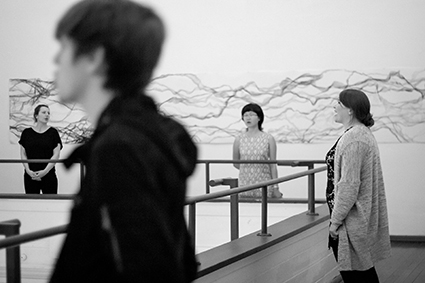
Caption: Gentle steps with an open mouth, Alice Hui-Sheng Chang, Perth iMprov Collective
photo Holly Jade
Caption: Gentle steps with an open mouth, Alice Hui-Sheng Chang, Perth iMprov Collective
The audience is ushered into PICA’s main gallery space to witness Alice Hui-Sheng Chang’s Gentle steps with an open mouth. The upper gallery is dotted with members of the Perth iMprov Collective and other “local voice enthusiasts” (as the program puts it) overlooking us. The concert begins with short, sharp vocal bursts dispersed around the room and slowly transforming in waves over the ensemble into longer sounds.
The sound resonates within the space, creating a completely immersive experience. Vocalists take turns in directing their sound into the open space above the audience, then down and finally towards the walls and up to the ceiling. The resultant sound produced by the dozen or so vocalists, including Chang, is totally encapsulating. At times it feels like the sound itself iss coming out of the walls.
The vocalists are given palm cards by Chang with instructions to produce a range of sounds in order, using extended vocal techniques such as whispering, singing, talking, shouting, sighing, wheezing, tongue-clicking, and growling. At one point the ensemble erupts into a cacophony of cries, screams and manic chatter.
Halfway through the work, the ensemble moves down to the ground floor alongside the audience. The overall sound of the ensemble changes once at ear level. Individual sounds become directional and highly distinguishable, producing fascinating spatialisation as the performers move about. Some members of the ensemble lie on the floor or stand very close to particular audience members, speaking or singing into the walls or up the wall towards the ceiling, changing the way the sound resonated around the space. Two members of the ensemble even seem to have a ‘conversation’ involving quick bursts of air through taught lips while covering parts of their mouth. At times the ensemble sing long rounded tones that settle into a warm consonant sound.
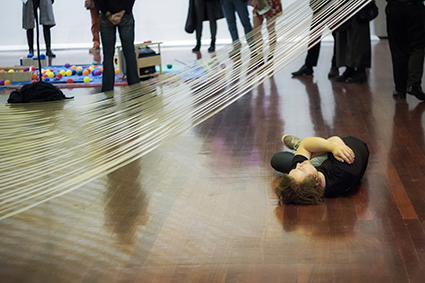
Gentle steps with an open mouth, Alice Hui-Sheng Chang, Perth iMprov Collective
photo Holly Jade
Gentle steps with an open mouth, Alice Hui-Sheng Chang, Perth iMprov Collective
Gentle steps with an open mouth ends with the ensemble dividing themselves on either side of the gallery and standing under the edges of the hanging installation exhibited across with width of the room. They then each fade out separately and sit down until the entire space fills with silence.
Gentle steps with an open mouth is an incredibly engaging work, aided by being performed in such an incredibly reverberant space such as the PICA main gallery. Introducing a physical dimension to the improvisation, the ensemble frames the sounds being made, adding a visual layer to the enchanting noise filling the room.
The second half of the concert features Chang in a solo improvisation. She takes the bare stage before a microphone, lit only by a spotlight and proceeds to make eye contact with every member of the audience before making any sound, in a way that is reassuring and not interfering. Chang’s particular style of extended vocal technique focuses on tension and the control of air, as a way to both make and also affect sound. She controls airflow both with her mouth and throat, which produces anguished, muted sounds. Chang moves around the performance space while improvising; walking behind the curtain and out of sight, and sitting in the audience. Her improvising is introspective; it feels as if she is considering and reflecting on her motives for making particular sounds—the result is concise and holistic. Many solo improvisers attempt to do everything all at once whereas Chang regularly focuses on and develops a single extended technique at a time, and will sometimes cycle through ideas while still remaining grounded, producing a well-rounded improvisation.
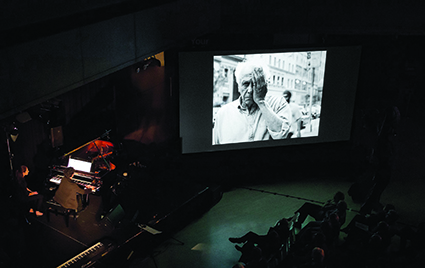
Zubin Kanga plays Transit (2009), video & electronics by Michel van der Aa, Dark Twin
photo Holly Schroeder
Zubin Kanga plays Transit (2009), video & electronics by Michel van der Aa, Dark Twin
The 2015 Metropolis New Music Festival explored original and winding paths around the theme “Music inspired by the moving image.” Where it would have been easy to fill programs with film soundtracks, guest conductor André de Ridder curated a program studded with homages to filmmakers, video art with live scores and imaginary horror-film scores.
Audiences enjoyed a week of Australia’s finest new music ensembles and solo performers before hearing a single piccolo of the Melbourne Symphony Orchestra. The small-to-mediums illustrated their place as leaders in contemporary music by highlighting the importance of video games and digital culture to any discussion of music and the moving image today in concerts programed by Kirsten Siddle.
Speak Percussion
The narrative tropes of video games informed the very first piece of the festival. Peter de Jager’s Fractured Timelines is a multi-modal, gestural romp for three percussionists and piano. Instead of avoiding recognisable thematic, tonal and modal materials, De Jager crams Fractured Timelines full of them. With his thematic riches and multi-modal language, De Jager is like a modern-day Messiaen without God. He gives his themes short descriptions, including “briar” and “creepy mountain path.” These descriptions are drawn less from Messiaen’s sacred imagery than De Jager’s life-long experience playing video games. Commander Keen is still his favourite.
Forest Collective
Forest Collective built their downright creepy program around Marcus Fjellström’s audiovisual triptych Odboy and Erordog. Each episode of the triptych reflects the sequential, task-driven atmosphere of retro computer games and nightmares. Odboy and his trusty Erordog embark on foreboding journeys to perform arduous “chores.” The journeys will be familiar to all retro gamers and light sleepers, including “find the big house” and “cross the spider pit” while “looking out for the wild boar” (echoes of Sierra’s 1989 game Conquests of Camelot?). The first episode includes an electronic score by Fjellström utilising rhythmic record pops and theatre organ that complement the grainy black-and-white video. The second two episodes include written scores for the ensemble, with sparse layers of extended techniques and musical accents.
Ensemble Offspring
Growing up with computer games and colour television certainly did not stop me enjoying the melting black and white celluloid in Ensemble Offspring’s program and the distorting, yellow film by Bill Morrison accompanying Michael Gordon’s piece for solo violin and electronics, Light is Calling. That work was an attempt to “make something beautiful” after the ugliness of the attacks on the World Trade Center on 11 September 2001. Reverberant and reversed samples form a finely textured bed of electronic sound that matches the flickering, stretching images from Rollo Lloyd’s black and white 1926 movie The Bells. The echoing electronic part, lamenting violin and immolating film all seem to mourn a long-lost innocence.
Syzygy Ensemble
Syzygy Ensemble put themselves in the picture via a short film by Agatha Yim interspersed throughout their program. In Yim’s film, the water spirit Undine (Grace Lowry) prances about a Victorian rainforest encountering members of the ensemble. Cellist Blair Harris ineffectually chops wood in his concert blacks, flautist Laila Engle wrestles the Undine for a light bulb and a shot of pianist Leigh Harrold appears for a single frame, floating in water. Syzygy’s program explores the spirit of water in music with a series of flowing and rushing works. Helena Tulve’s Streams 2 is an experiment in musical current. One hears a steady stream from within, like the submerged Undine at the end of Yim’s video. A current not only has force, but depth. Tulve evokes the viscous flow of water with the dark tone of the clarinet. The rest of the ensemble resembles flotsam or the play of light on the water’s surface with ricochet bowing, whispering flortando flurries and rubbed woodblocks.
Zubin Kanga
Zubin Kanga’s Dark Twin program extends the piano through electronics and projections. The audiovisual highlight of the concert was Stefan Prins’ Piano Hero, which references the Guitar Hero computer games where a player presses buttons on a plastic guitar in time with a moving score on the screen. The piece asks whether performance has become so much punctual button pressing and whether the hyperreal actions of the on-screen avatar are greater than those of the diminutive button-presser beside it. Kanga plays a MIDI keyboard that triggers visceral video samples of a man playing a stripped-back piano frame with his hands. Beyond the clever idea, Prins makes extensive musical use of the technical apparatus. The piece begins with the keyboardist triggering only the resonance left after the piano strings are struck. The avatar performer’s hands flicker above the strings, conjuring the resonance out of them. As more violent gestures are introduced, the speed of the gestures is modulated by the MIDI keyboard. This creates striking contrasts between sped-up gestures producing buzzing square-tones and the subsonic rumble of more balletic, slowed-down movements.
Melbourne Symphony Orchestra
It was a pleasure to hear contemporary music writ large after becoming accustomed to the tight-knit intensity of chamber music. The MSO programs explored different ways of making the audience’s skin crawl beginning with Toru Takemitsu’s Nostalghia for solo violin and orchestra, which was written in memory of the filmmaker Andrei Tarkovsky. Tarkovsky develops tension through long, wide shots of indifferent and beautiful landscapes before introducing human characters in the foreground. A teeming, elemental nature is always lurking behind human fickleness. The composer’s elegy for Tarkovsky is a perfect meeting of artistic worlds, brilliantly brought to life by violinist Sophie Rowell. In Takemitsu’s music, nature and the elements are also in the ascendant with swooping lines and ethereal bow effects.
The spectre of climate change
The festival featured many works by minimalist composers including Steve Reich, Philip Glass, Julia Wolfe, and their artistic progeny Nico Muhly and Daníel Bjarnason. By drawing their inspiration from urban life in the second half of the 20th century, minimalist composers have, more than any other group of composers, borne witness to the most carbon-intensive period in human history. The jumbo jet opening John Adams’ Nixon in China and his orchestral fanfare Short Ride in a Fast Machine, Steve Reich’s City Life and Glass’ epic modern chronicle Koyaanisqatsi all show us a world kept in motion by fossil fuels. Julia Wolfe’s work for string orchestra, Fuel, brings this problem—the running of all of our trains, cars and planes—to the surface. No lugubrious meditation on modern life, Fuel has the orchestra scrubbing, running and glissing for the better part of 20 minutes. Meanwhile, the film shows cranes loading containers on and off enormous cargo ships. There is something daunting about the film and music, as though the whole frenzied business were precarious, excessive and, in a word, unsustainable. How will Muhly, Bjarnason and other composers of the Iceland-based Bedroom Community bear witness to the reality of climate change today?
From the emotional language associated with computer games and sinister surveillance technologies to reflections on energy and ecology, the Metropolis New Music Festival brought together large and small music organisations to reflect upon the great questions of our age.
Melbourne Recital Centre & Melbourne Symphony Orchestra, Metropolis New Music Festival 2015, Melbourne Recital Centre, 4-16 May
RealTime issue #127 June-July 2015 pg. 46
© Matthew Lorenzon; for permission to reproduce apply to realtime@realtimearts.net











































































